Early Views of Hollywood (1920 +)
| Historical Photos of Early Hollywood | 1 2 3 4 5 6 7 8 9 10 11 12 / next / single page |
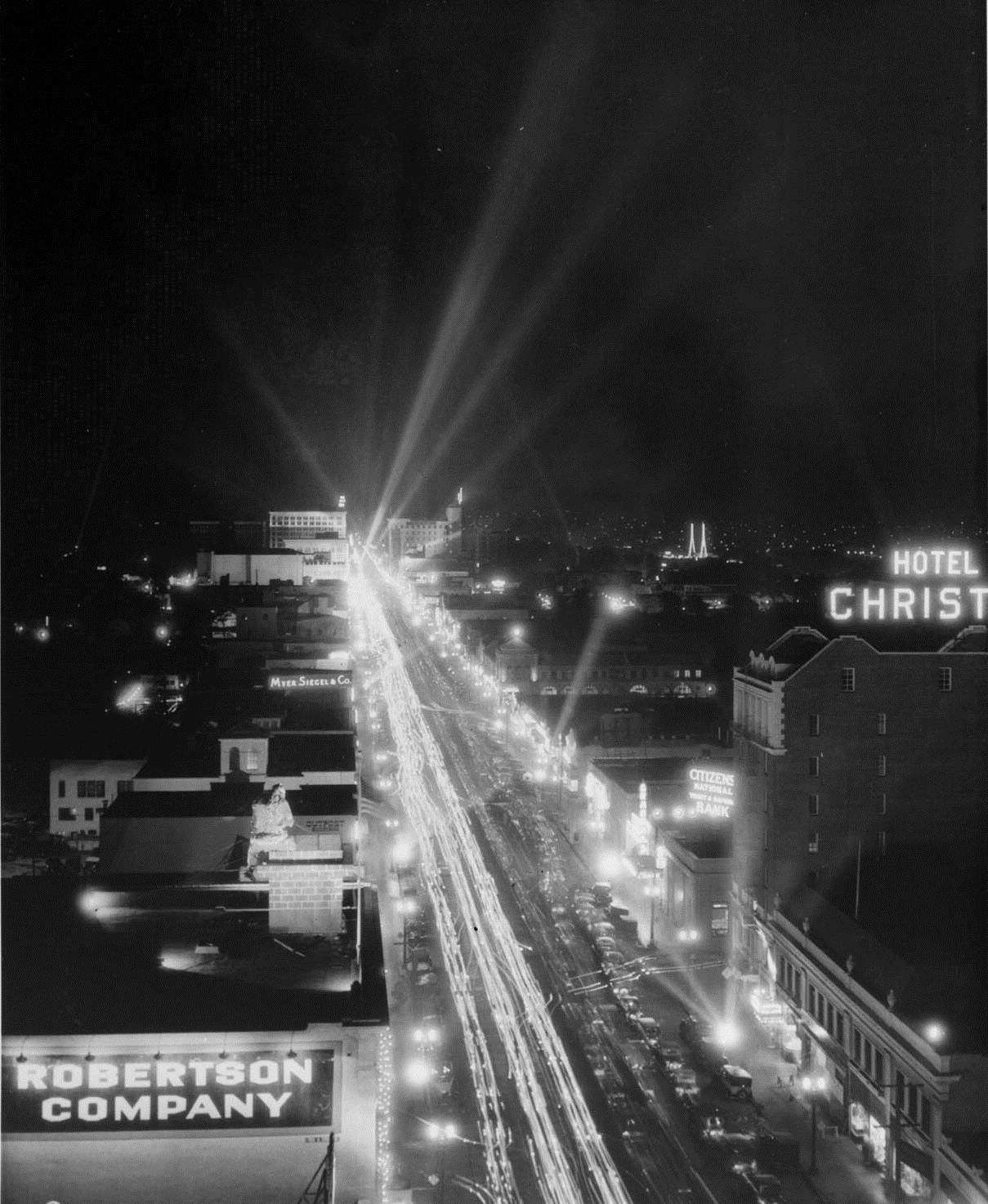 |
|
| (1930s)*^^ - Birds eye view of Hollywood Boulevard at night, looking east from Highland Avenue. The Hotel Christie can be seen to the lower right. |
 |
|
| (1937)* - The neon lights blaze in this night shot of Hollywood Boulevard, which includes the Egyptian Theatre, The Pig 'N Whistle Café, the Hotel Christie, and the Citizens Bank. The double bill on the marquee "Life Begins in College" and "Counsel for Crime" played at the Egyptian the second week of November in 1937. |
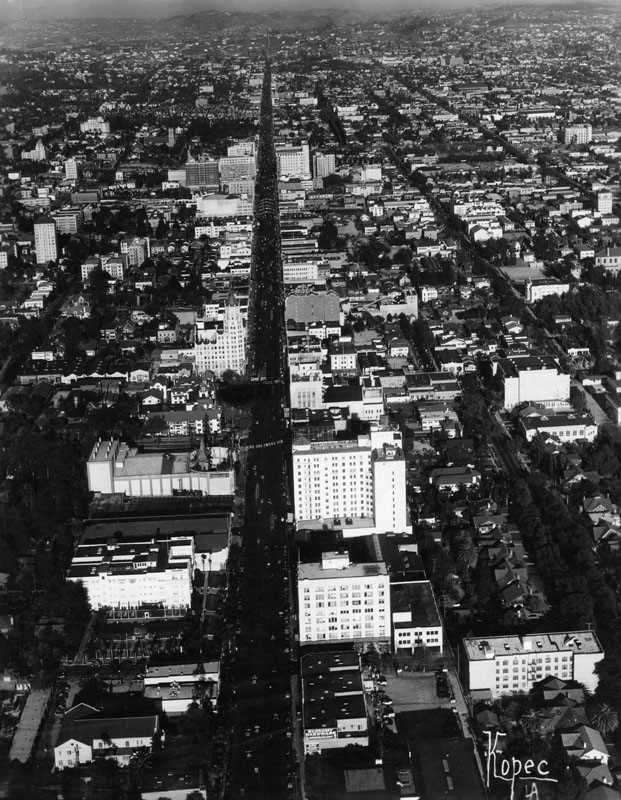 |
|
| (ca. 1930)* - Aerial view of Hollywood Blvd. looking east. Grauman's Chinese Theatre, left, has a sign draped over the Boulevard that reads 'Big Shows Are Back'. Across from Grauman's is the Roosevelt Hotel. A few blocks up on the same side is the Hotel Christie. |
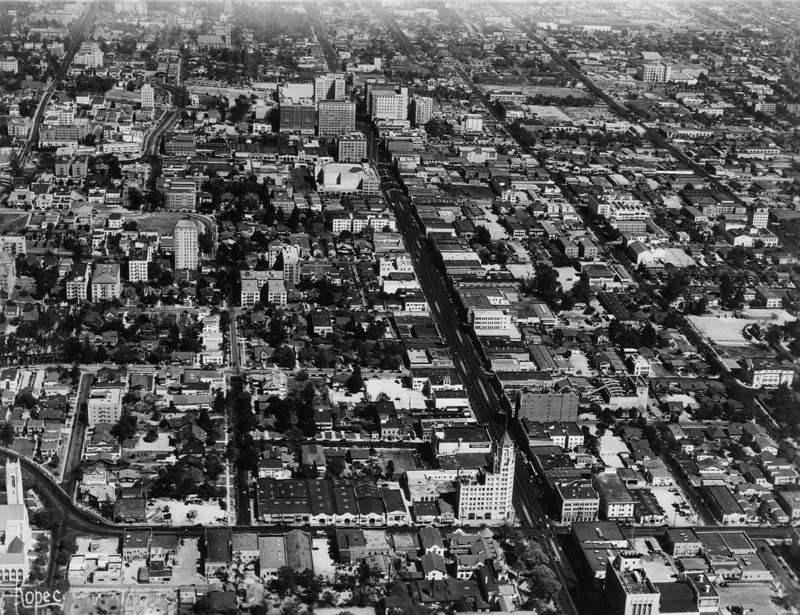 |
|
| (ca. 1930)* - Aerial view of Hollywood Boulevard looking east. The intersection of Highland Avenue and Hollywood Blvd. is at lower right, with the First National Bank Building standing at the northeast corner. A sign, 'Hotel Christie' identifies the plain, brick facade of the hotel, also at lower right. |
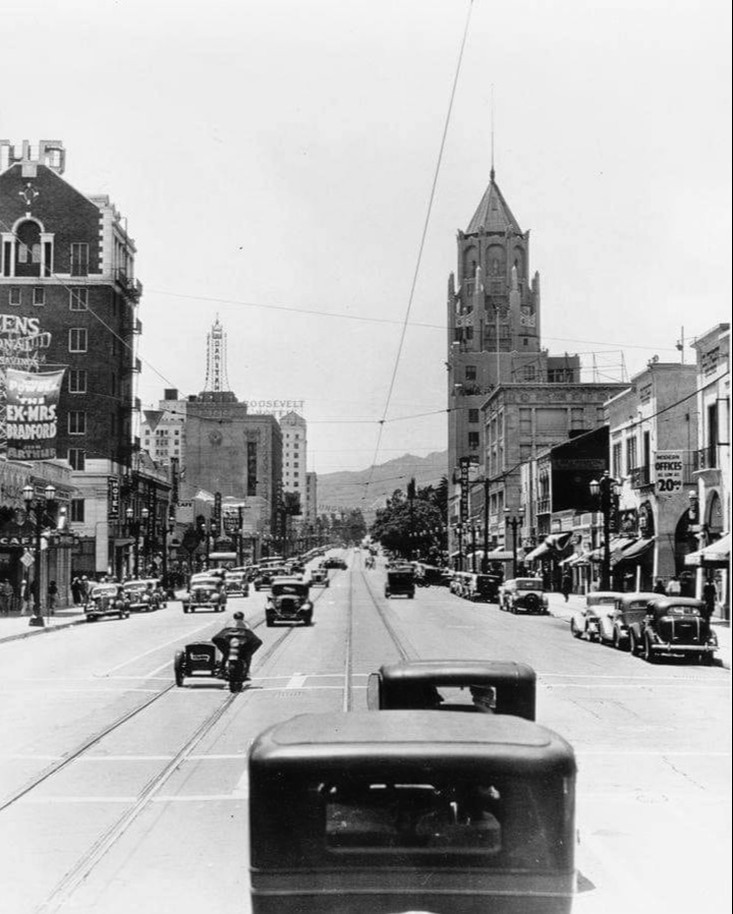 |
|
| (1936)* - Looking west on Hollywood Blvd towards Highland Ave. |
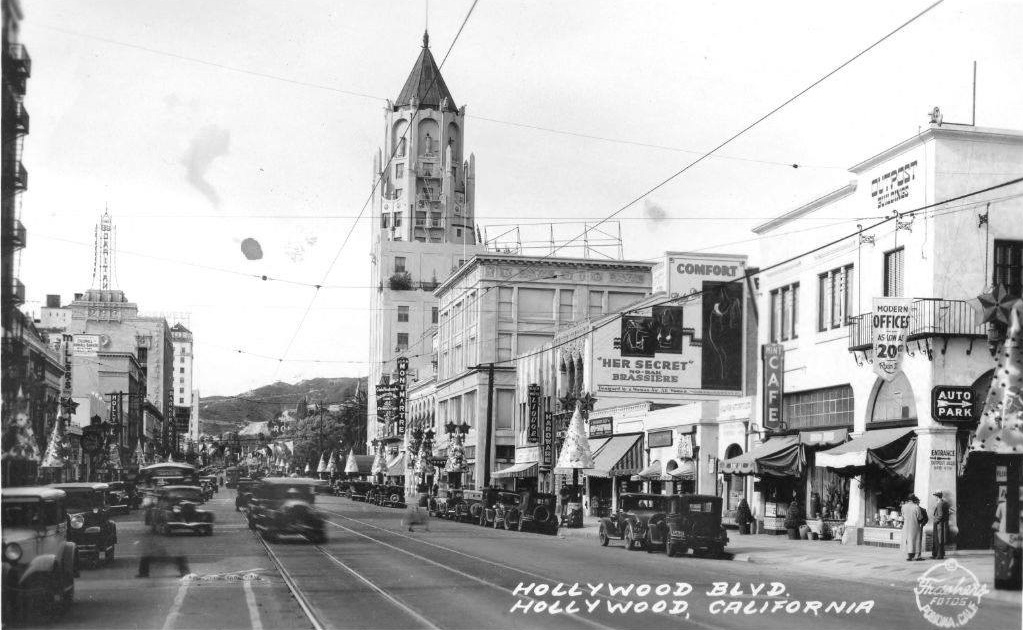 |
|
| (1930s)* - Postcard view looing west on Hollywood Boulevard during the Christmas season with the prominent First National Bank Building standing tall on the northeast corner of Hollywood and Highland. Large sign at center-right is for brassieres and reads: “Her Secret”. |
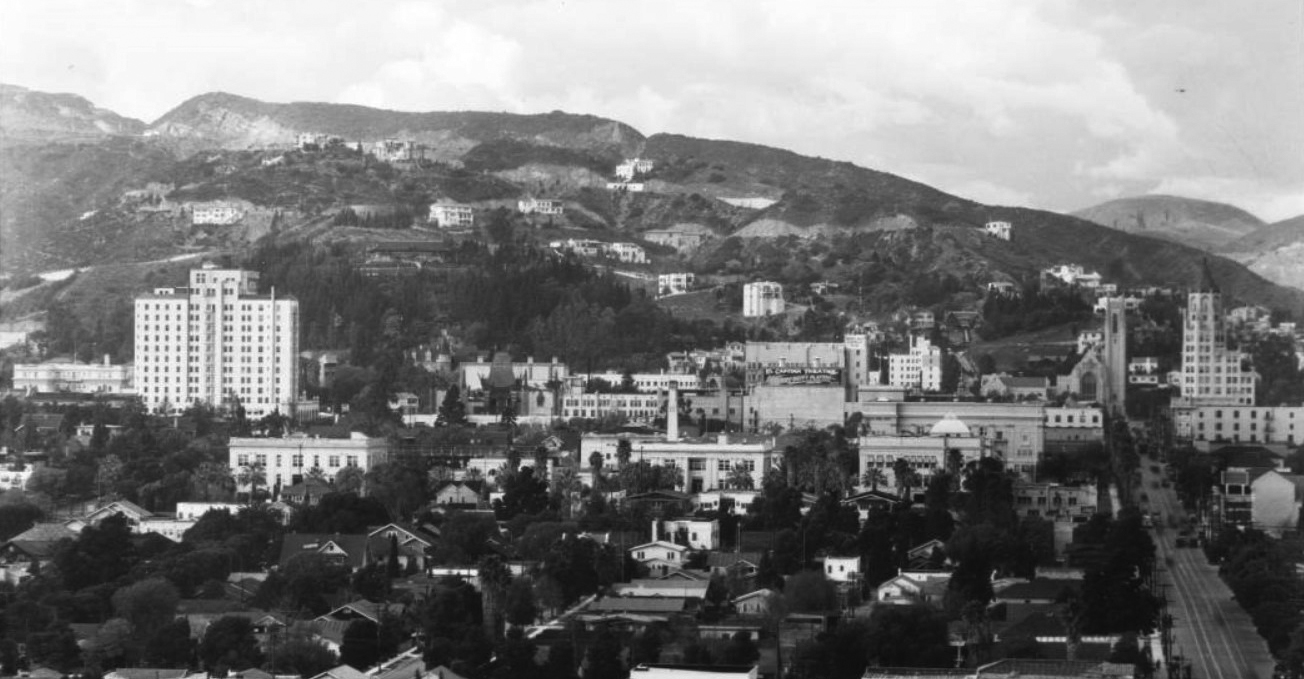 |
|
| (ca. 1930)^ – Panoramic view of Hollywood looking north showing a great number of well known buildings including (L to R): Roosevelt Hotel, Grauman's Chinese Theatre, El Capitan Theatre, Hollywood United Methodist Church, and the First National Bank Building. Hollywood High School can also be seen at lower-center of photo. Highland Avenue runs up to the Hollywood Hills on the right. |
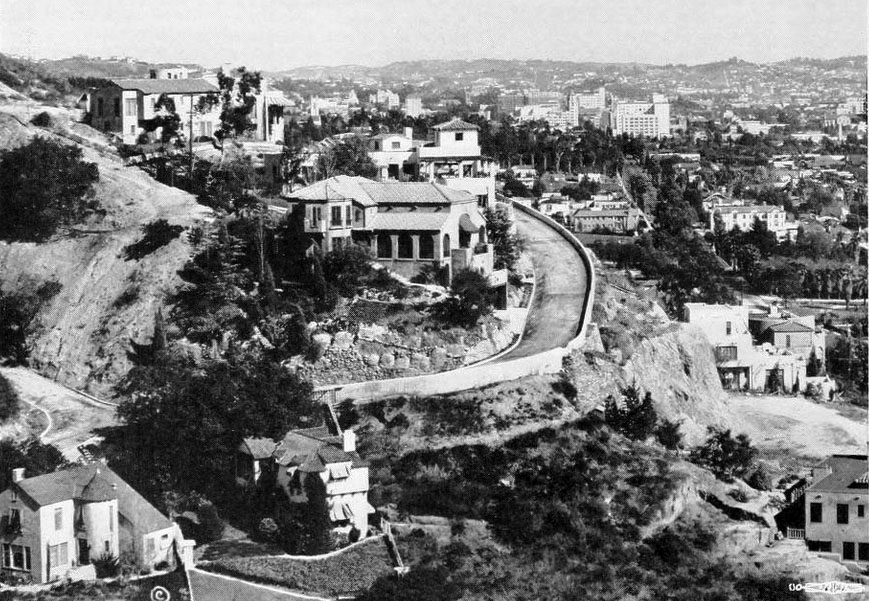 |
|
| (ca. 1930s)* – View looking southeast from the Hollywood Hills as seen from Fareholm Drive just above Laurel Canyon and Hollywood boulevards. The First National Bank Building Tower (N/E corner of Hollywood and Highland) and Roosevelt Hotel can be seen at upper-right. |
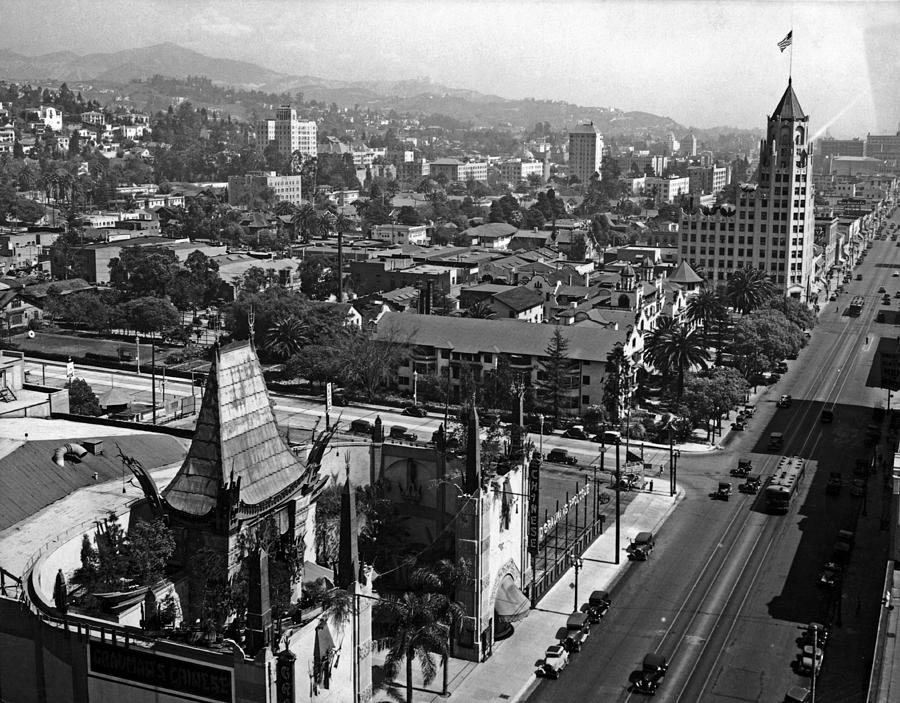 |
|
| (ca. 1930)* - View of Hollywood Boulevard looking east from the top of the Roosevelt Hotel. Grauman's Chinese Theatre is seen across the street (lower left). In the distance, the tallest building is the First National Bank. |
Historical Notes The First National Bank Building was designed in Art Deco/Gothic style by architects Meyer and Holler and built in 1927. It is located on the northeast corner of Hollywood Blvd. and Highland Avenue. Grauman's Chinese Theatre was also designed by Meyer and Holler and it too was built in 1927. The theater is located at 6925 Hollywood Boulevard.* |
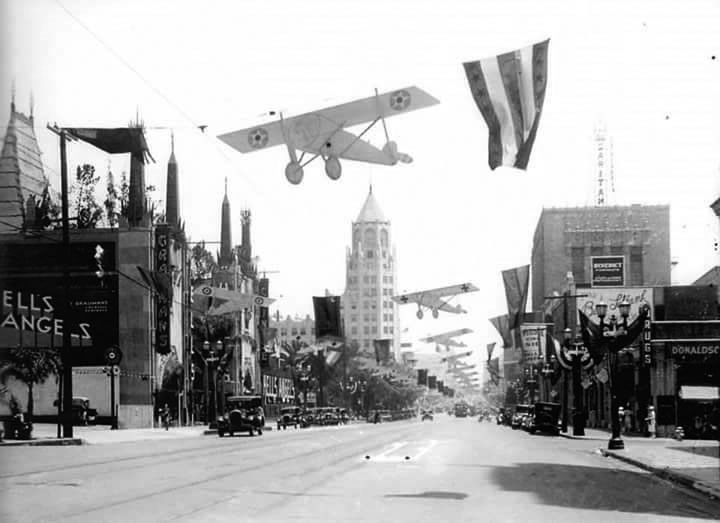 |
|
| (1930)* – Street level view looking east showing airplane banners over Hollywood Boulevard, promoting the movie Hell’s Angels playing at the Grauman’s Chinese Theatre (seen at left). |
Historical Notes Hell's Angels is an American epic aviation war film, directed and produced by Howard Hughes, that stars Ben Lyon, James Hall, and Jean Harlow. The film, which was written by Harry Behn and Howard Estabrook, was released by United Artists. Originally shot as a silent film, Hughes retooled Hell's Angels over a lengthy gestation period. Most of the film is in black-and-white, but there is one color sequence, the only color footage of Harlow's career. Controversy during the Hell's Angels production contributed to the film's notoriety, including the accidental deaths of several pilots, an inflated budget, a lawsuit against a competitor (The Dawn Patrol), and repeated postponements of the release date. Hell's Angels was one of the highest-grossing films of the early sound era, but despite this it still failed to recover its exorbitant production costs. It is now hailed as one of the screen's first sound action films. *^ |
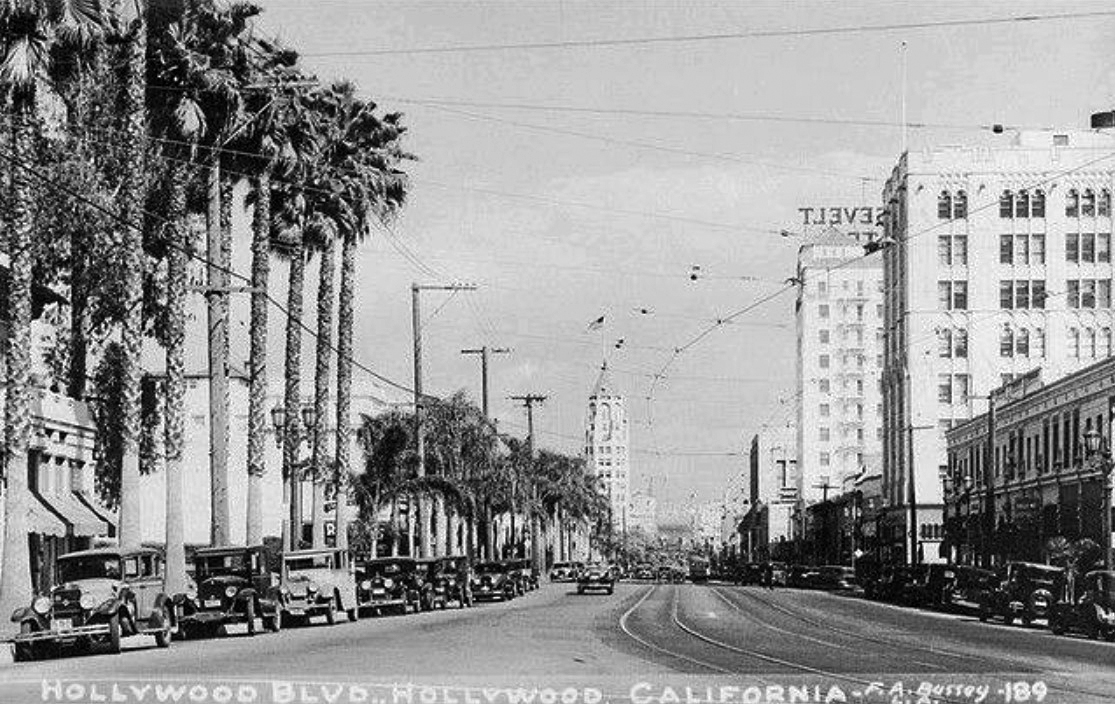 |
|
| (1930)##^* – Postcard view looking east on Hollywood Boulevard from La Brea Avenue. |
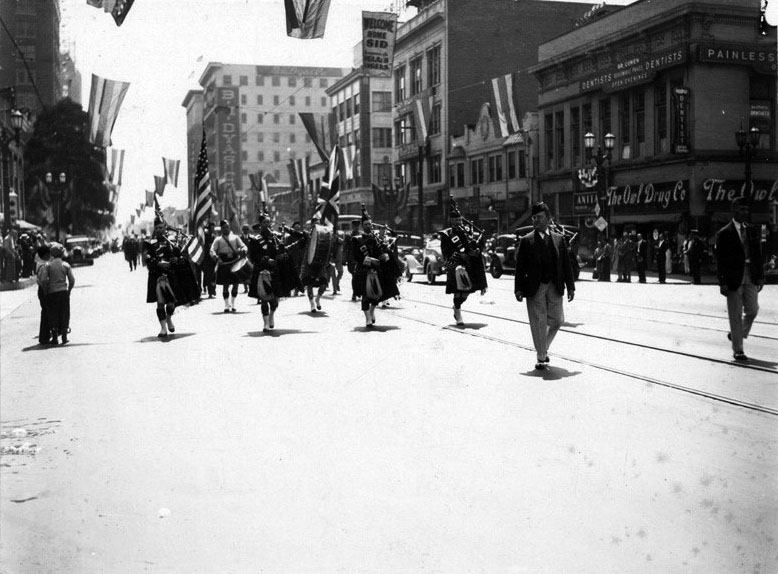 |
|
| (1930)^^^ - View looking east on Hollywood Boulevard showing a marching band with kilts celebrating Decoration Day. In the background can be seen the B. H. Dyas Building on the corner of Hollywood & Vine. |
Historical Notes Decoration Day is the former name of the Memorial Day holiday. Memorial Day began as "Decoration Day" in the immediate aftermath of the American Civil War. It was a tradition initiated by General John A. Logan, leader of an organization for Northern Civil War veterans.*^ |
Calmos Auto Station
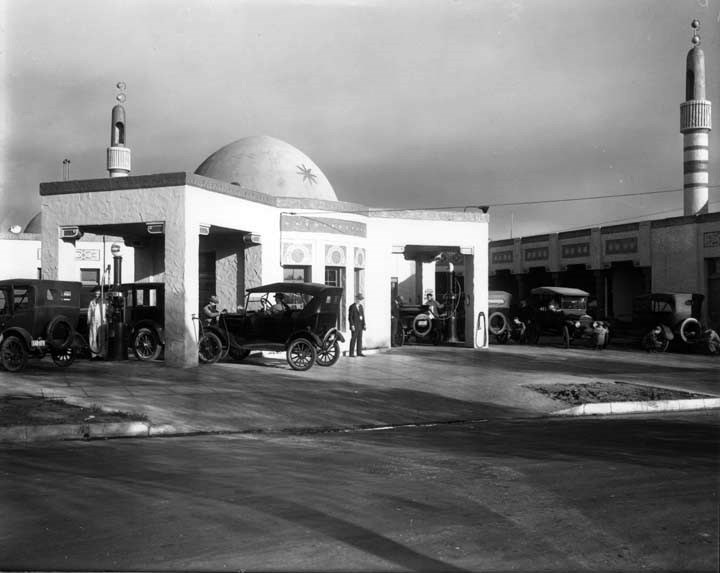 |
|
| (ca. 1924)^^^ – View showing the Mosque-like Calmos Auto Service Station located on the southeast corner of Hollywood Boulevard and Alexandria Avenue. |
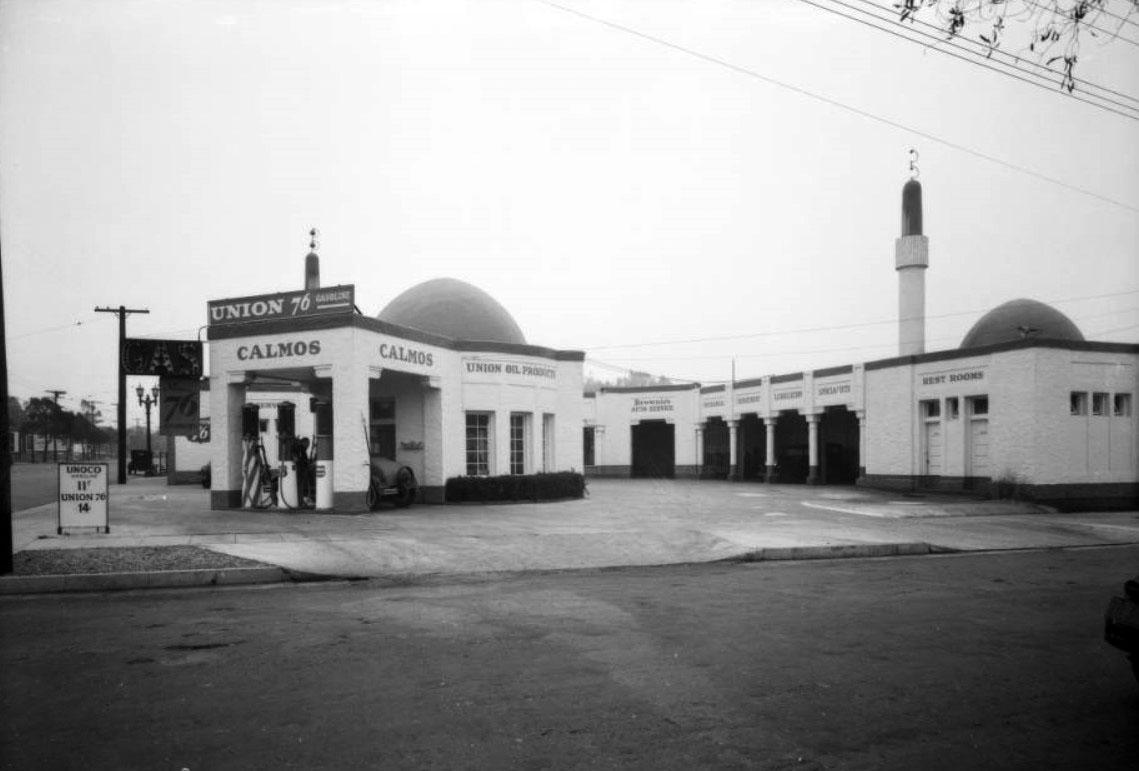 |
|
| (ca. 1932)^^ - View looking at the southeast corner of Hollywood Boulevard and Alexandria Avenue showing a Union 76 Station with rooftop domes and minarets. |
Historical Notes Click HERE to see more Early Views of LA Gas Stations. |
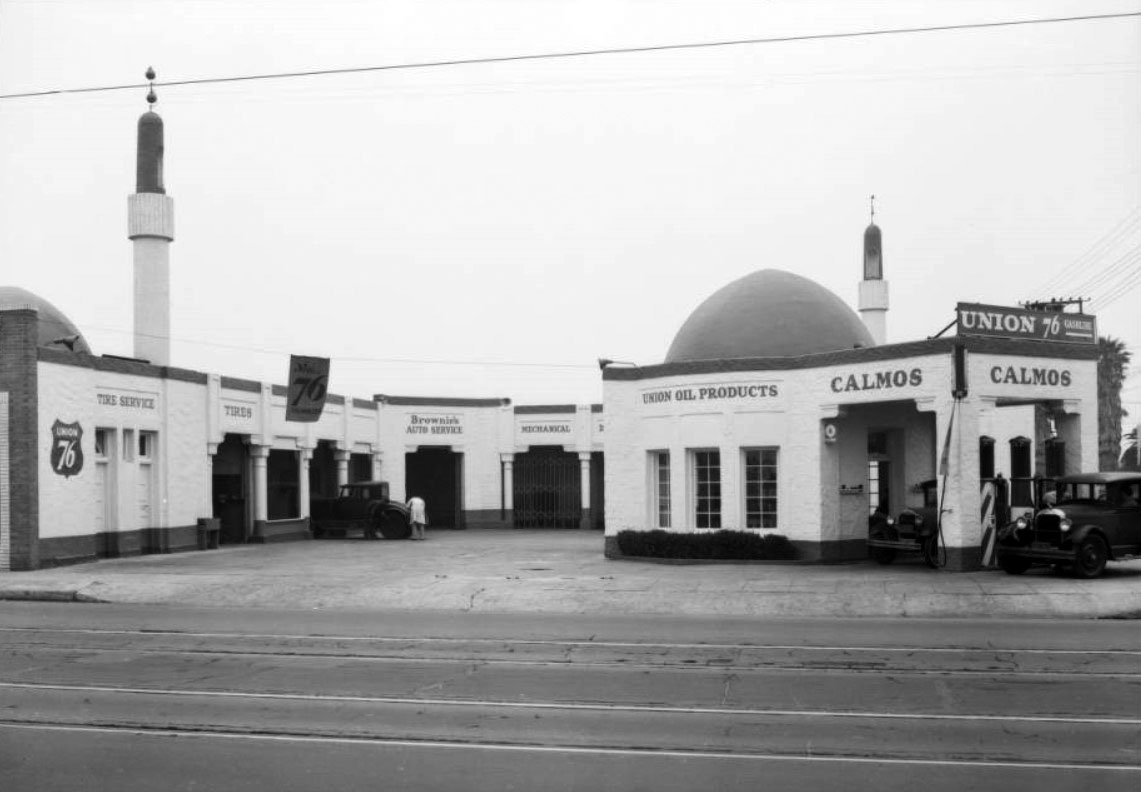 |
|
| (ca. 1932)^ – View showing the Calmos Union 76 Service Station complete with three domes and two minarets located on the S/E corner of North Alexandria Ave and Hollywood Blvd. Note the tracks on Hollywood Boulevard. |
Historical Notes Although the gas station has been razed to make room for a strip mall, the two minarets seen above are still standing today. |
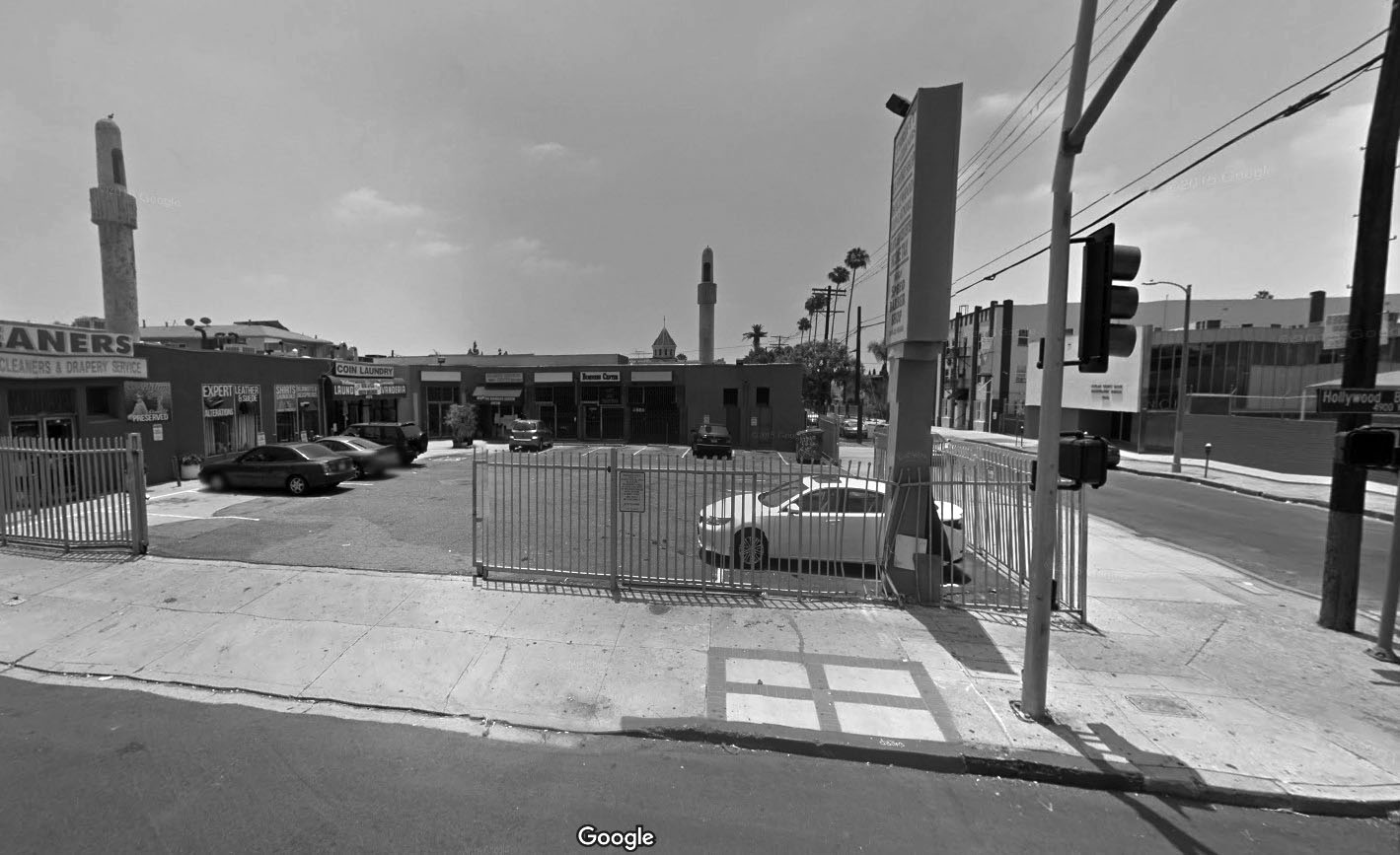 |
|
| (2015)* – Google Street View showing the strip mall at the southeast corner of Hollywood Blvd and Alexandria Ave. Still standing are the two minarets, once part of the original Union 76 Station that use to occupy the lot. |
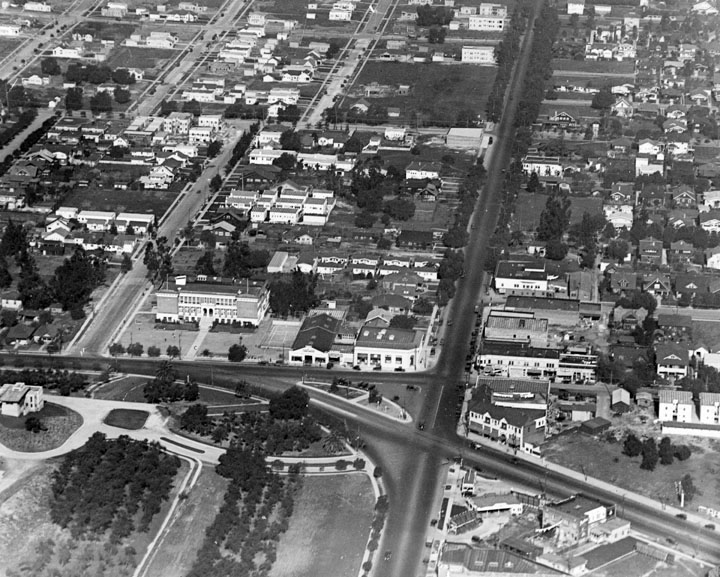 |
|
| (1930)* - Aerial view of Hollywood Blvd. and Vermont. Vermont runs up and down (north/south) in this picture, while Hollywood Blvd. comes in from the left and veers down to the right corner of photo. The extension of Hollywood on the east side of Vermont is Prospect Ave. In the lower left is Barnsdall Art Park, home of the Frank Lloyd Wright designed Hollyhock House. Los Feliz Elementary School is at center-left. |
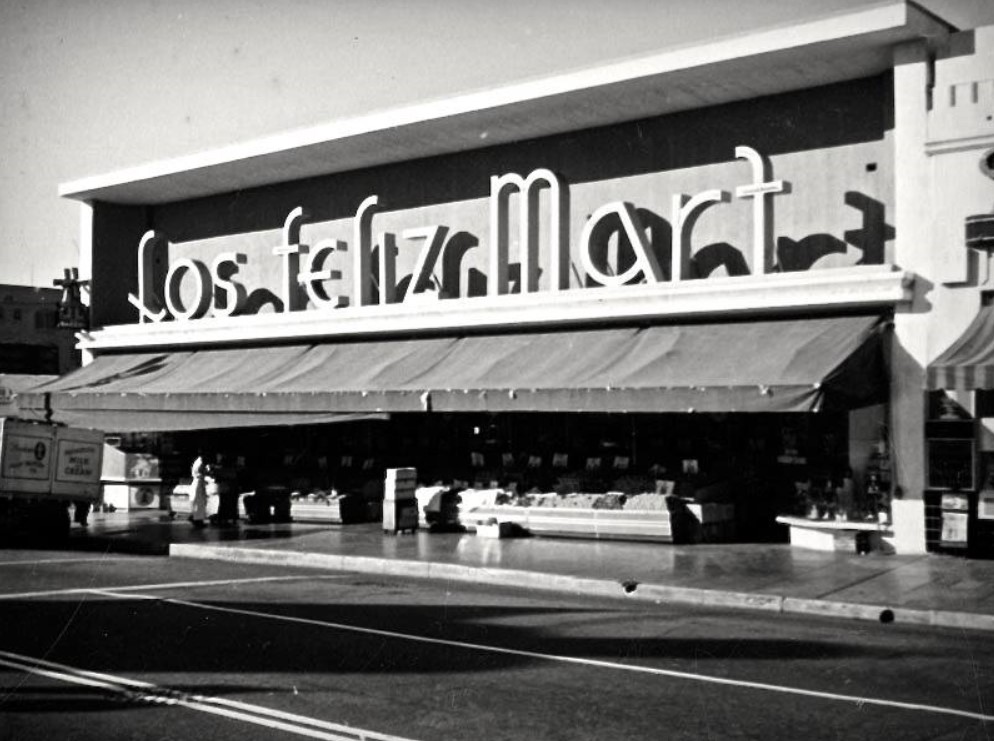 |
|
| (1930s)#**# - View of the Los Feliz Mart located on the west side of Vermont Ave south of Franklin Ave, at 1825 N. Vermont Ave. Today, the U.S. Post Office is located on this site. |
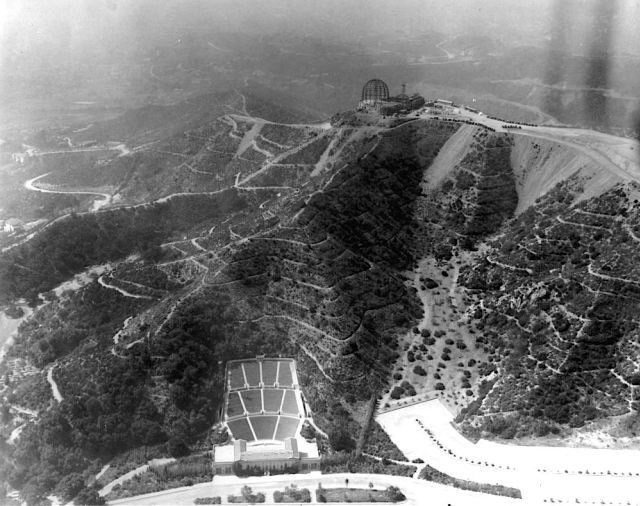 |
|
| (1930s)^ – Aerial view looking down at the Greek Theatre with the still yet to be completed Griffith Observatory standing on a hill high above it. |
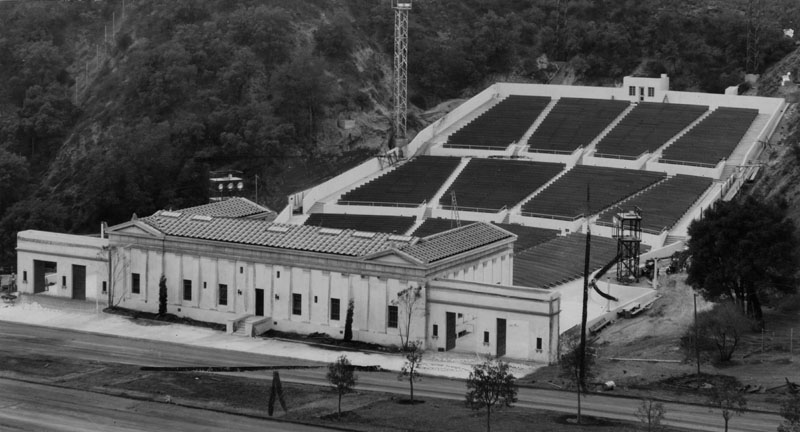 |
|
| (ca. 1930)* - Exterior view of the Greek Theatre located at 2700 N. Vermont Avenue, Hollywood. The outdoor seating slopes up the hill. |
Historical Notes The Greek Theatre, located in Griffith Park, was built in 1929. It was designed by architect Frederick Heath to resemble a Greek temple.*^ |
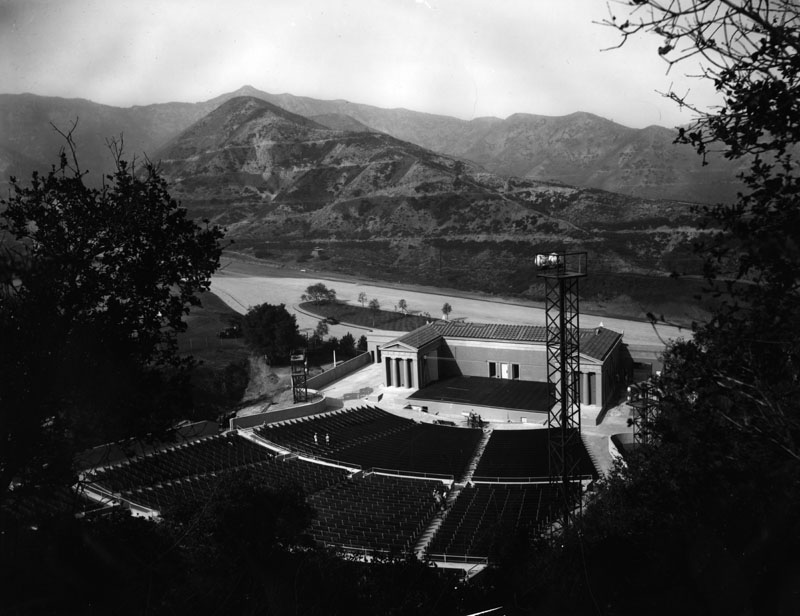 |
|
| (ca. 1930)* - Aerial view of the Greek Theatre. The bare Hollywood Hills can be seen in the background. |
Historical Notes The Greek Theatre was paid for with a donation from Griffith J. Griffith, who also donated the land for the park, named in his honor.*^ |
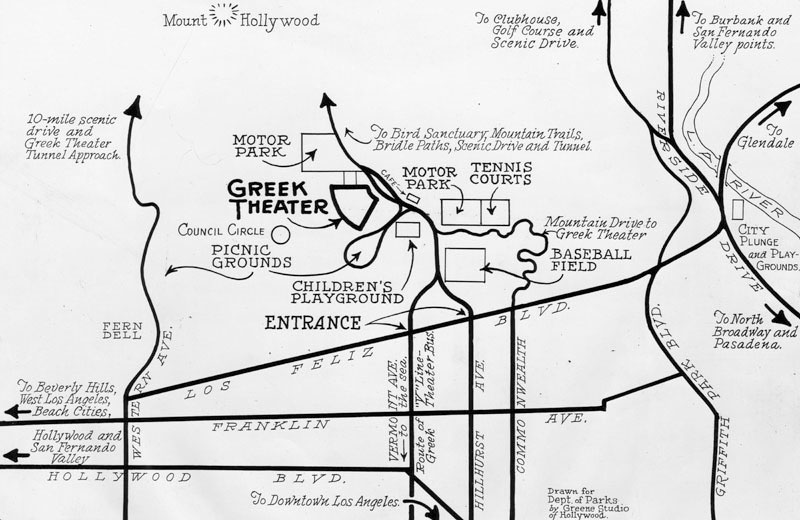 |
|
| (1930)* - Shown is the first map to picture the location of the new $250,000 Greek Theatre in Griffith Park, issued by the Department of Parks on the eve of the gala inaugural attraction of the municipal playhouse on September 25, 1930. |
Historical Notes The Greek Theatre’s opening performance was a double bill comprised of the grand operas, "Cavalleria Rusticana" and "Pagliacci." The map indicates principal highways and the route of the special bus service, which connects on transfers with the yellow "V" line and intersecting red cars and Sunset busses. Parking areas adjoining and near the theater with accommodations for 3,250 automobiles, also are shown, as well as location of playgrounds, pool, picnic grounds and other centers of diversion which are stressed by the park board as constituting the Greek Theatre sector of Griffith Park as an ideal week-end rendezvous.* |
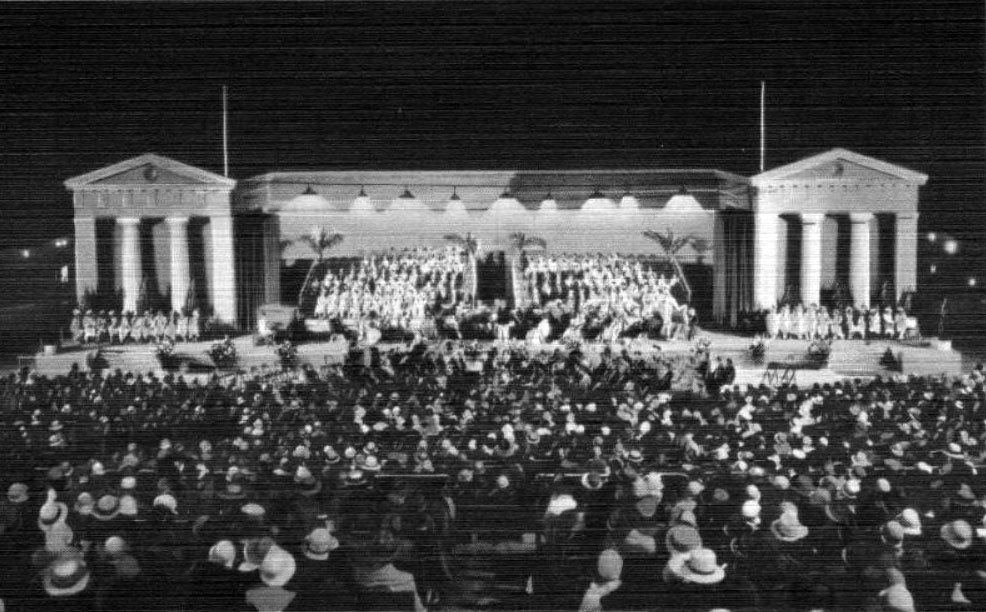 |
|
| (ca. 1930)#^*^ – Postcard view showing a performance at the Greek Theatre in Griffith Park. |
Historical Notes The amphitheatre had a limited concert season during its first two decades and during World War II it was used as a barracks. In 1947, however, the theatre was used for the Broadway show Anything Goes for two weeks. During the 1950s, under the management of James Doolittle, a concert promoter, the amphitheater underwent a series of renovations that allowed the theater to compete with rival 1950s’ theaters.*^ |
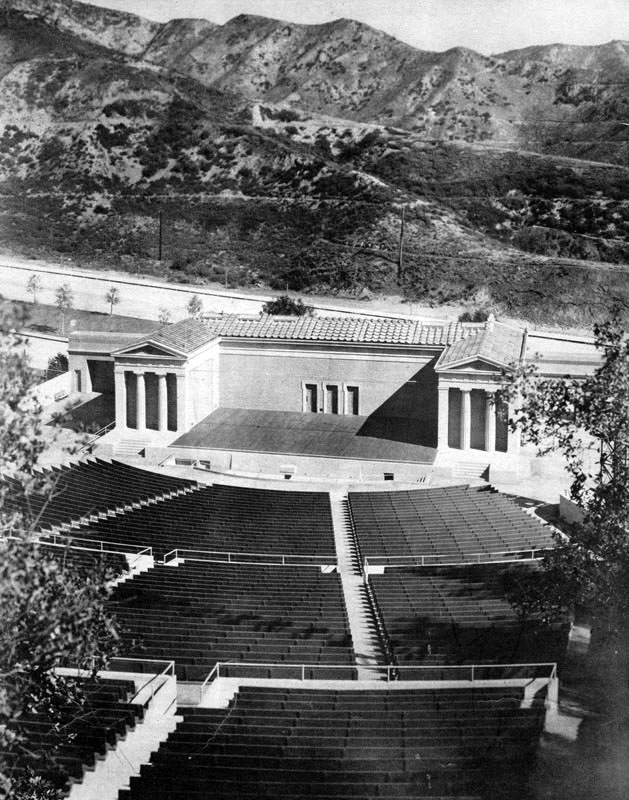 |
|
| (1931)* - Caption reads: View of the Griffith Park Greek Theatre. Theatre located in Vermont Canyon is the newest addition to Los Angeles' attractions and a very gem of outdoor playhouse. A gift to the city from the late Col. Griffith J. Griffith, it is the only municipally owned Greek theatre in America. Costing $205,000 and designed to accomodate all types of stage offering, Los Angeles is looking forward eagerly to some novel and inspiring productions during the coming summer months. |
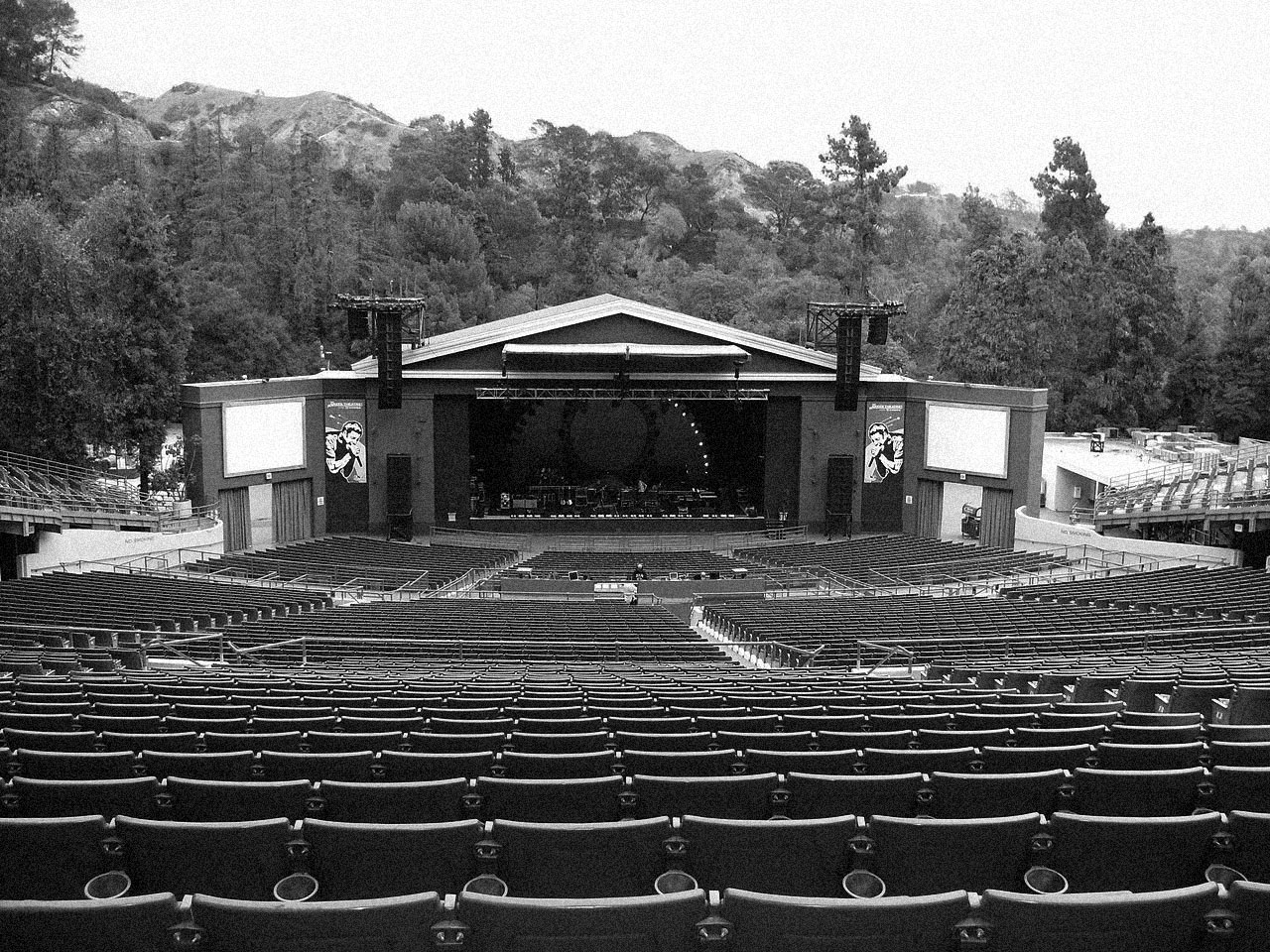 |
|
| (2007)*^ – View of the Greek Theatre as it appears today. |
Historical Notes Although it is owned by the City of Los Angeles, the Greek Theatre is managed, operated and promoted by the Nederlander Organization. The theatre currently has a seating capacity of 5,700.*^ |
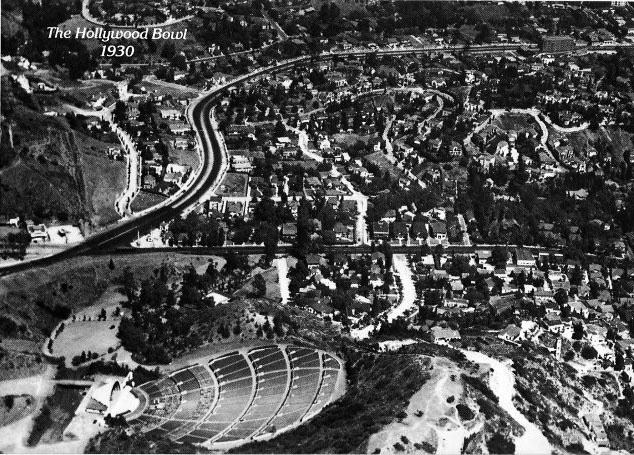 |
|
| (1930)#^ - Aerial view of the Hollywood Bowl looking east. The neighborhood of Whitley Heights is at the center of photo. The serpentine Cahuenga Boulevard can be seen as it extends out of Cahuenga Pass (middle-left) toward Hollywood (upper-right). |
Historical Notes Whitley Heights is a residential neighborhood in the Hollywood district named for Hobart Johnstone "HJ" Whitley, the "Father of Hollywood". Whitley Heights was added to the National Register of Historic Places in 1982. In 1918, HJ Whitley commissioned architect A.S. Barnes to design Whitley Heights as a Mediterranean-style village on the steep hillsides above Hollywood Boulevard, and it became the first celebrity community. The neighborhood is roughly bordered on the north and east by Cahuenga Boulevard, on the west by Highland Avenue, and on the south by Franklin Avenue. It overlooks the tourist district of Hollywood, including the Hollywood Walk of Fame and Grauman's Chinese Theatre, and the Hollywood Bowl amphitheater. The neighborhood was bisected and some landmark homes destroyed when U.S. Route 101, a.k.a. the Hollywood Freeway, was built after World War II. Among Whitley Heights' many famous residents have been Rudolph Valentino, Barbara Stanwyck, W.C. Fields, Jean Harlow, Carole Lombard, William Powell, Tyrone Power, Ellen Pompeo, Gloria Swanson, Rosalind Russell, Judy Garland, and Marlene Dietrich.*^ |
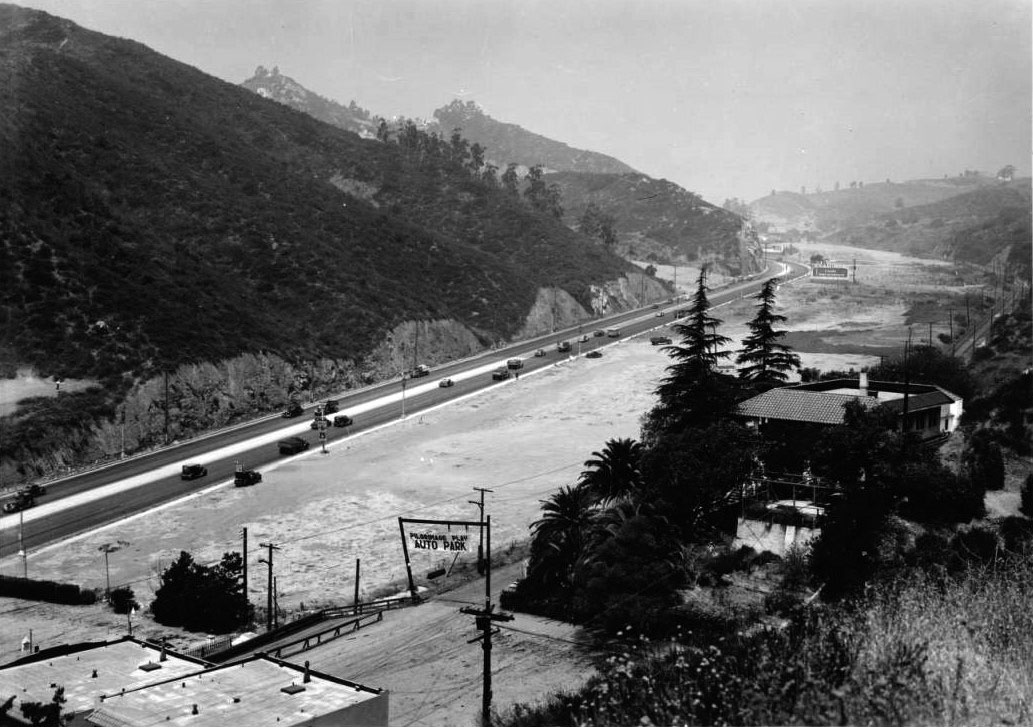 |
|
| (1930s)^^ - View of Cahuenga Pass with the Pilgrimage Play Theatre parking lot in the foreground. Cahuenga runs from the foreground at left towards the San Fernando Valley at upper center-right. The Hollywood Bowl is out of view to the left. |
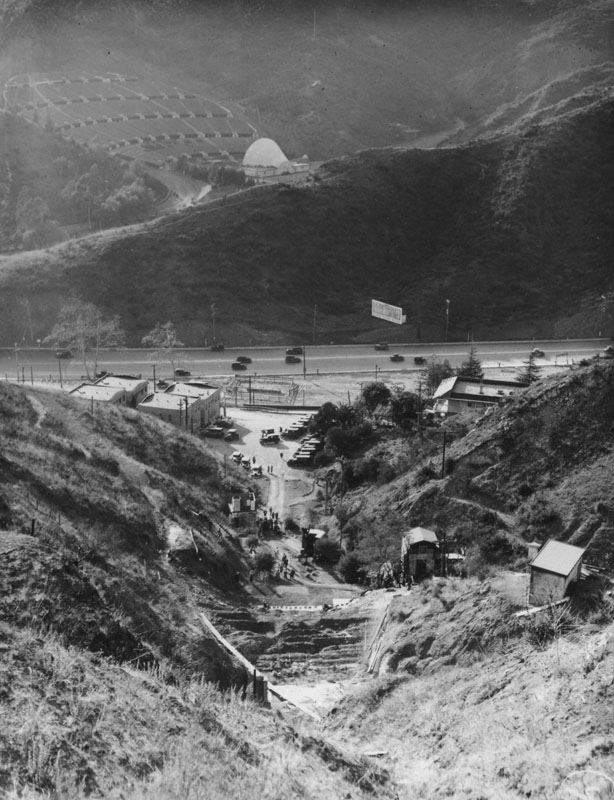 |
|
| (1931)* - Looking down into the construction site of the Pilgrimage Play Amphitheater, revealing the Cahuenga Pass and the Hollywood Bowl in the background. The new theatre will replace the original one that burned down in 1929. |
Historical Notes John Anson Ford Amphitheatre was built in 1920 as the site of The Pilgrimage Play. The author, Christine Wetherill Stevenson, believed the rugged beauty of the Cahuenga Pass would provide a dramatic outdoor setting for the play. Together with Mrs. Chauncey D. Clark, she purchased this land along with that on which the Hollywood Bowl now sits. A wooden, outdoor amphitheater was built on this site and the play was performed by noted actors every summer from 1920 to 1929, until the original structure was destroyed by a brush fire in October 1929.*^ |
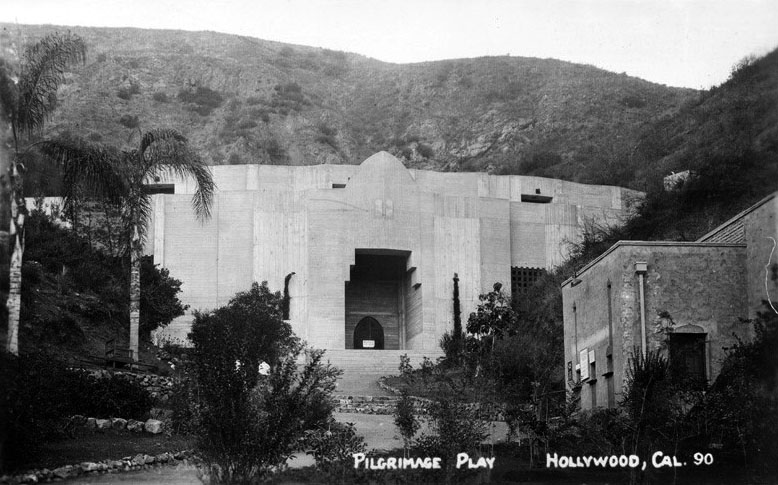 |
|
| (ca. 1931)^^^ - Postcard view of the front entrance to the Pilgrimage Theatre in Hollywood. |
Historical Notes A new Pilgrimage Theatre was built on the same site as the original and opened in 1931. The new theatre was constructed of poured concrete and designed in the style of ancient Judaic architecture to resemble the gates of Jerusalem. |
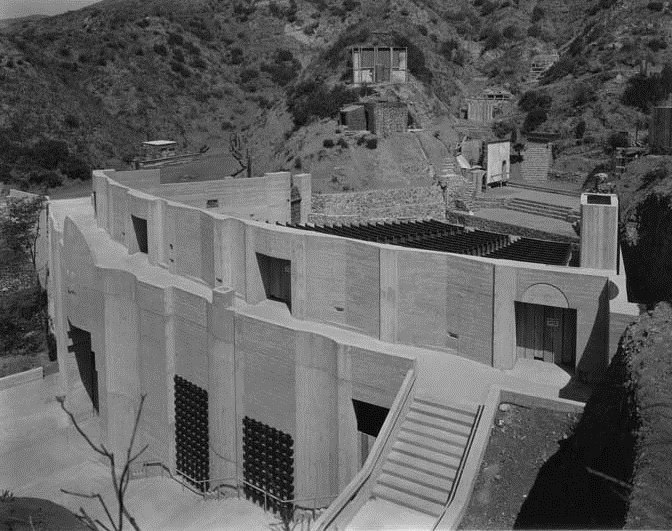 |
|
| (ca. 1931)^^^ - Looking down into the Pilgrimage Play Amphitheater (renamed the John Anson Ford Theatre in the early 1970s) revealing some of the biblical-like structures on the hillside. |
Historical Notes The Pilgrimage Play Amphitheater resembled the architecture of the Holy Land for the purposes of the play performed there. The religious-themed Pilgrimage Play, written by Christine Whetherill Stevenson, was performed every summer between 1920 to 1941.* |
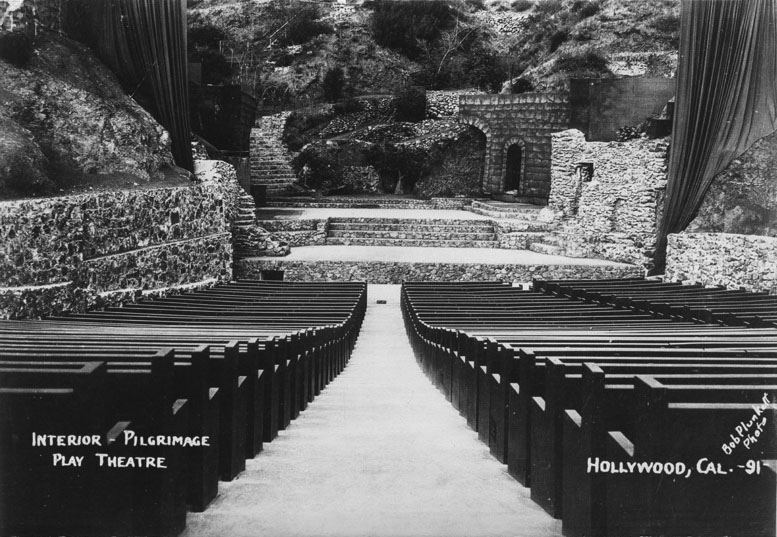 |
|
| (ca. 1931)* - Postcard view of the Pilgrimage Play Theatre seating and stage. |
Historical Notes During WWII the theater was deeded to Los Angeles County and converted into dormitories for servicemen. After the war, the play resumed until 1964, at which time it was legally ordered to close due to its religious content.* |
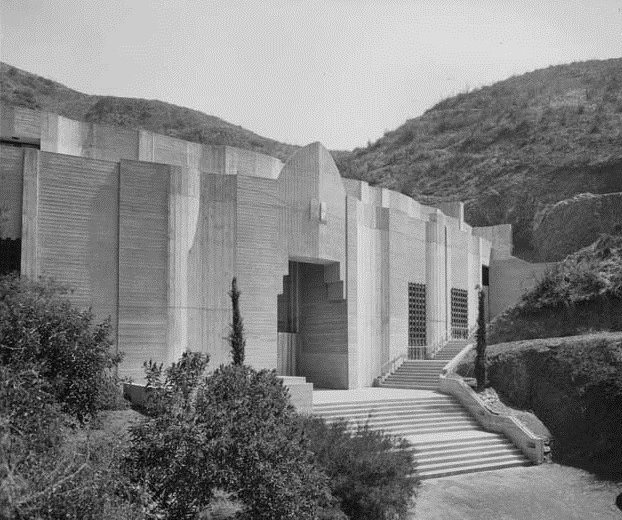 |
|
| (ca. 1931)^^^ - Close-up view of the front entrance to the Pilgrimage Play Theatre. |
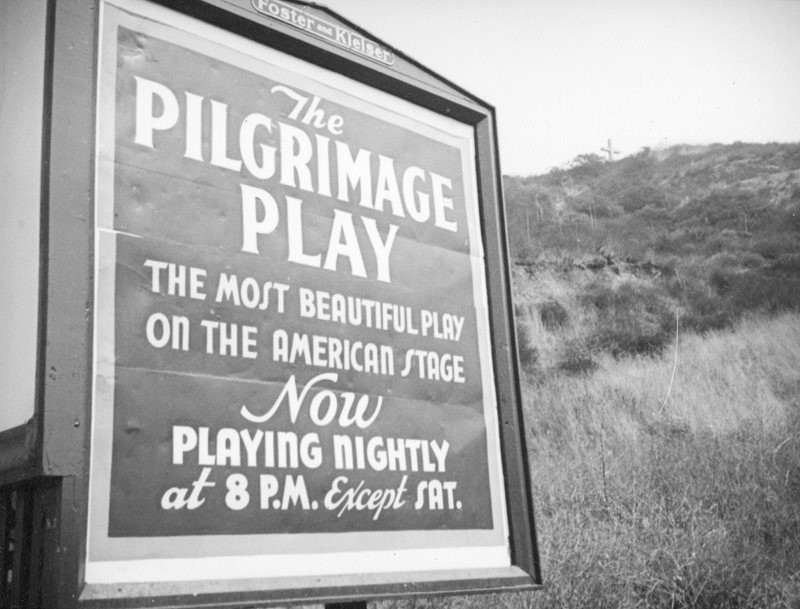 |
|
| (ca. 1937)* - View showing a Foster and Kleiser billboard for the Pilgrimage Play outside the Pilgrimage Theatre, later the John Anson Ford Amphitheatre (2580 Cahuenga Boulevard). |
Historical Notes In 1941, the land was deeded to the County of Los Angeles. The Pilgrimage Play continued to be presented until a lawsuit in 1964 forced its closure because of its religious nature. In 1976, the Pilgrimage Theatre was renamed the John Anson Ford Theatre in honor of the late L.A. County Supervisor's significant support of the arts. John Anson Ford (1883–1983) helped found the L.A. County Arts Commission, encouraged the Board of Supervisors to support the building of the Music Center and led the County's acquisition of Descanso Gardens, among many other achievements.*^ |
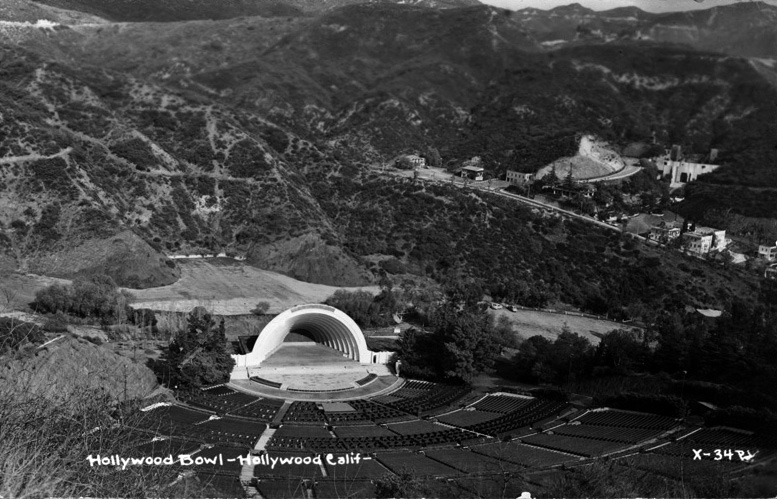 |
|
| (ca. 1940)^^^ - View looking north showing the Hollywood Bowl and also the Pilgrimage Play Theatre located on the other side of Cahuenga Pass (right-center of photo). |
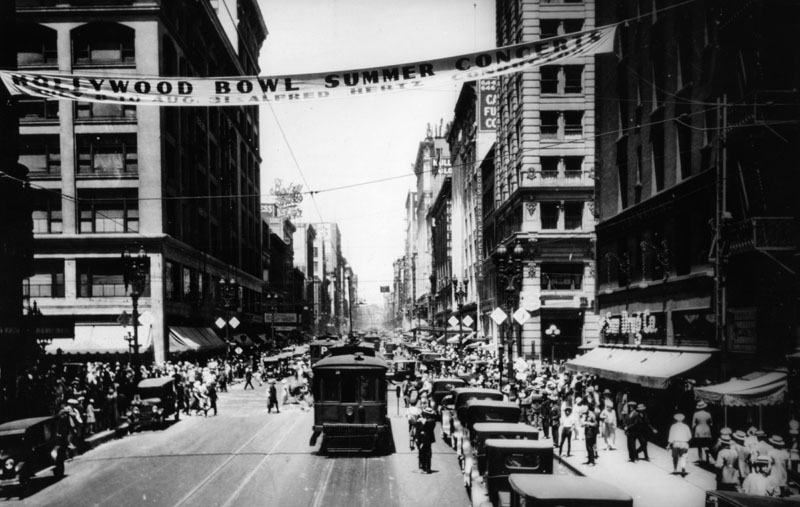 |
|
| (1931)* - A banner advertising a Hollywood Bowl summer concert with conductor Alfred Hertz stretches over Broadway packed with pedestrians, streetcars and traffic. Boos Bros. Cafeteria and the Orpheum Theatre are in the middle, on the right. |
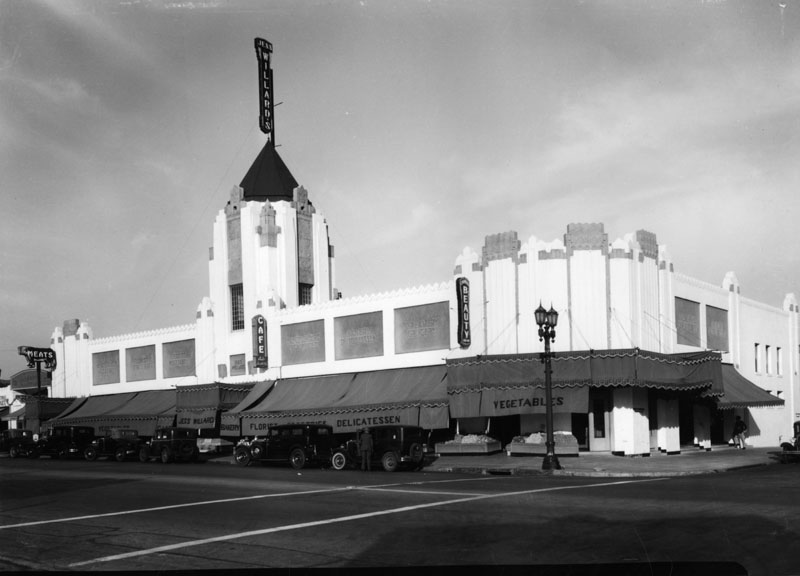 |
|
| (1931)* - Jess Willard's Market in Hollywood at 1334 Vine Street on October 30, 1931. It was in an impressive Art Deco building and included a bakery, delicatessen, cafe and beauty shop. It was oriented toward pedestrian traffic, with no parking lot. |
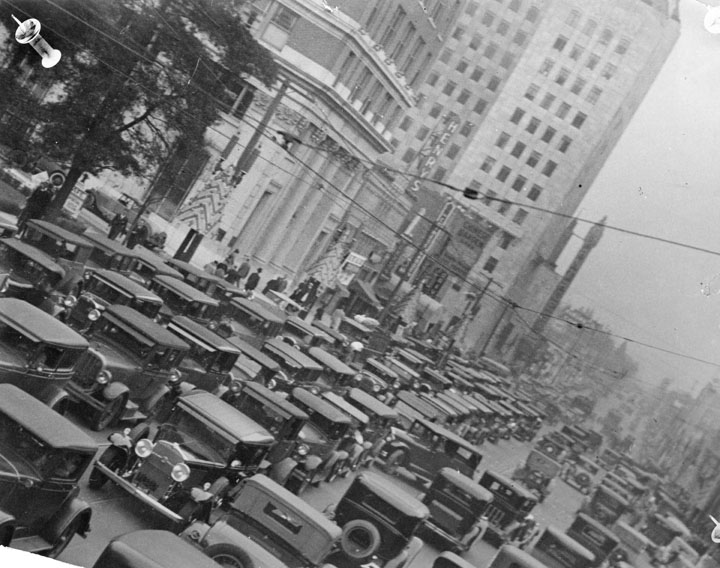 |
|
| (1932)* - Hollywood Boulevard is a sea of cars as far as the eye can see. In the middle ground the marquee of the Pantages Theatre can just be identified. The view is to the east. On the light post are Christmas decorations. |
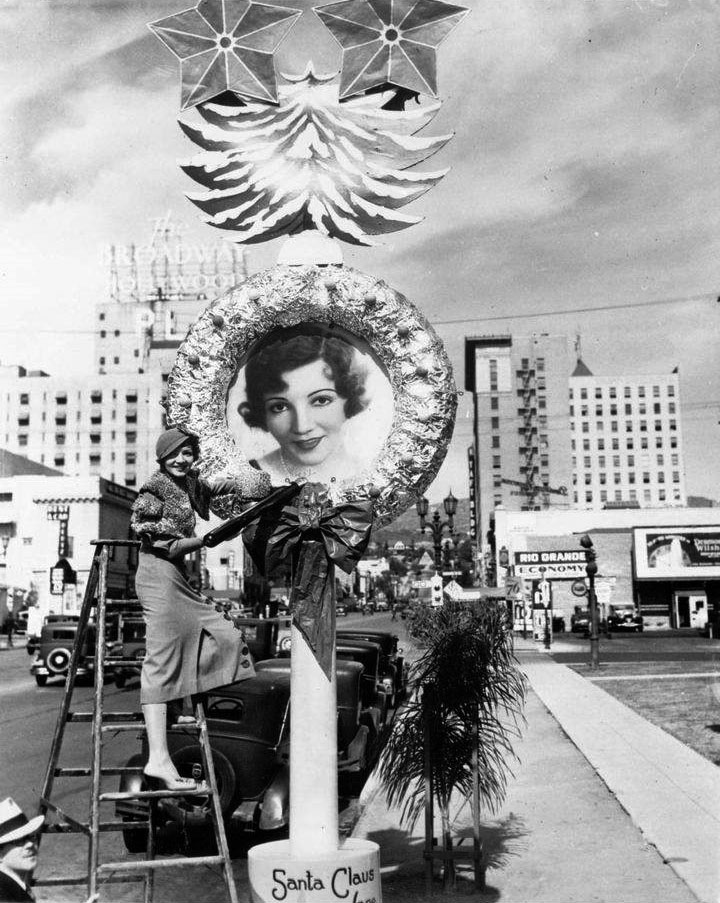 |
|
| (1932)* – Claudette Colbert on a step ladder inspects a large photograph of herself surrounded by a Christmas wreath. In the background are the Mirror Theater at 1615 Vine Street and the Taft Building at 1680 Vine Street. In the upper-left is the Broadway-Hollywood Building located at the corner of Hollywood and Vine. |
Historical Notes Claudette Colbert was a French-born American actress, and a leading lady for two decades. Colbert began her career in Broadway productions during the 1920s, progressing to film with the advent of talking pictures. Initially associated with Paramount Pictures, Colbert later gradually shifted to working as a freelance actor. She won the Academy Award for Best Actress in It Happened One Night, and also received Academy Award nominations for Private Worlds and Since You Went Away. With her round apple-face, Colbert was known as an expert screwball comedienne, but her dramatic range enabled her to easily encompass melodrama and to play characters ranging from vamps to housewives. During her successful career, Colbert starred in more than sixty movies. She was the industry's biggest box-office star in 1938 and 1942. In the 1930s, Colbert alternated between romantic comedies and dramas, and found success in both: She Married Her Boss (1935) with Melvyn Douglas; The Gilded Lily (1935) and The Bride Comes Home (1935), both with Fred MacMurray; Under Two Flags (1936) with Ronald Colman; Zaza (1939) with Herbert Marshall; Midnight (1939) with Don Ameche; and It's a Wonderful World (1939) with James Stewart.*^ |
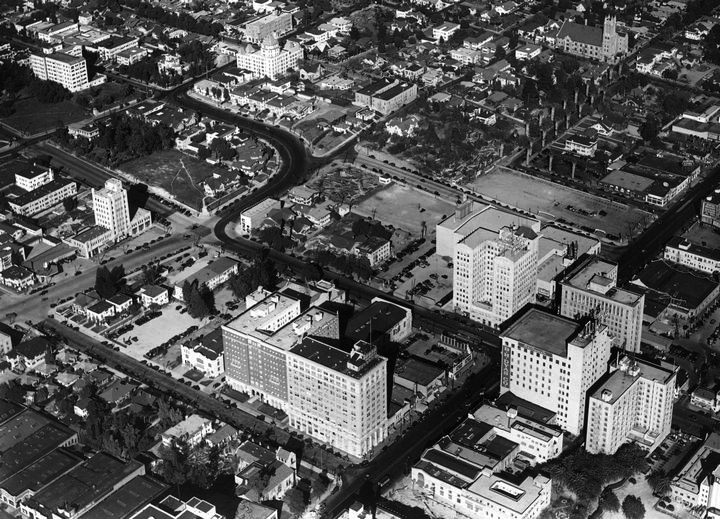 |
|
| (1931)* – Aerial view looking northeast from above Hollywood Boulevard and Ivar Avenue (lower-center). The curved road at upper center-left is where Argyle turns into Yucca Street. |
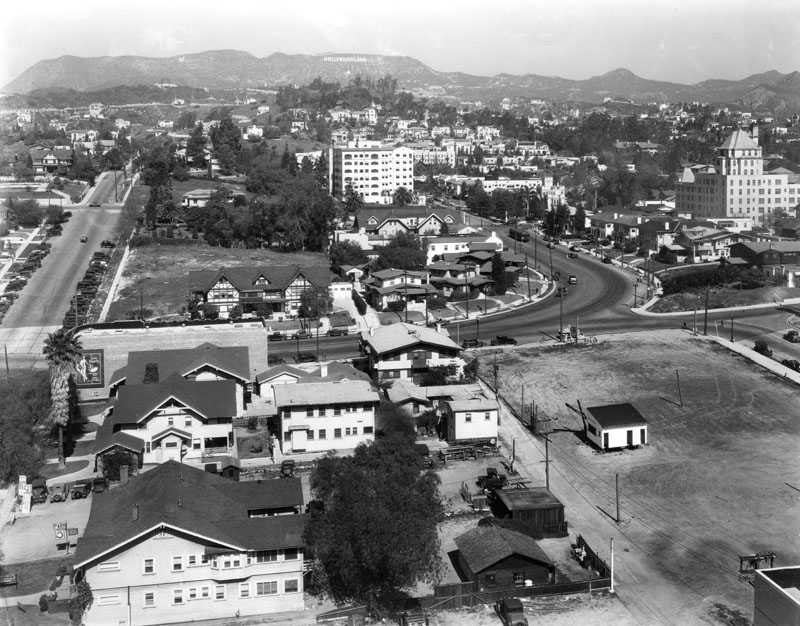 |
|
| (1932)* - View of Hollywood, looking north towards Vine (left) and Argyle (right). Middle foreground is Yucca, Franklin is beyond. |
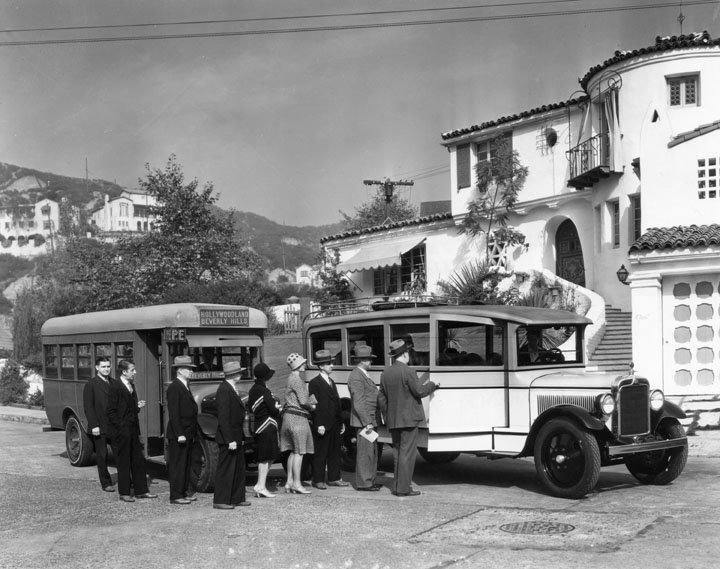 |
|
| (1928)* - Passengers are seen boarding busses for a real estate promotional tour in the Hollywoodland Tract. Local Pacific Electric jitney busses ran between Hollywoodland, Beachwood Canyon and Beverly Hills. |
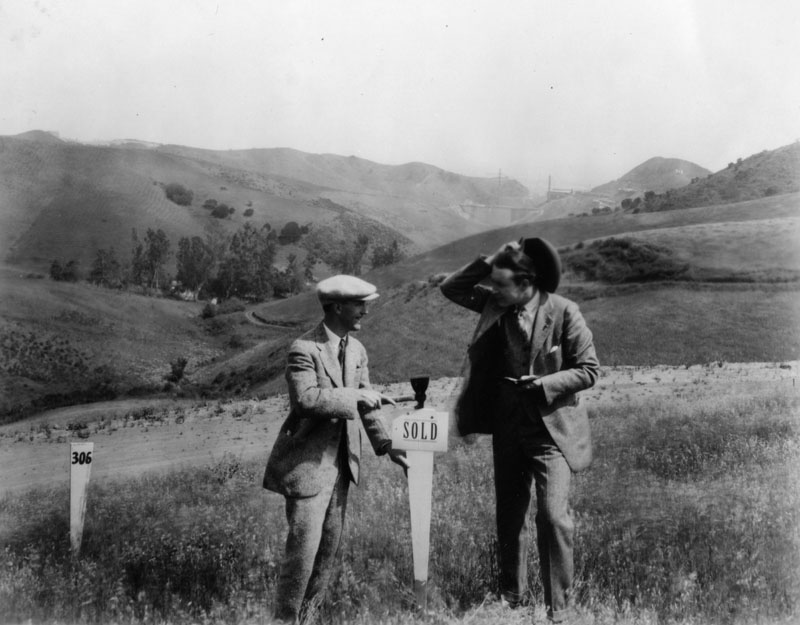 |
|
| (ca. 1924)* - A realtor is pounding in a "sold" sign for lot 306 in a real estate development in a hilly area of Hollywood. Next to him is a man scratching his head, as if in unbelief. Note the two towers in the distance directly over the man scratching his head. They were the construction towers used to erect Mulholland Dam in the Hollywood Hills. |
Historical Notes Mulholland Dam was built between 1923 and 1924 in the Hollywood Hills for the sole purpose of creating a water reservoir for the City of Los Angeles. |
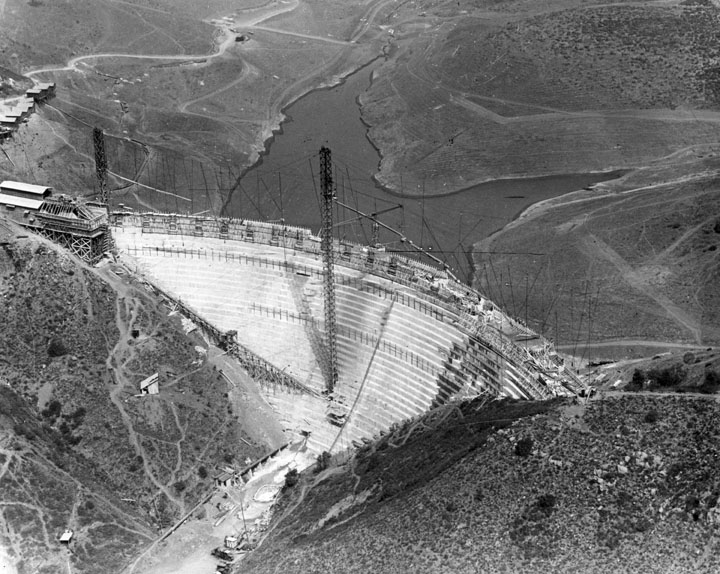 |
|
| (1924)* - Aerial view showing the construction of Mulholland Dam and the Hollywood Reservoir, |
Historical Notes The reservoir formed behind the dam was called the Hollywood Reservoir (later Lake Hollywood) and would hold up to 2.5 billion gallons of water from the Owens River Aqueduct System (LA Aqueduct) and from the groundwater of the San Fernando Valley. Clcik HERE to see more in Mulholland Dam and Hollywood Reservoir. |
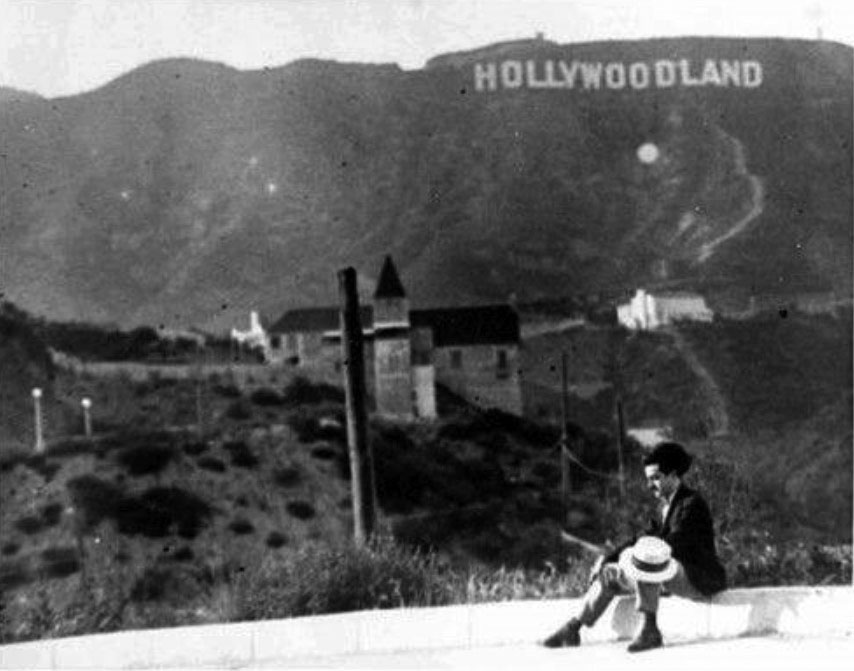 |
|
| (1926)* – A man (that looks a lot like Charlie Chaplin) sitting on a curb with the Hollywood Hills and "Hollywoodland" sign in the background. |
Historical Notes Sir Charles Spencer "Charlie" Chaplin was an English comic actor and filmmaker who rose to fame in the silent film era. Chaplin became a worldwide icon through his screen persona "the Tramp" and is considered one of the most important figures of the film industry. His career spanned more than 75 years, from childhood in the Victorian era until a year before his death in 1977, and encompassed both adulation and controversy.*^ |
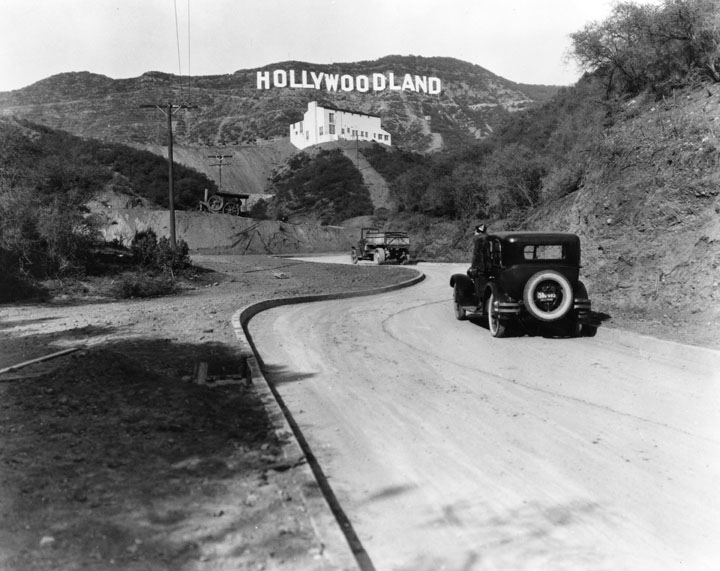 |
|
| (ca. 1930s)* - "Hollywoodland" sign seen from road with passenger car and truck in foreground. Car seems to date from early 1930's. A large white building is seen below the sign. |
Historical Notes Built in 1923 by Harry Chandler as a billboard for his Hollywoodland real estate development. In 1949 the Hollywood Chamber of Commerce contracted to repair and rebuild the sign. The contract stipulated that “LAND” be removed to reflect the district, not the housing development.* The Hollywood Sign located on the top of Mount Lee was declared Los Angeles Historic-Cultural Monument No. 111 in 1973. |
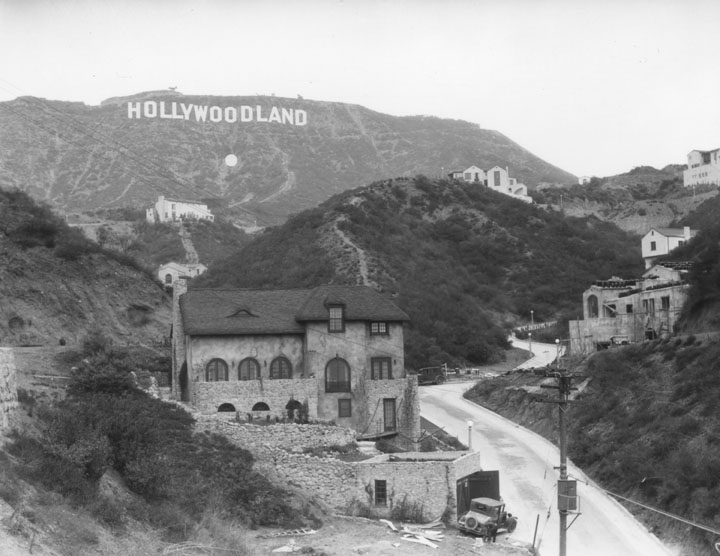 |
|
| (ca. 1930s)* - "Hollywoodland" sign with 4 homes in foreground set along a winding road. |
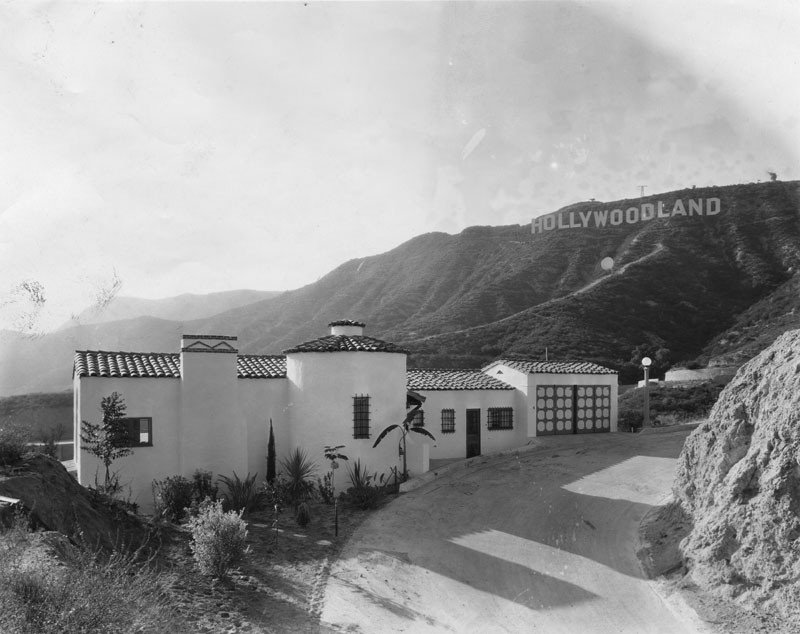 |
|
| (1932)* - Hollywoodland residences are climbing higher and higher. This home, encroaching on the domain of the Hollywoodland Sign, has a majestic 75 mile panorama for a front door. |
 |
|
| (ca. 1930s)* - More and more homes go up in the foothills below the Hollywoodland Sign. |
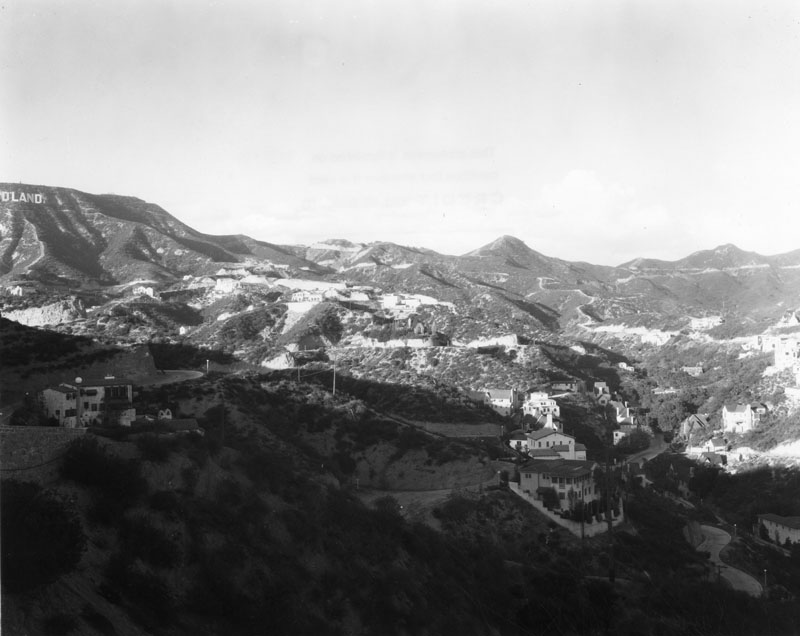 |
|
| (ca. 1930s)* - View of residential homes in the Hollywood Hills area near the Hollywoodland sign. Partial view of the "Hollywoodland" sign may be seen on the mountain, left side of this photo. |
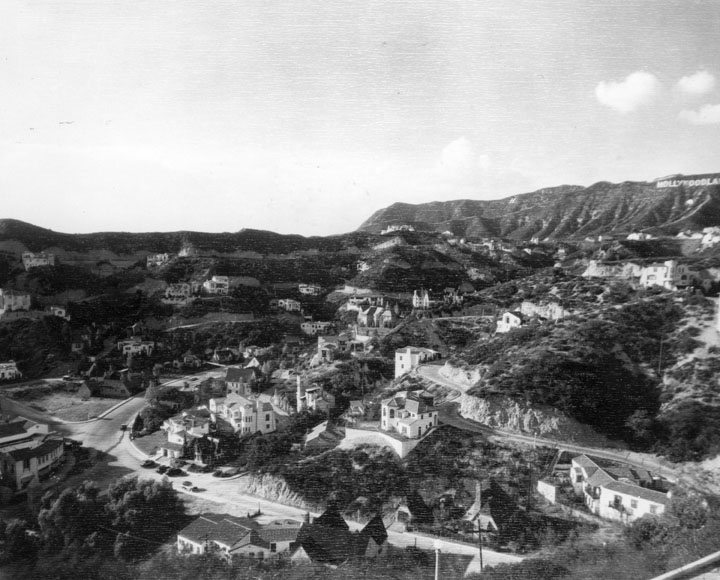 |
|
| (1930s)* - View of the Hollywood Hills filled with homes with the "Hollywoodland" sign in the upper right. |
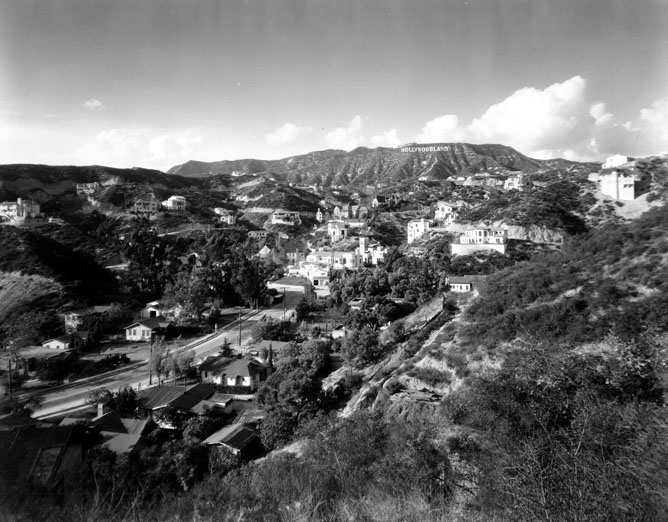 |
|
| (1930s)* - "Hollywoodland" sign in the upper center with Hollywood hills filled with homes in the foreground. |
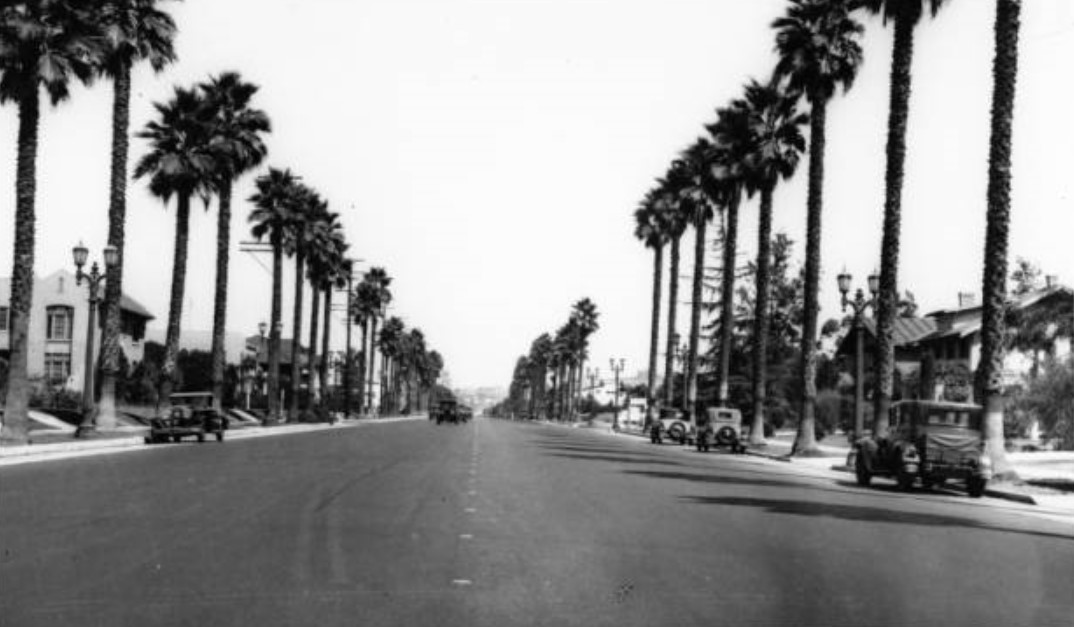 |
|
| (1931)^ - View of Sunset Boulevard east of Serrano Avenue. At center, a wide paved road is separated by a dotted line through the center that extends into the distance. Homes, parked automobiles and palm trees line the street to either side. |
Carpenter’s Drive-in Restaurant
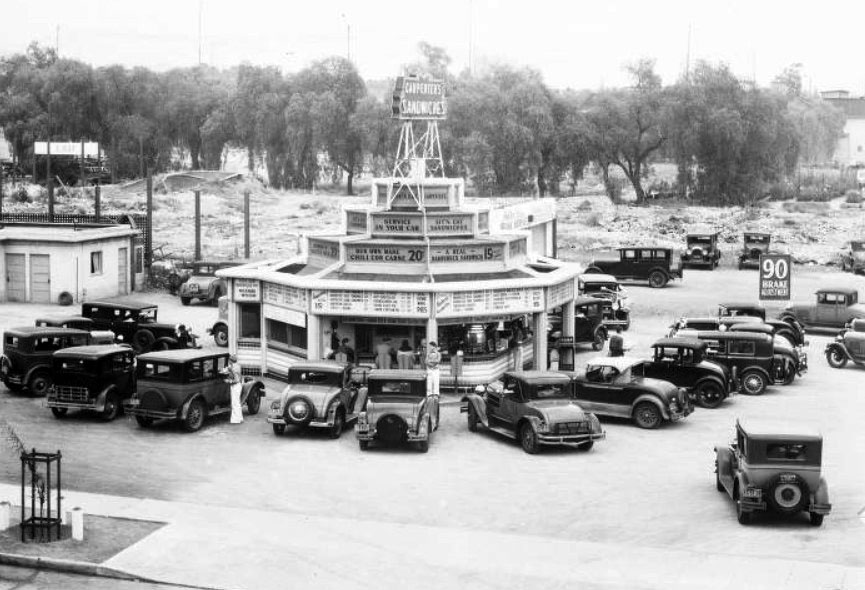 |
|
| (1932)^** - Carpenter’s Drive-in Restaurant, Sunset and Vine, Hollywood, Los Angeles. Photo by ‘Dick’ Whittington |
Historical Notes Carpenter’s Sandwiches drive-in was located at 6285 Sunset Boulevard between Vine Street and Argyle in Hollywood. For 30 cents you could enjoy a hamburger and wash it down with a cup of beer while sitting behind the wheel of your car (5 cents more for the premium beer). |
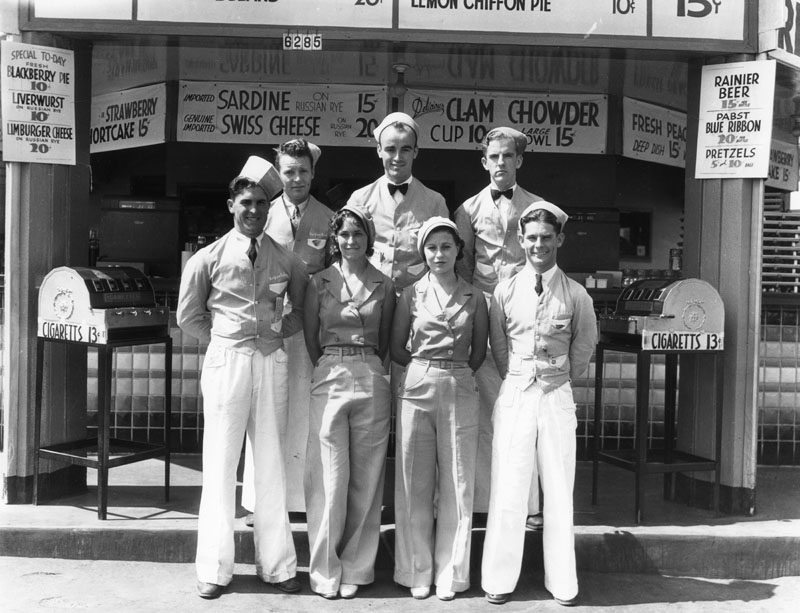 |
|
| (1933)* - Exterior view of Carpenter's Sandwich drive-in restaurant, with the carhops posing for the photo, in 1933. The drive-in was located at 6265 Sunset Blvd (near the N/E corner of Sunset and Vine). |
Historical Notes Harry B. Carpenter founded the Carpenter's chain with his brother Charles and operated many locations in Los Angeles including: Sunset and Vine, Wilshire and Western, Wilshire and La Cienega, Wilshire and Vine, Pico and Vermont, Silver Lake and Glendale and Sunset and Virgil.* |
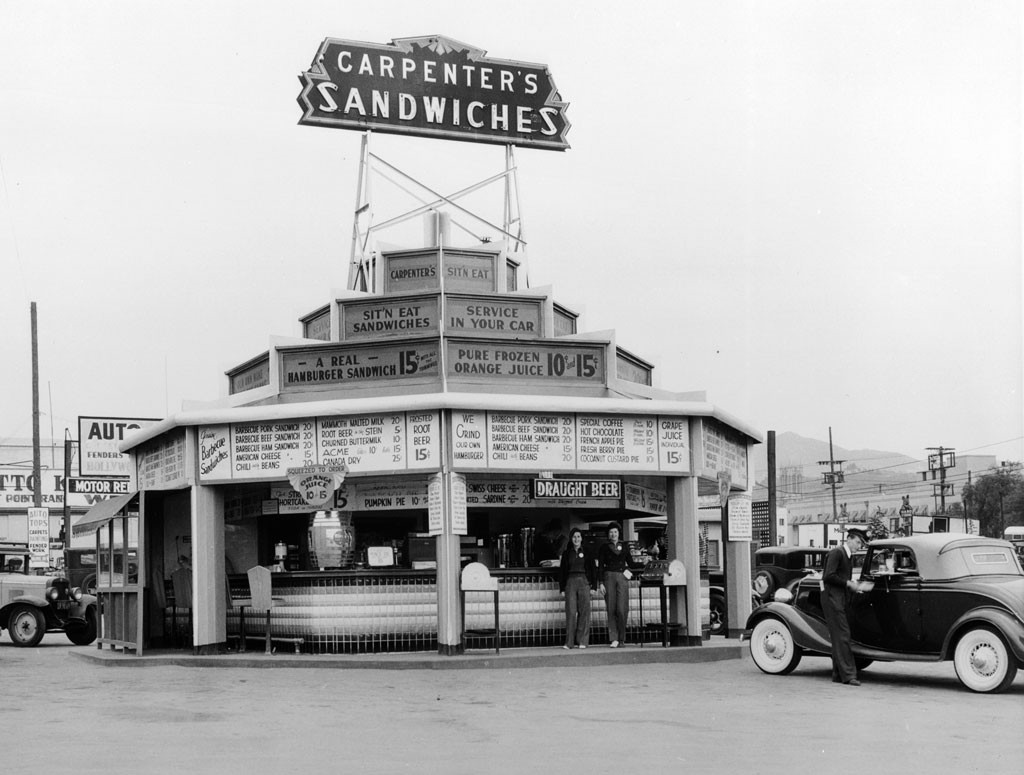 |
|
| (ca. 1930s)^ - Carpenter's Sandwich drive-in on Sunset and Vine. Two carhops are posing for the camera by the counter while another to the right appears to be serving food. |
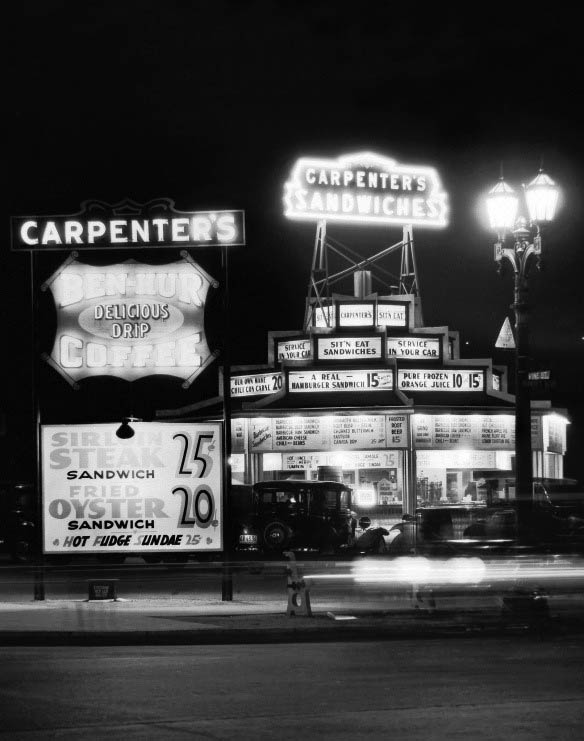 |
|
| (1930s)^^^^* – Nighttime view of Carpenter’s Sandwich at the N/E corner Sunset and Vine. Signs read: Ben Hur Delicious Drip Coffee, Sirloin Steak Sandwich - 25 Cents, Fried Oyster Sandwich - 20 Cents, Hot Fudge Sundae - 25 Cents, and “A Real Hamburger Sandwich” - 15 Cents. |
Historical Notes Originally located near the northeast corner of Sunset and Vine (6265 Sunset Blvd), Carpenter’s would be torn down to make room for the new NBC Radio City building, constructed in 1938. Shortly thereafter, Carpenter’s was reincarnated across the street on the southeast corner of Sunset and Vine (6290 Sunset Blvd). |
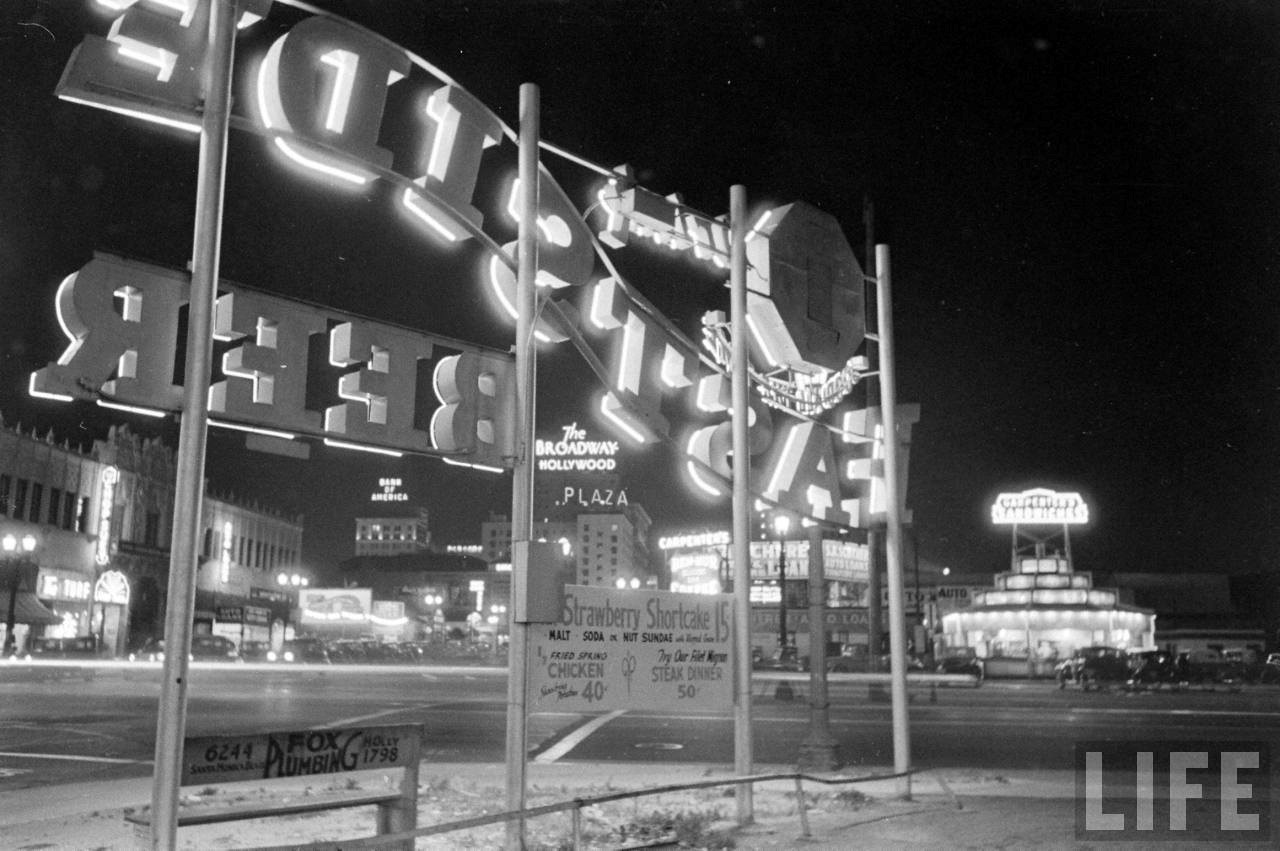 |
|
| (1930s)#**# – View looking north from behind a neon sign for Eastside Beer located on the SE corner of Sunset and Vine. Carpenter’s Sandwiches Drive-in can be seen across the street at a location that would become NBC Radio City. A new Carpenter's would be built right here on the SE corner, where this picture was taken from. In the distance can also be seen the neon signs for The Broadway-Hollywood and the Hollywood Plaza Hotel. LIFE Magazine |
Harry Carpenter's Drive-in (Sunset and Vine, SE Corner)
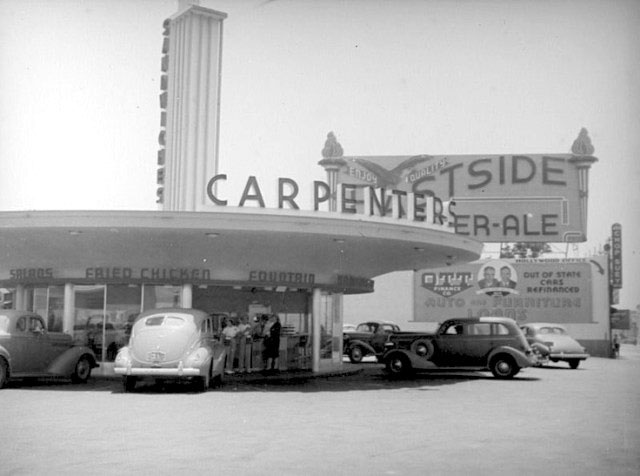 |
|
| (ca. 1938)**## – View looking south showing the newly built Carpenter’s Drive-in Restaurant located on the southeast corner of Sunset Boulevard and Vine Street in Hollywood. |
Historical Notes This Carpenter's Drive-in replaced the one located near the northeast corner of Sunset and Vine (6265 Sunset Blvd), which was torn down in 1938 to make room for the new NBC Radio City building. |
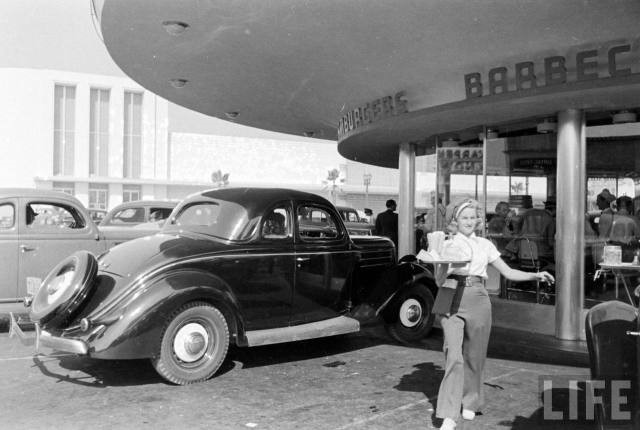 |
|
| (ca. 1938)**## – Life Magazine photo showing a carhop carrying a tray of food at Carpenter's Drive-in, with a 1936 Ford coupe seen on the left. In the distance, across Sunset Boulevard, stands the recently completed NBC Radio Studios. |
Historical Notes Carpenter’s was a chain of drive-in restaurants —there were six or seven locations—but this was probably the best known because it sat on the southeast corner of Sunset Boulevard and Vine Street in Hollywood, which put it across the street from the iconic NBC Radio Studios. |
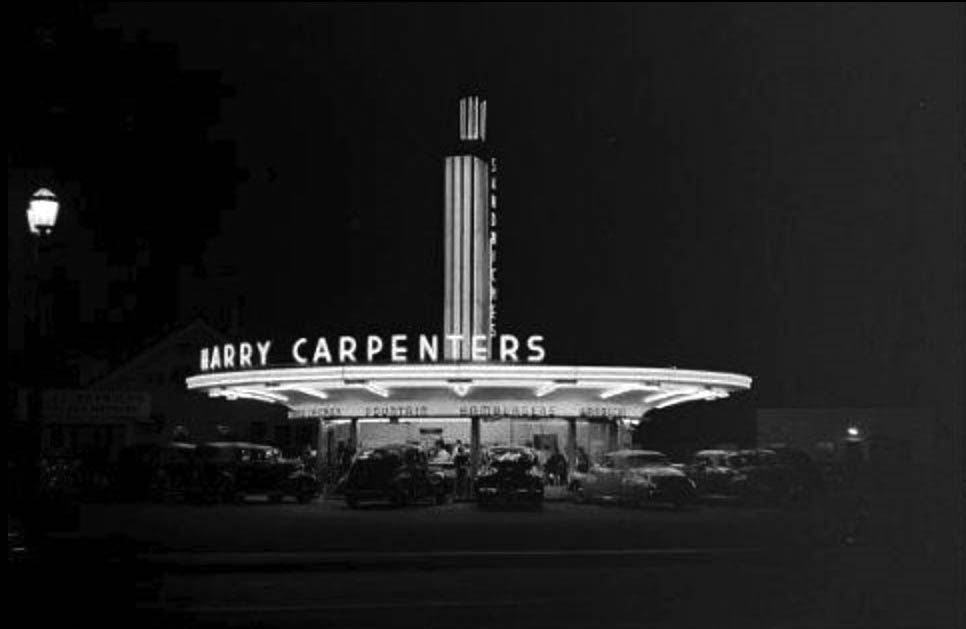 |
|
| (1940s)##^* – Night view showing cars parked at the beautiful saucer-shaped Harry Carpenter's Drive-in, on the southeast corner of Sunset and Vine, 6290 Sunset Boulevard. |
Historical Notes Between 1931 and 1961, three different drive-in restaurants occupied the southeast corner of Sunset and Vine: Click HERE to see more Early Views of LA Drive-in Restaurants. |
Griffith Park Observatory
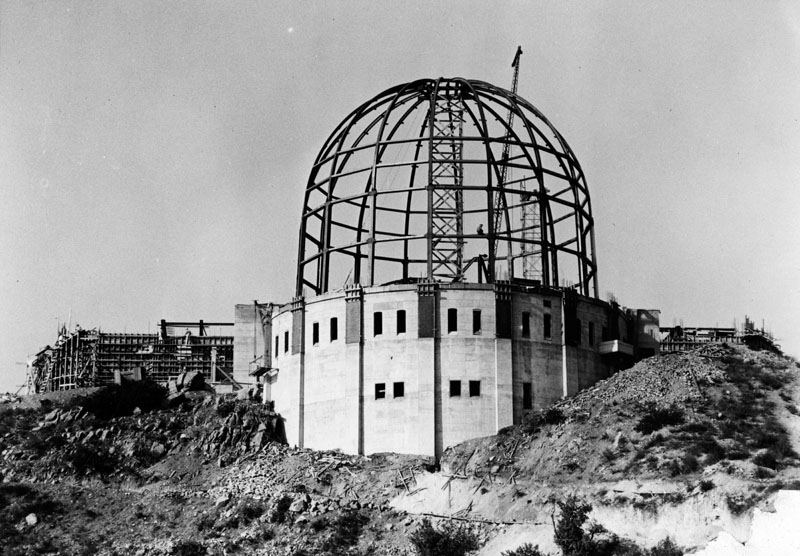 |
|
| (1933)* - A man sits on a steel girder on the half-completed dome of the Griffith Observatory as other construction workers are on scaffolds on the building behind the dome. Construction rubble is scattered around the Observatory's foundation. |
Historical Notes 3,015 acres of land surrounding the observatory was donated to the City of Los Angeles by Colonel Griffith J. Griffith on December 16, 1896. In his will Griffith donated funds to build an observatory, exhibit hall, and planetarium on the donated land. Construction began on June 20, 1933, using a design developed by architect John C. Austin based on preliminary sketches by Russell W. Porter. * |
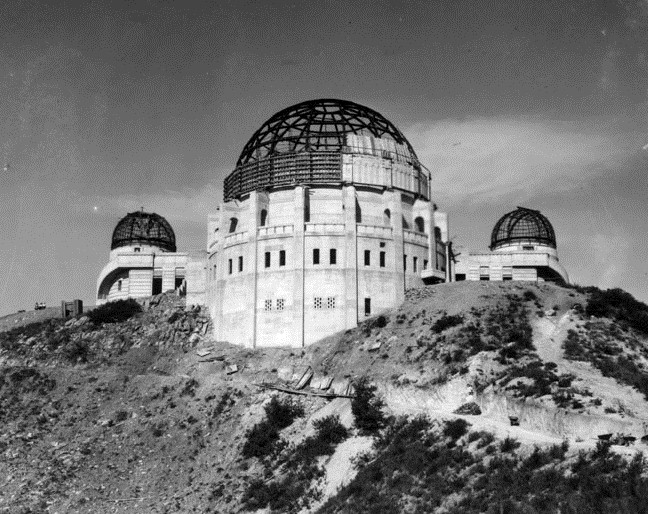 |
|
| (1934)* - The construction of Griffith Observatory in the final phases. The exterior domes can be seen here. |
Historical Notes Griffith Observatory was shaped not only by the minds of scientists but also by the times in which it was built. A major earthquake in Long Beach in March 1933 -- just as construction plans were being finalized -- led the architects to abandon the planned terra cotta exterior in favor of strengthening and thickening the building's concrete walls. Lower-than-usual prices caused by the Great Depression enabled the selection of the finest materials of the day for the interior walls, floors, and finishes, making the building both beautiful and durable.^*** |
 |
|
| (1934)* - The Griffith Observatory and the main building, the planetarium, are seen from below and from the back. A hiking path has been cut into the hillside below, on the south side, but brush still covers much of the area. |
Historical Notes Griffith Observatory's unique architecture and setting, compelling programmatic offerings, and cinematic exposure have made it one of the most famous and visited landmarks in Southern California.^*** |
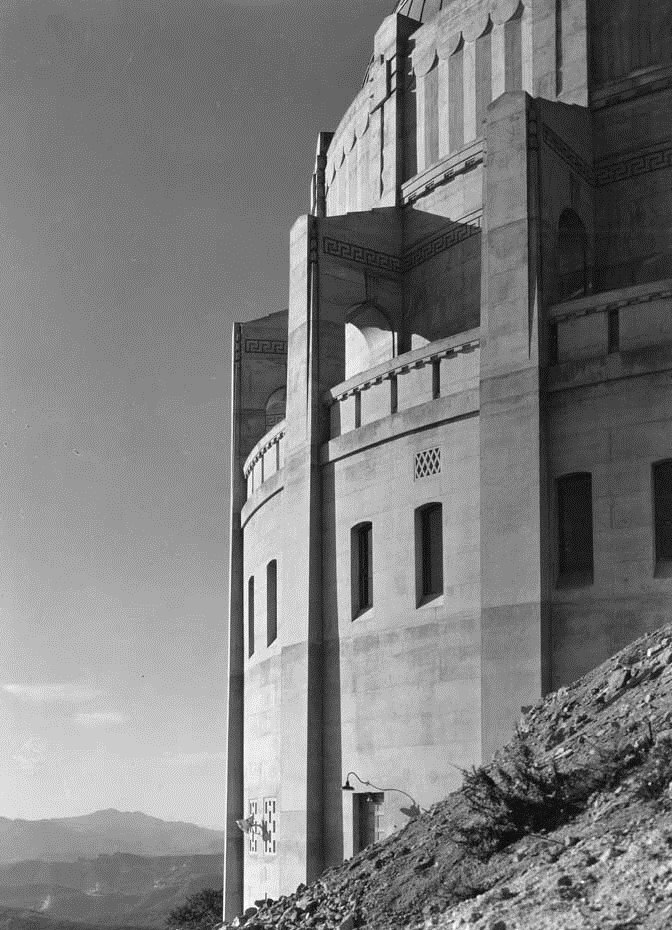 |
|
| (ca. 1934)^^^ - Profile view of the Griffith Observatory on the hillside. |
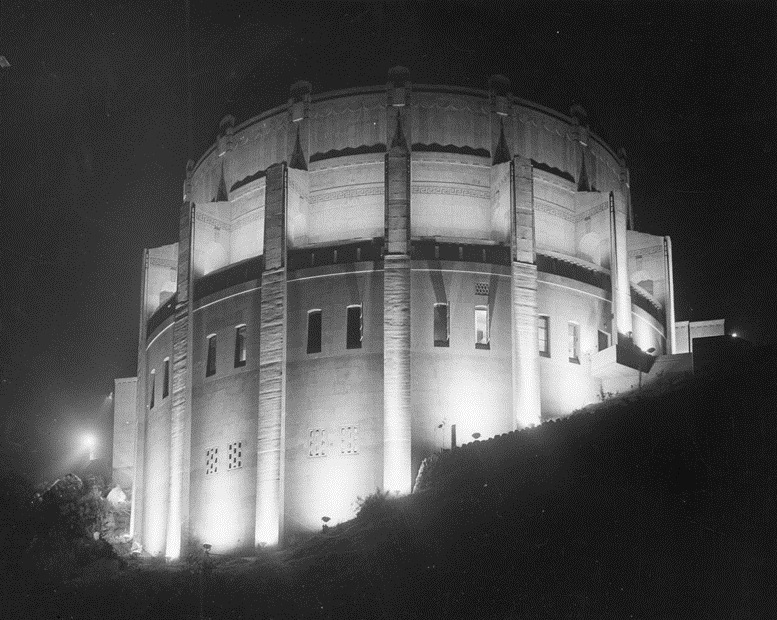 |
|
| (1935)^^^ - The iconic Griffith Observatory stands out in its brilliance as it is illuminated in the Hollywood Hills. |
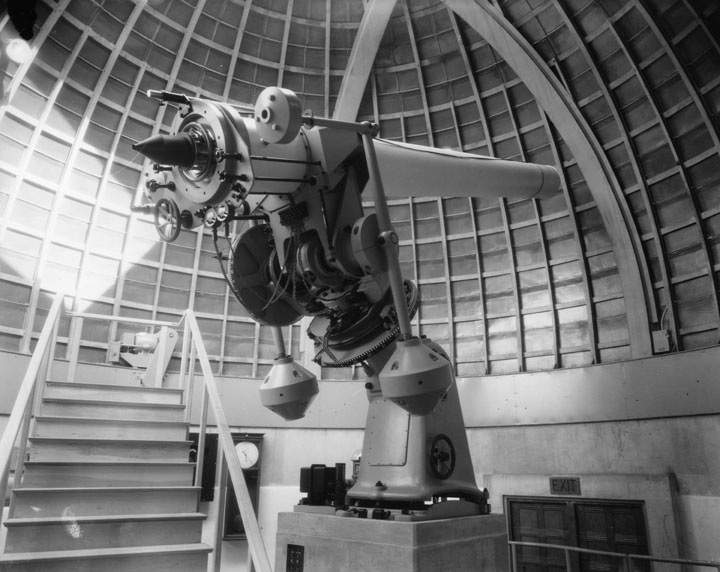 |
|
| (ca. 1935)* - View of the Zeiss refracting telescope within one of the two smaller domes at the end of the Griffith Observatory. |
Historical Notes Since opening in 1935, more than seven million people have put an eye to Griffith Observatory's original 12-inch Zeiss refracting telescope. More people have looked though it than any other telescope in the world. The genesis of Griffith Observatory's public telescope occurred when Griffith J. Griffith was invited to visit to Mount Wilson Observatory, then home to the world's largest operating telescope, the 60-inch reflector. While there, he was given the opportunity to view a celestial wonder through the telescope. Profoundly moved by the experience, Griffith seized on the idea of constructing a public observatory with a telescope that could be used by all residents of Los Angeles. He specified in his will that the telescope was to be "at least 12-inches in diameter" and "complete in all its details" and was to be located "high and above the Hall of Science." In 1931, the Griffith Trust ordered the telescope from the Carl Zeiss Company of Jena, Germany; the $14,900 spent on the instrument was the first purchase of material for Griffith Observatory.^**^ |
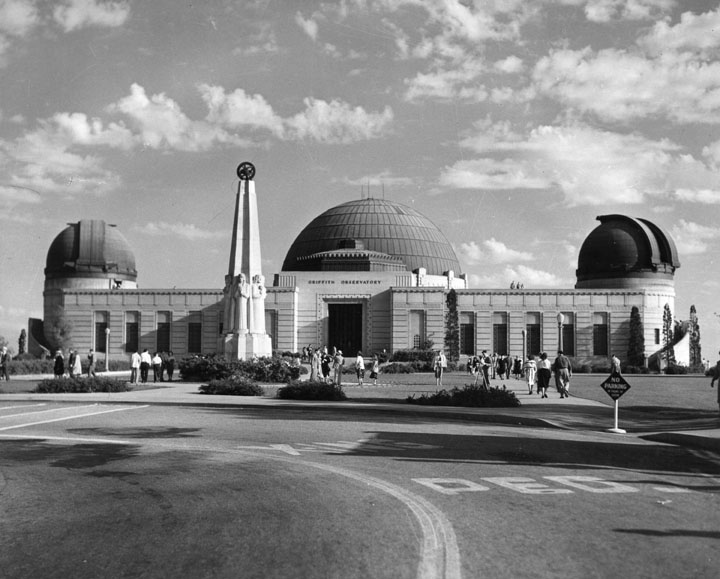 |
|
| (1930s)* - View of the Griffith Park observatory and planetarium with the Astronomers Monument. Several people are on the walks, coming and going to the planetarium (the central section of the building). The domes on the left and the right ends of the building contain the triple-beam solar telescope and the 12-inch Zeiss Refracting Telescope respectively. |
Historical Notes Griffith Observatory opened its doors to the public on May 14, 1935. In its first five days of operation the observatory logged more than 13,000 visitors.* |
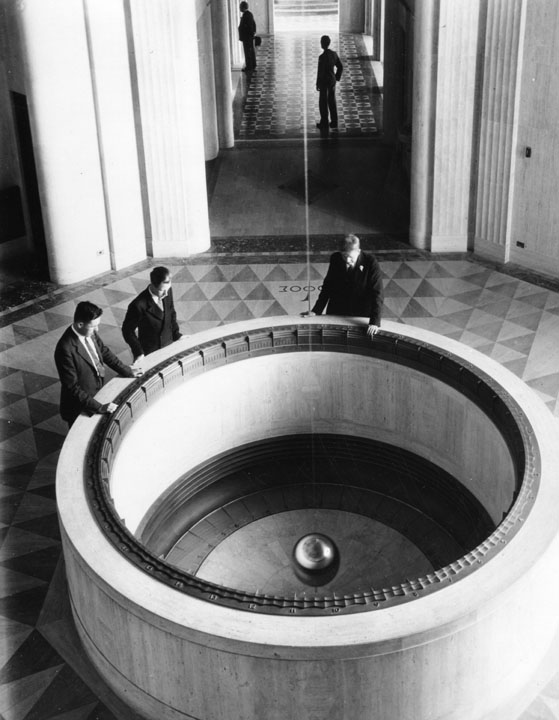 |
|
| (ca. 1935)* - Three men gaze at the Foucault pendulum in the foyer of the Griffith Observatory. The pendulum demonstrates the rotation of the earth. |
Historical Notes The first exhibit visitors encountered was the Foucault pendulum, which was designed to demonstrate the rotation of the Earth.*^ |
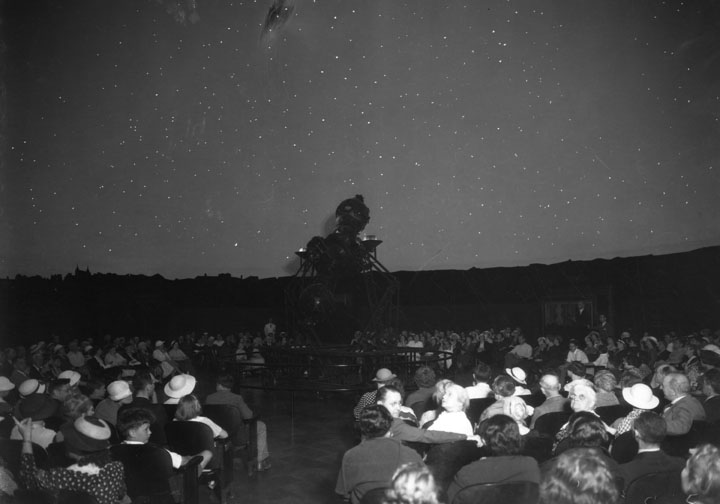 |
|
| (1935)* - Audience viewing a performance at the planetarium at Griffith Observatory. |
Historical Notes The Griffith Observatory also included a planetarium under the large central dome. The first shows covered topics including the Moon, worlds of the solar system, and eclipses. During World War II the planetarium was used to train pilots in celestial navigation. The planetarium was again used for this purpose in the 1960s to train Apollo program astronauts for the first lunar missions. The planetarium theater was renovated in 1964 and a Mark IV Zeiss projector was installed.*^ |
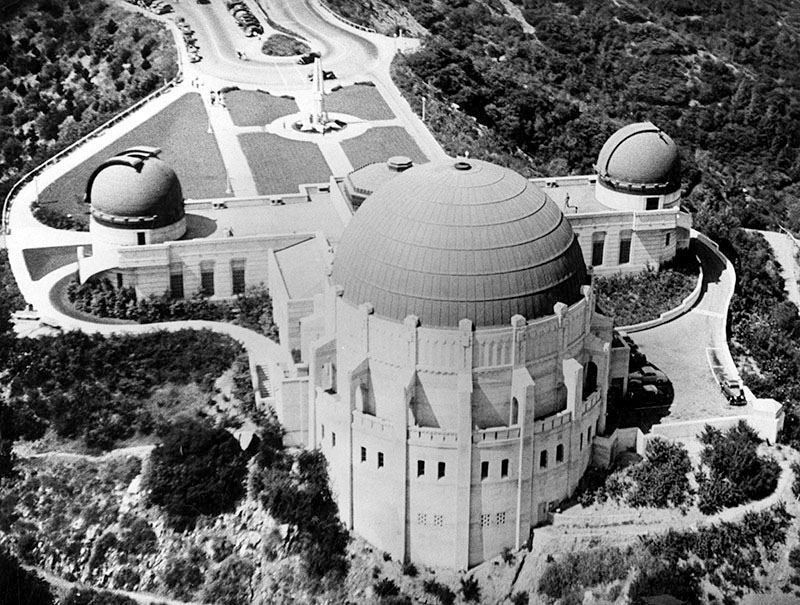 |
|
| (1938)* – Aerial view showing the symmetry of the beautiful art-deco Griffith Observatory. |
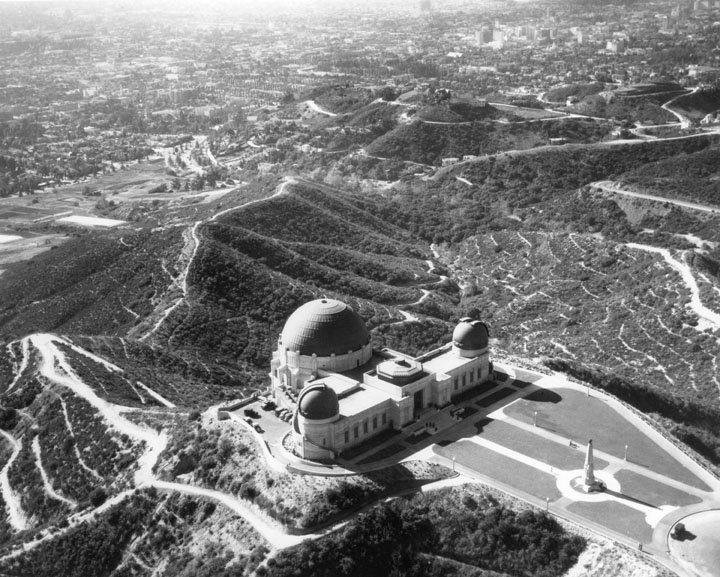 |
|
| (1935)* - Aerial view of the top and front view of the observatory/planetarium. The Astronomers Monument, designed by Archibald Garner, is out front on the well manicured front lawn, and some parking with cars is seen around the back side (probably for the staff). Behind the planetarium are the tree covered hills and farther back the beginnings of buildings and homes in Hollywood. |
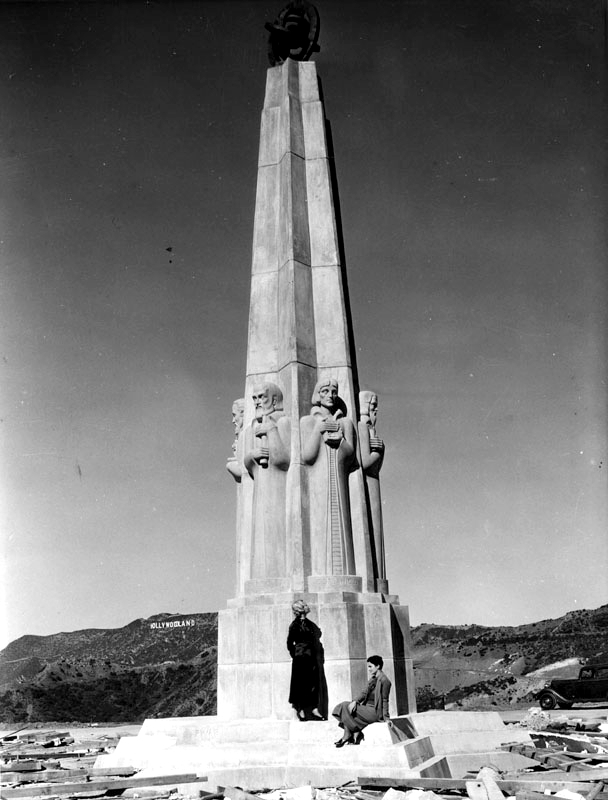 |
|
| (1930s)*^^ - Women visiting the Astronomer’s Monument at a still unfinished Griffith Observatory, 1930’s. The Hollywoodland Sign can be seen in the background. |
Historical Notes The Astronomers Monument on the front lawn of Griffith Observatory pays homage to six of the greatest astronomers: Hipparchus, Copernicus, Galileo, Kepler, Newton, and Herschel. Artist Archibald Garner designed the sculpture commissioned by the Public Works of Art Project (PWAP). Garner worked with five other artists (each responsible for sculpting one astronomer) including George Stanley responsible for the "Oscar" statuette. The monument was dedicated November 25, 1934, six months before the Observatory opened.* |
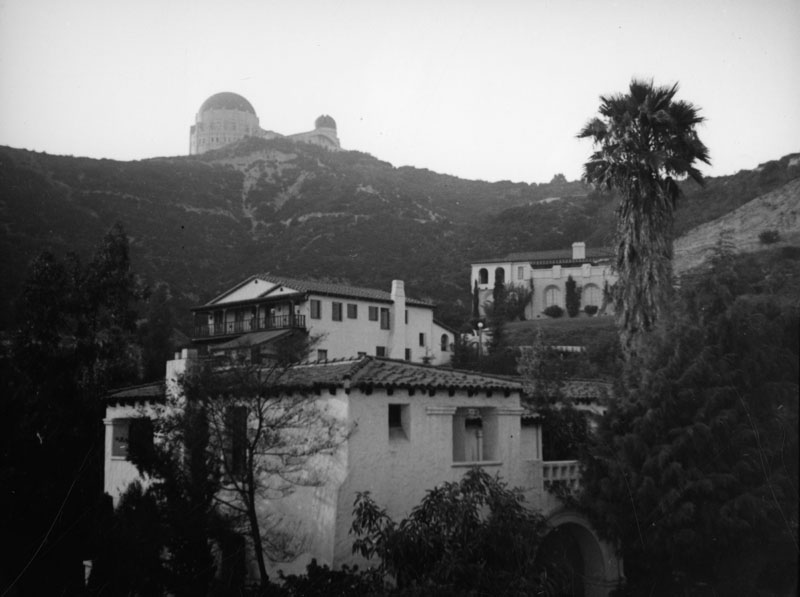 |
|
| (1935)* - Griffith Observatory on its opening day, May 14, 1935, as seen from an affluent neighborhood in northern Los Feliz. |
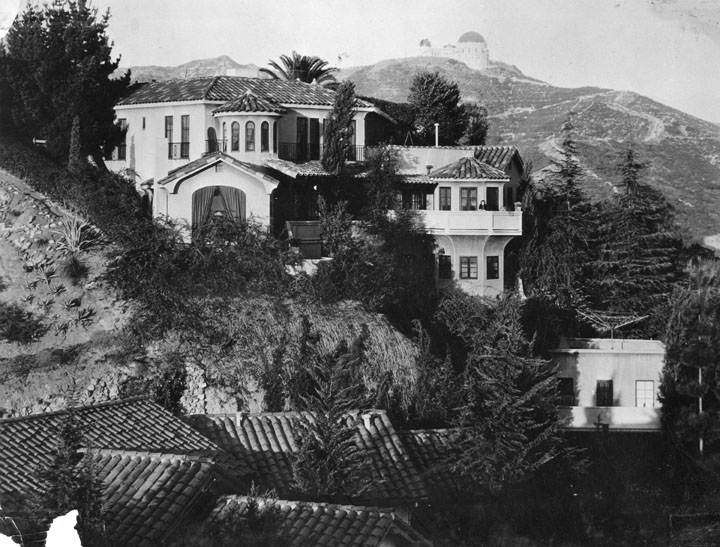 |
|
| (ca. 1935)* - View of a large Spanish style home, located on Live Oak Drive, belonging to one of the Twentieth Century-Fox film players. In the background the Griffith Observatory is clearly visible. |
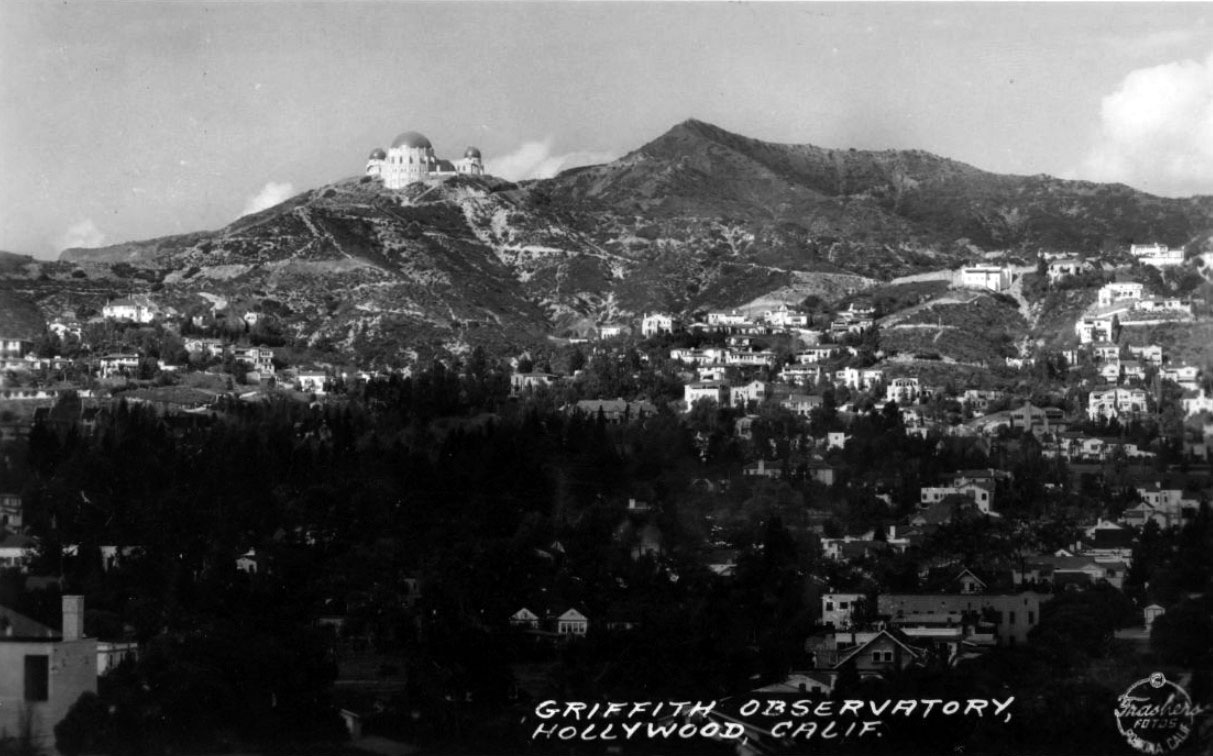 |
|
| (1936)#^^^ – Postcard view showing the Griffith Observatory perched high above the city in the hills of the sprawling Griffith Park. The peak to the right of the observatory is Mt. Hollywood. |
Historical Notes The Griffith Observatory is 1,124 feet above sea level and is visible from many parts of the Los Angeles basin. Mt. Hollywood is 516 feet higher, at 1,640 feet above sea level.^*** |
Before and After
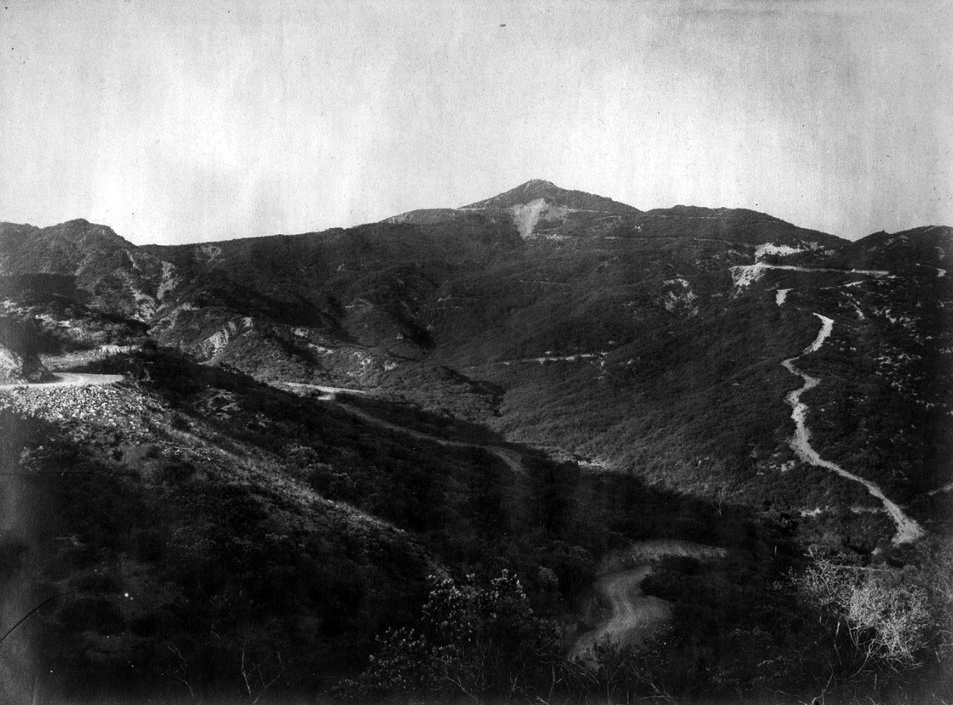 |
 |
|
| (ca. 1900)*# - Mt. Hollywood before homes and Observatory | (1936)#^^^ - Mt. Hollywood with Observatory and homes. |
Historical Notes Col. Griffith saw Mt. Hollywood as the obvious site for the observatory and Hall of Science that would bear his name. He envisioned a funicular railway--an elongated version of downtown L.A.'s Angel's Flight, perhaps--trundling passengers to the mountaintop from Vermont Canyon, location of his other great gift to the city, the Greek Theatre. But the mountaintop observatory and funicular railway proved too costly, and the site had little room for parking. So the observatory was built on the south-facing slope of Mt. Hollywood, elevation 1,124 feet.*^^# |
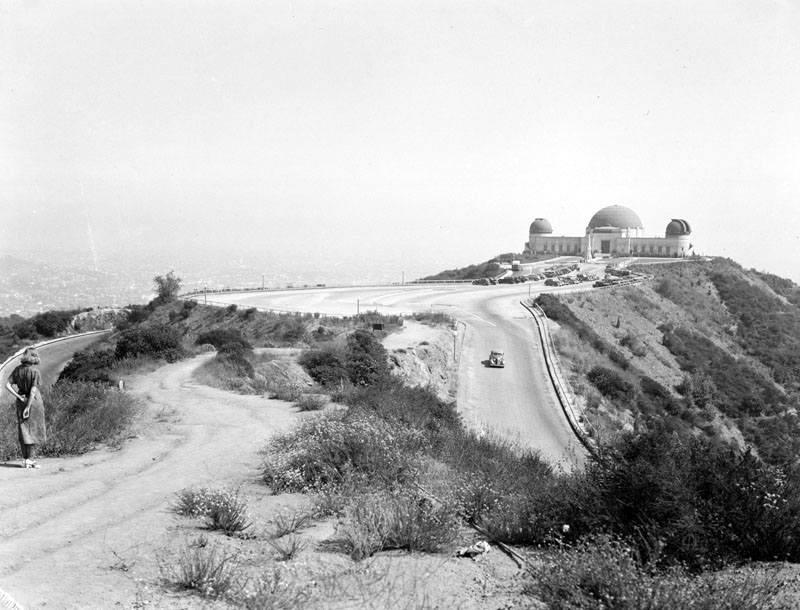 |
|
| (1937)* - View of Griffith Observatory in Griffith Park, looking southeast with the city down below in the background. A woman is standing in the foreground looking down at the view. |
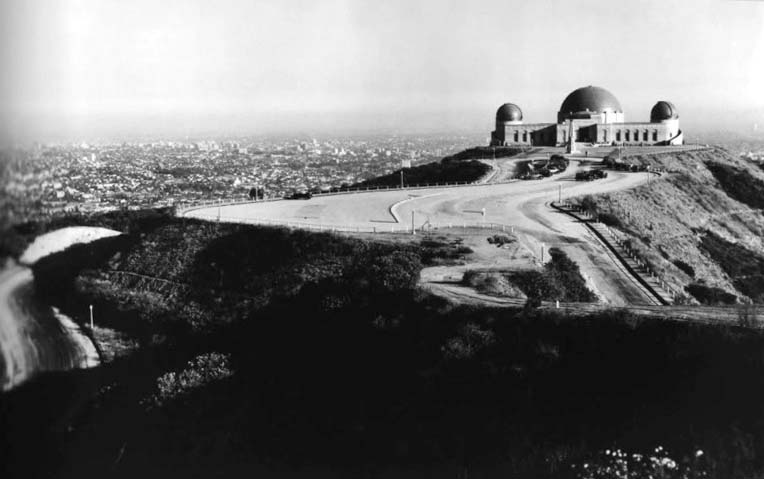 |
|
| (1930s)*# – View of the Griffith Park Observatory on a clear day with the Los Angeles cityscape in the background. Several cars are parked in front of the observatory. |
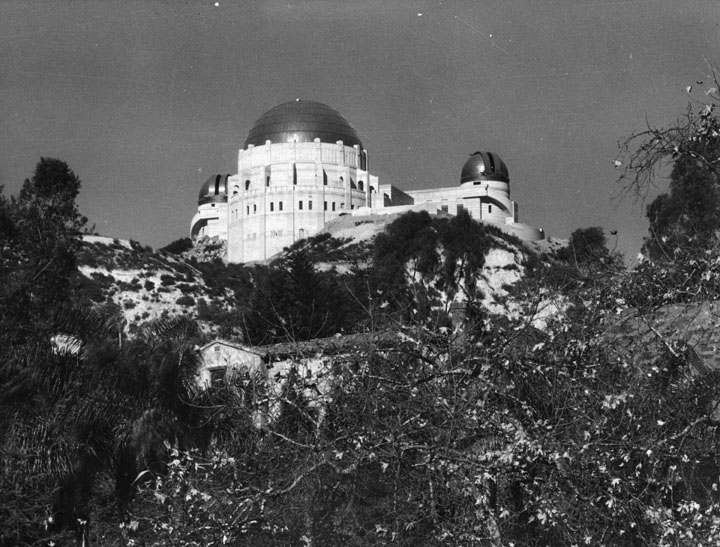 |
|
| (1930s)* - Twilight view of the planetarium and observatory in Griffith Park as seen from the hillside. |
 |
|
| (ca. 1937)* - Sunset view of the wide lawns and Astronomers Monument from Griffith Observatory. The tall peak in the background is Mt. Hollywood. |
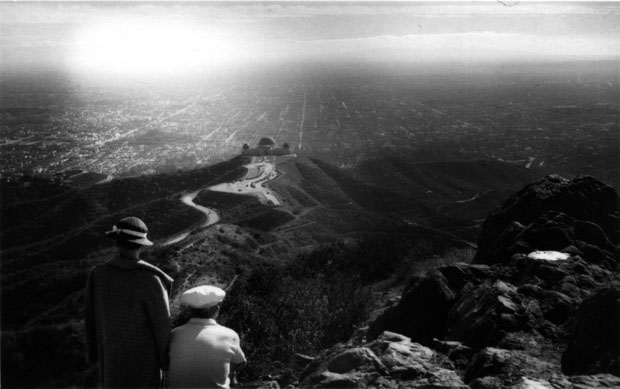 |
|
| (1936)*# - Looking over Griffith Observatory and Los Angeles from Mt. Hollywood. Photography by Julius Shulman. |
Historical Notes In 1976, the Griffith Observatory was designated Los Angeles Historic-Cultural Monument No. 168 (Click HERE for complete listing). |
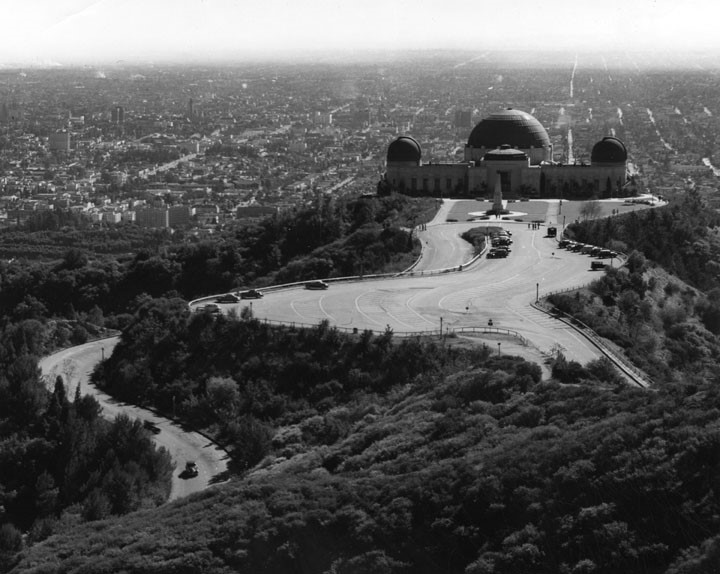 |
|
| (ca. 1943)* - Seen from a nearby (trail to Mt. Hollywood) hillside is the front of the planetarium, the lawn and parking lot, and road leading down from the Griffith Observatory. Los Feliz, East Hollywood, Hollywood and greater Los Angeles is visible in the distance. |
Historical Notes Since the observatory opened in 1935, admission has been free, in accordance with Griffith's will.*^ |
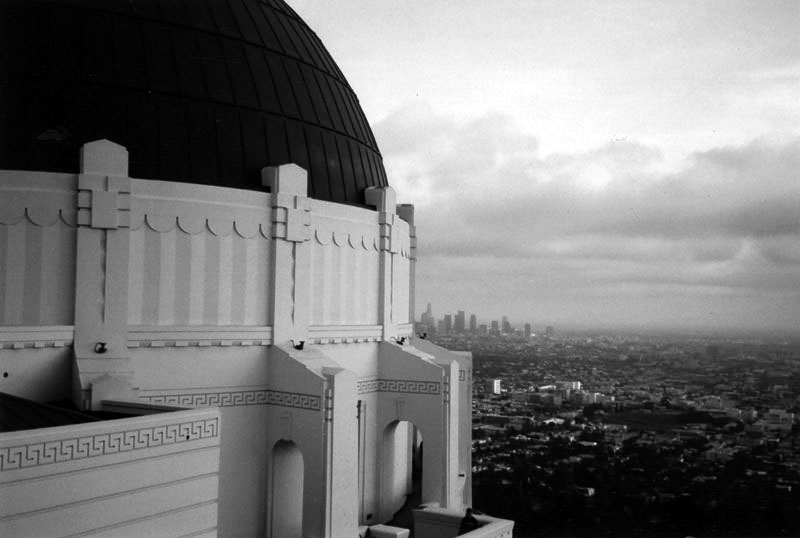 |
|
| (ca. 2006)* - Panoramic view of Los Feliz, Hollywood and downtown Los Angeles, taken from outside of the Samuel Oschin Planetarium at Griffith Observatory. |
Historical Notes For over 75 years, the planetarium has been used to present astronomical programs overseen by a lecturer. The view reveals a variety of buildings, homes and the numerous skyscrapers located in Downtown L.A. in the background. This photograph was taken not long after the observatory reopened on November 3, 2006, after having been closed since 2002 for an extensive renovation. John C. Austin and Frederick M. Ashley were the original architects of the Art Deco structure.* |
Garden Court Apartments
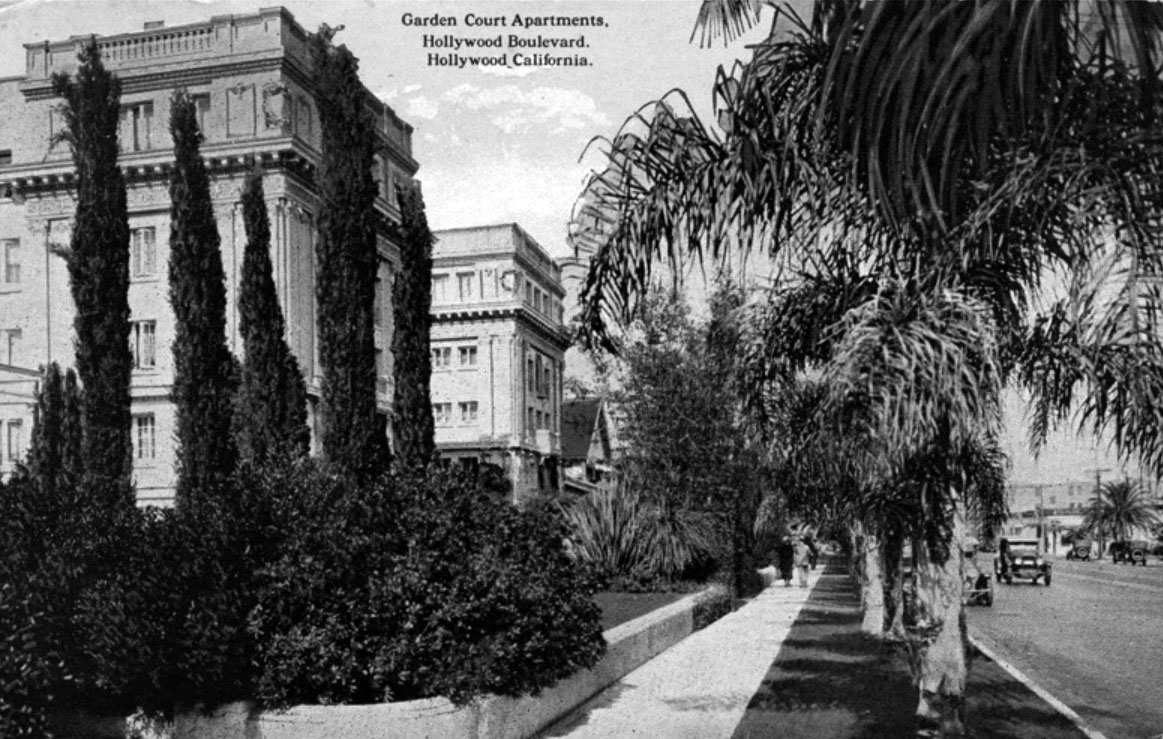 |
|
| (1925)* – Postcard view looking east on Hollywood Boulevard showing the Garden Court Apartments located at 7021 Hollywood Boulevard. |
Historical Notes Designed by architect Frank S. Meline in the Beaux Arts style and built in 1917, the classical structure consisted of 190 two and three room suites composed of hard wood and tile. The apartment building was intended to accommodate prominent members of the movie industry. Among its residents were Louis B. Mayer, Mae Murray, and John Gilbert.* |
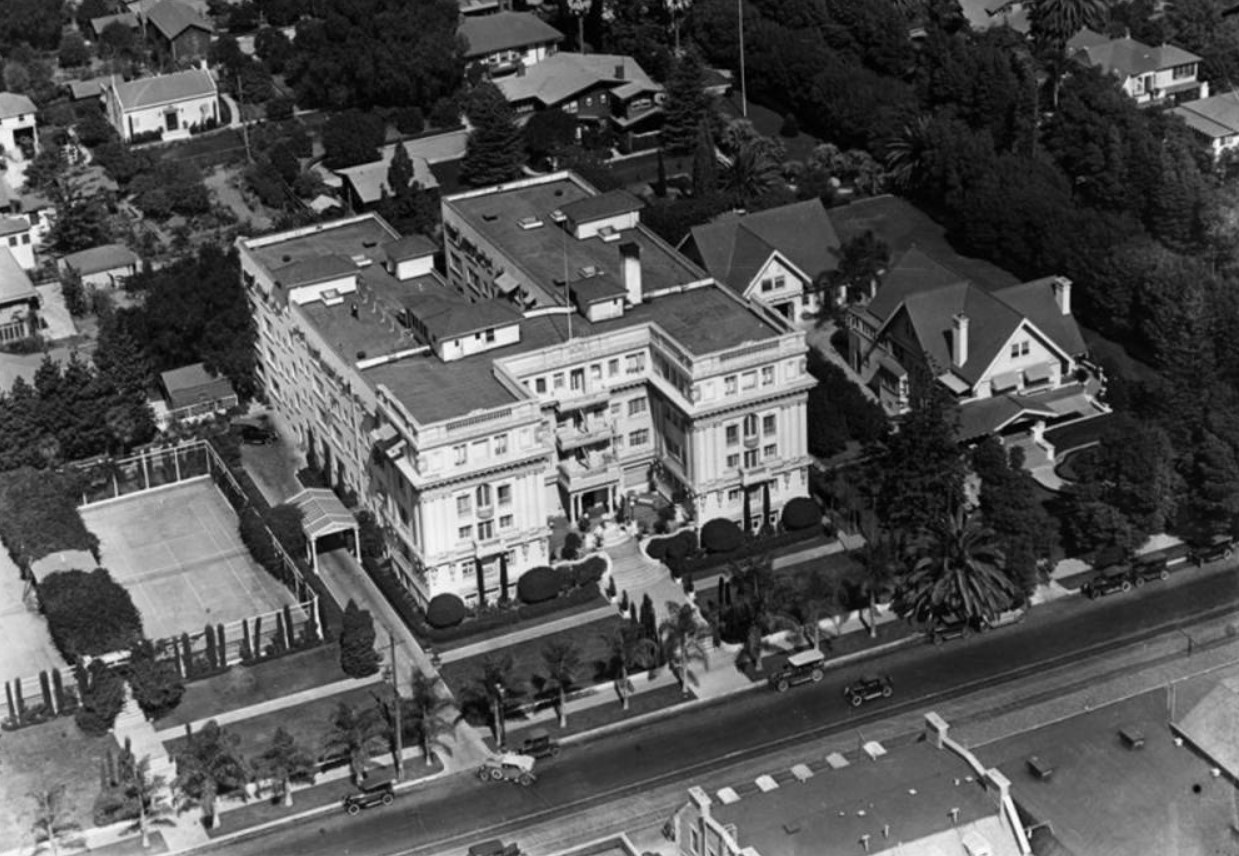 |
|
| (1924)* - Aerial view of the Garden Court Apartments in Hollywood. Built in 1919 at 7021 Hollywood Blvd. |
Historical Notes The four-story, 190-room Garden Court was designed in the Beaux Arts style, and its figural corbels on the exterior, supporting the second-story molding, were an integral part of the style. The Garden Court also featured tennis courts on the Sycamore Avenue side of the property. |
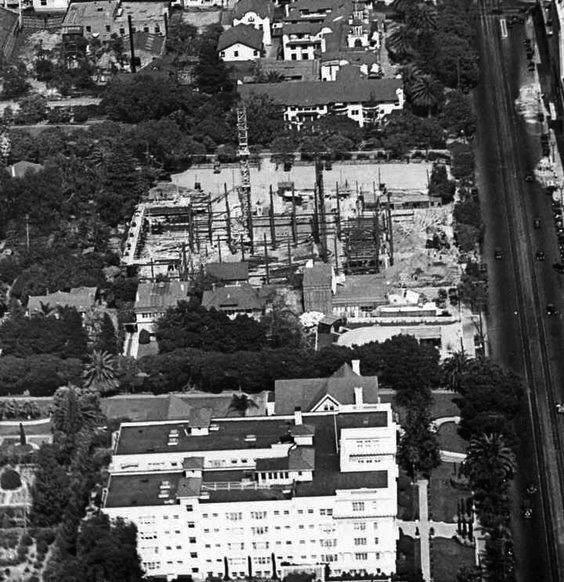 |
|
| (1926)** – Aerial view looking east showing the Garden Court Apartments with the Grauman's Chinese Theatre seen here still under construction. The Hollywood Hotel is further east, at top of photo. |
Historical Notes The flowery prose calling Hollywood “the wonder spot of the southland” described how the pergolas, gardens, and walks suggested Southern Italy with their stately beauty, and surrounded the playing fountain and pool in the inner court, a warm, simply elegant “House of a thousand wonders – the house of the heart’s desire.” |
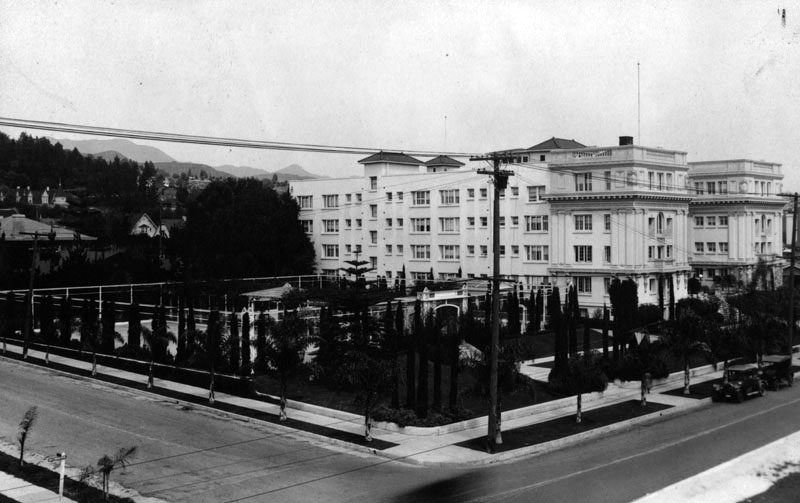 |
|
| (1920s)* - View of the northeast corner of Sycamore Avenue and Hollywood Boulevard showing the western side of the Garden Court Apartments. On the left on the hillside full of trees is the lower area of the property belonging to the Bernheimer brothers. |
Historical Notes Movie magazine Photoplay called it the “largest and most beautiful apartment house in Hollywood,” drawing movie folk and celebrities to its elegant surroundings. Sam Fox, sheet music publisher, vacationed for months at the property with his family. Director King Vidor played tennis on its courts. Actress Julanne Johnston, theatre impresario Sid Grauman, photographer Frank S. Hoover, and director Sidney Franklin lived there in the 1920s, enjoying the Pryor Moore Dance Orchestra, along with classical concerts and voice classes. * |
 |
|
| (1920s)^.^ – Looking across Hollywood Boulevard showing two cars parked in front of the Garden Court Apartments. Note the streetcar tracks. |
Historical Notes The Garden Court Apartments offered residents such special amenities as its own garage providing car service, a commissary, two ballrooms, billiard room, beauty parlor, daily maid service, two tennis courts, pergolas, trellises, and gardens. * |
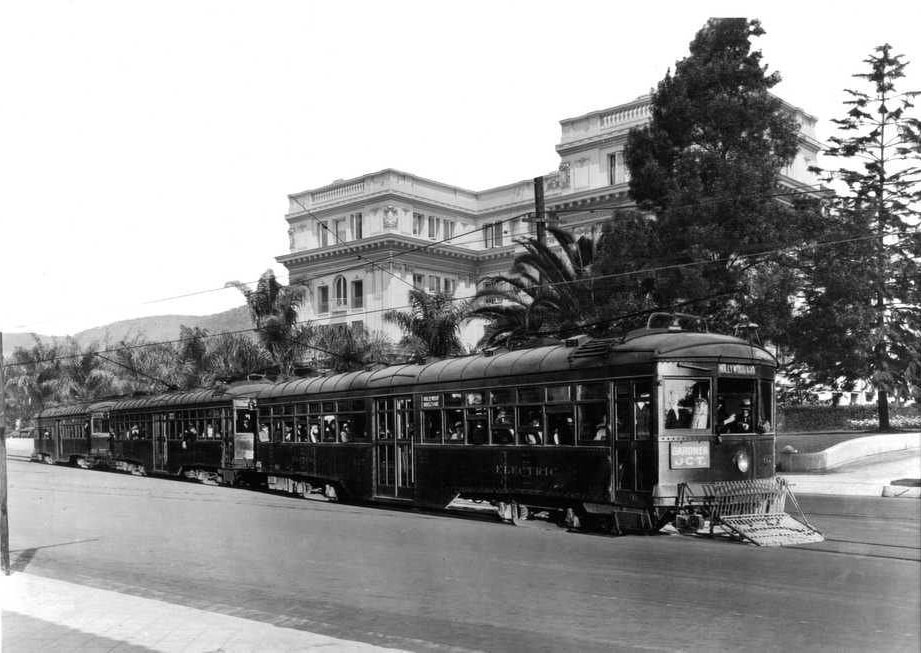 |
|
| (1920s)^ - Pacific Electric Red Cars on Hollywood Blvd. with the Garden Court Apartments behind it. |
Historical Notes From 1918 to 1928, you'd typically see a Pacific Electric car transporting hundreds of passengers down Hollywood Boulevard. |
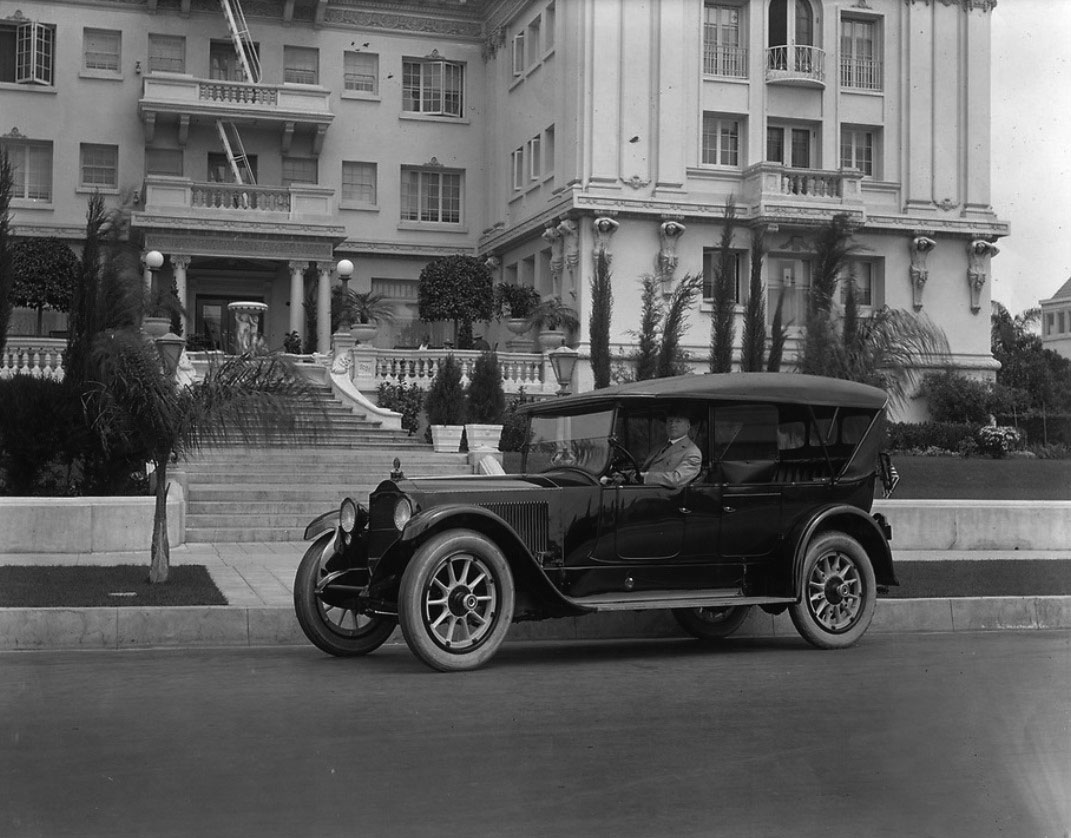 |
|
| (1920s)^.^ – Man sitting in his late model convertible posing for the camera in front of the Garden Court Apartments. Note the figural corbels supporting the second-story molding. |
Historical Notes Rich mahogany and ivory trim decorated each apartment, which included hard wood floors, plate glass windows, and period furniture, along with such special amenities as steam heat, telephone service, daily maid service, vacuum connections, sanitary garbage chutes, electric refrigerators, and circulating ice water. Apartment living rooms were furnished with overstuffed furniture, chaise longues, and Colonial rockers, while Old English dining rooms filled with William and Mary furniture were outfitted in dark blues and mulberry reds. Built-ins and beveled mirrors decorated dressing rooms outside tiled bathrooms containing alcove tubs and showers. Singles were furnished with Jacobean furniture in English oak, along with moroccan leather and tapestries. * |
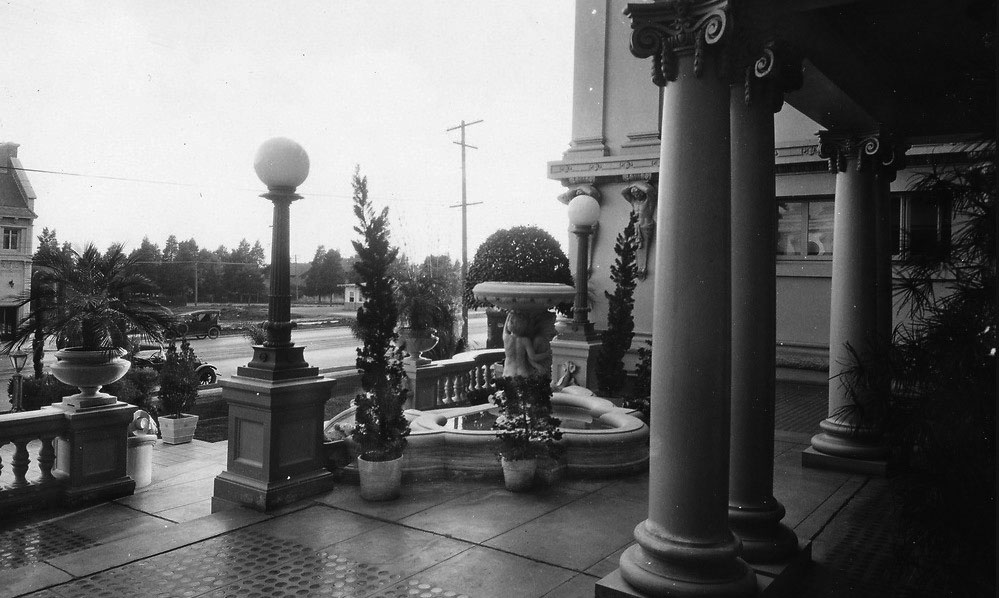 |
|
| (1920s)* – View looking SW towards Hollywood Boulevard as seen from near the front entrance to the Garden Court Apartments. |
Historical Notes Businessmen C. E. Toberman and S. A. Hartwell leased the building for 99 years on Feb. 19, 1926, per the Los Angeles Times, retaining all staff. The new managers made few changes, but opened meeting rooms to more diverse uses, including rentals by groups offering Bhagavad Gita and yoga classes. Entertainers performed in its banquet room, with vaudeville performer Virginia Sale headlining her own sketch show in May 1933, which garnered fine reviews in Variety. By 1930, however, Toberman was forced to turn over the structure due to financial difficulties. * |
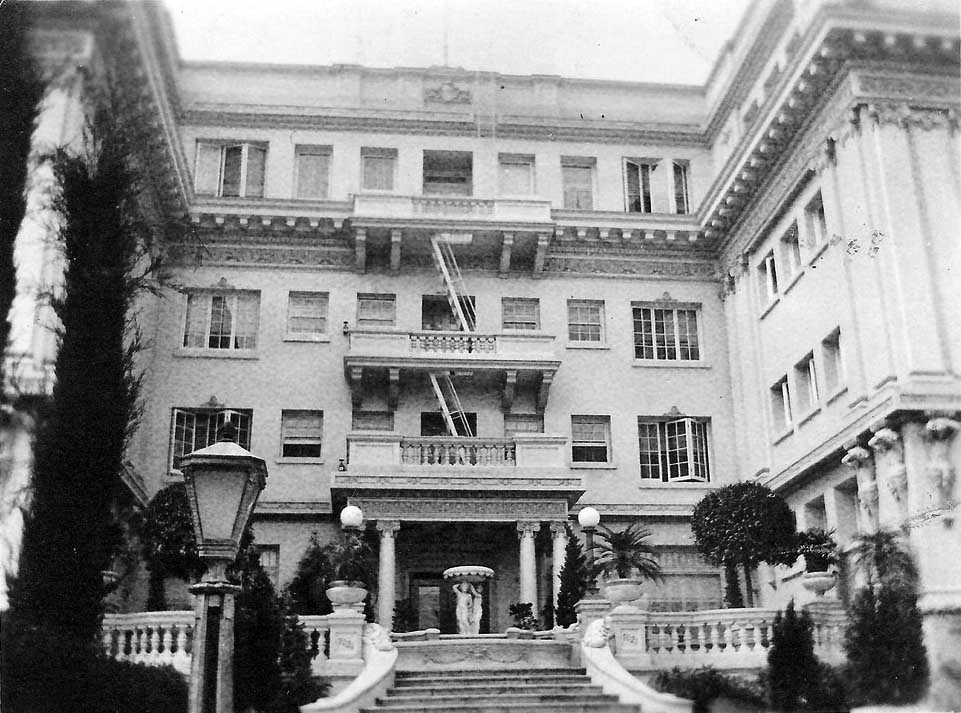 |
|
| (n.d.)*# - View of the front entrance to the Garden Court Apartments. A beautiful staircase leads to a fountain containing two figures holding up a bowl. |
Historical Notes The building was noted in the National Register of Historic Places in 1981, however, that did not prevent it from being razed in 1984.*^ |
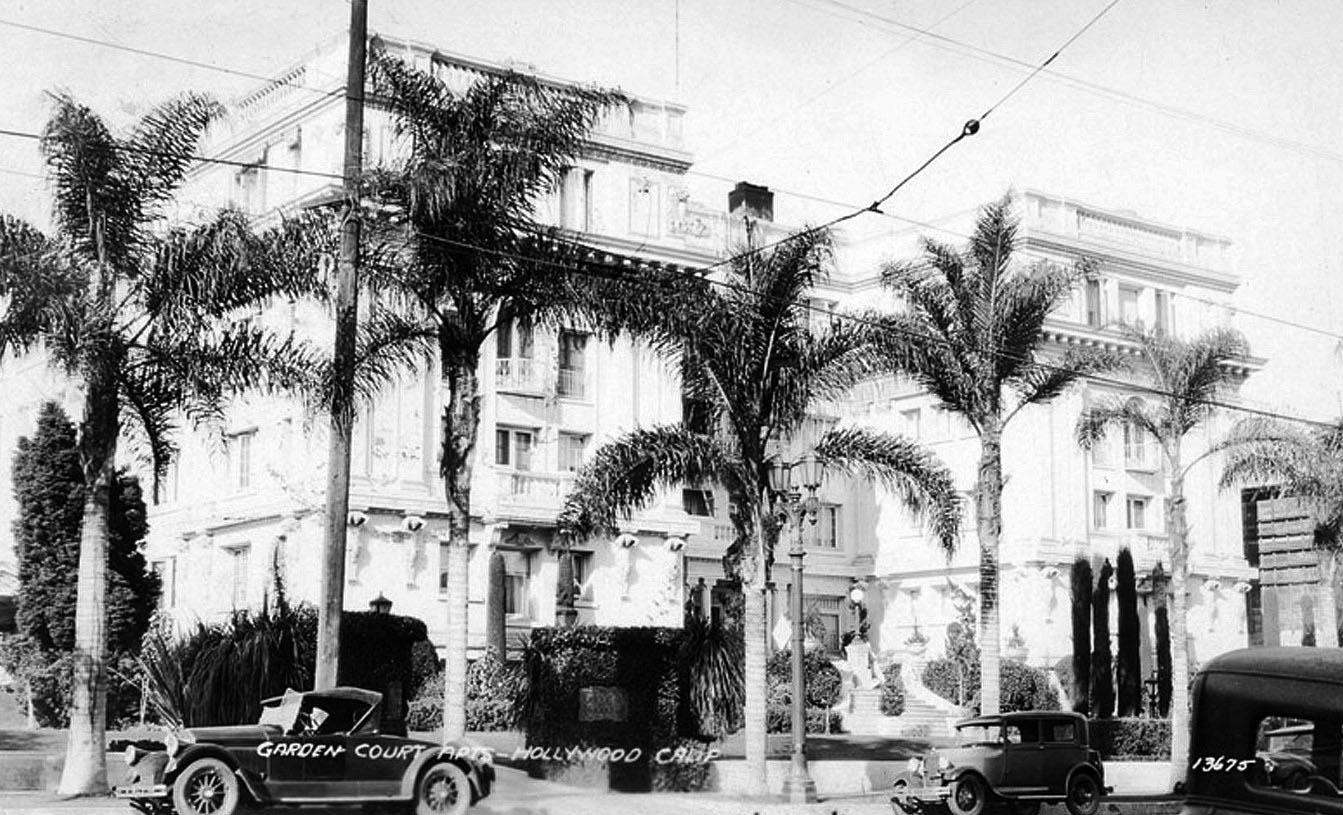 |
|
| (ca. 1931)^ - Postcard view of the Garden Court Apartments. The building was built in 1919, and was the home to many showbiz personalities. |
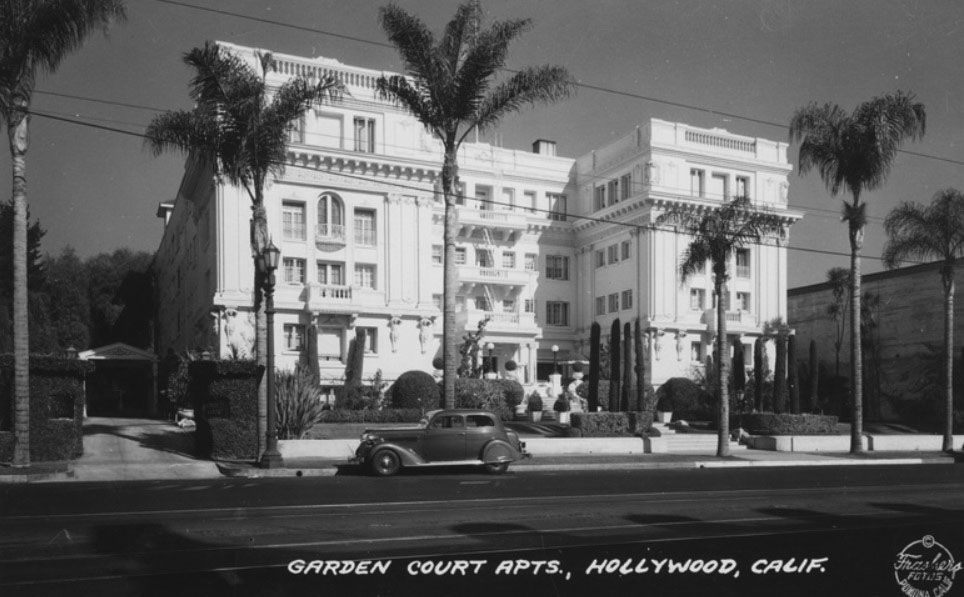 |
|
| (1940s)^ – Postcard view showing the Garden Court Apartments, Hollywood. |
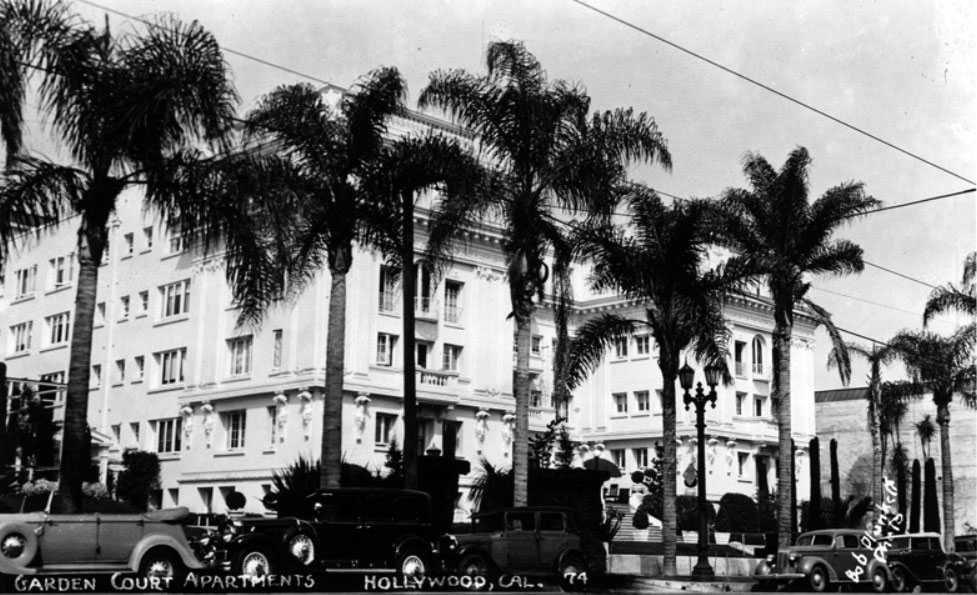 |
|
| (ca. 1947)^ – Postcard view showing the Garden Court Apartments, Hollywood. Note how the palm trees have developed. |
Historical Notes Though celebrities such as Mack Sennett, Jed Prouty, and others lived there in the 1930s and 1940s, the building began a slow decline, renting space to an eclectic series of groups to pay the bills. The Church of Ataraxia held meetings there under the direction of Rev. Pearl I. Barnes, who offered flower readings and medium services. |
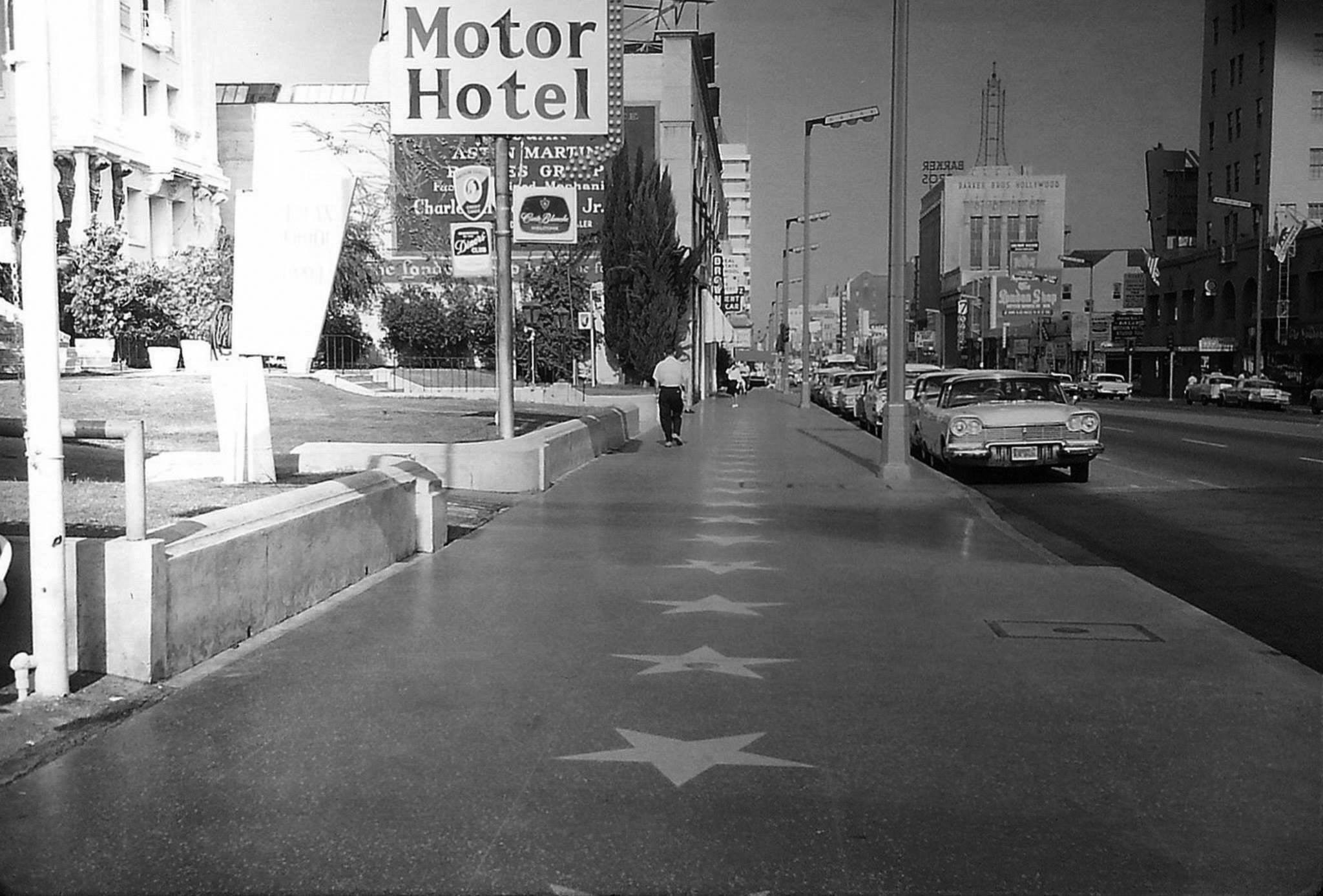 |
|
| (1960s)^ – View looking east on Hollywood Boulevard in front of the Garden Court Apartments/Motor Hotel. |
Historical Notes The Garden Court Apartments’ fortunes declined in the 1960s and 1970s along with those of Hollywood Boulevard in general. After being vacated in 1980, it was inhabited by homeless squatters and nicknamed "Hotel Hell". |
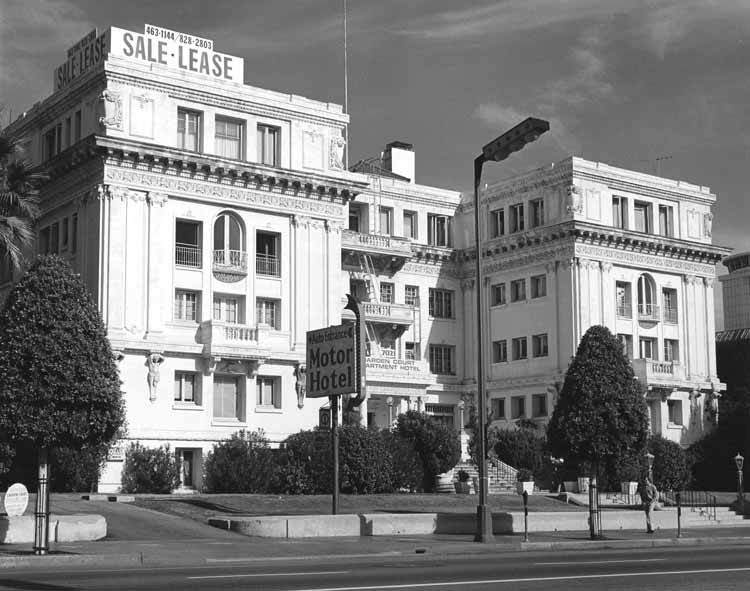 |
|
| (1976)^ - View of the Garden Court Apartments (Hotel) on Hollywood Blvd. Sign in front of building reads Motor Hotel. Note the decorative three-lamp streetlight in front of the building. |
Historical Notes The hotel was given landmark status in April of 1981 in an attempt to save it from demolition. The owner, however, vowed to tear down the hotel in 1982, so he did everything he could to ruin the building even further than it already was -- and that is saying something. The city council eventually revoked its landmark status and in 1984, it was torn down. |
Hillview Apartments (today, Hudson Apartments)
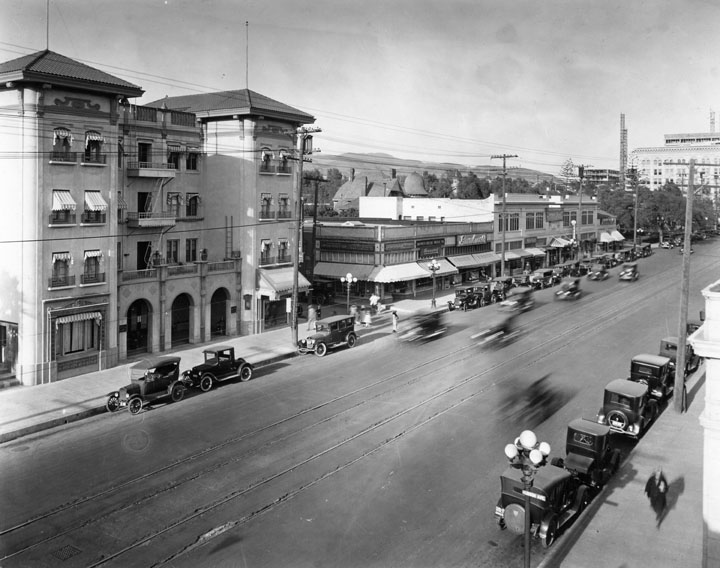 |
|
| (1930)* - Looking east on Hollywood Blvd. from Hudson Avenue. Cars driving in the middle of the street are blurred because of motion. On the left side of the street is the Hillview Apartment Building, located at 6531 Hollywood Blvd. |
Historical Notes The Historic Hillview Hollywood is considered Hollywood's first "artist's" high-rise. It was founded in 1917 by movie moguls Jesse L. Lasky, co-founder of Paramount Pictures, and his brother-in-law Samuel Goldwyn, co-founder of Metro-Goldwyn-Mayer, better known as MGM. It was one of Hollywood's only apartment buildings at the time willing to rent to aspiring actors since they were considered a financial risk by most apartment building owners. In fact, it catered specifically to actors.*^ |
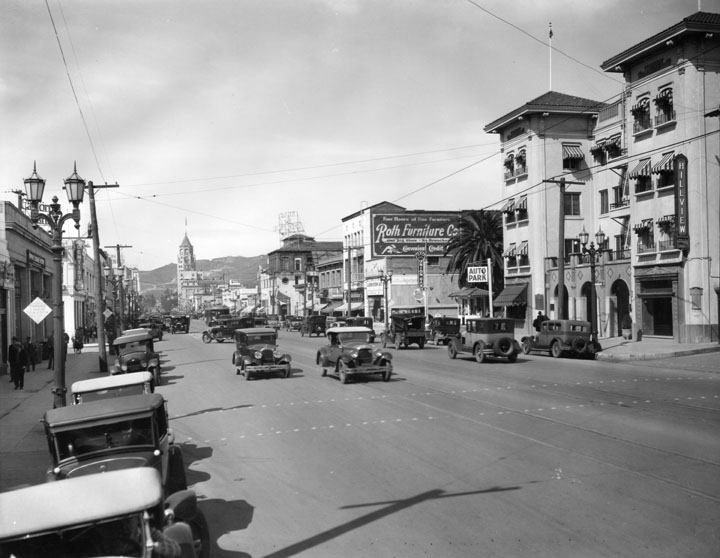 |
|
| (1930)* - Looking west on Hollywood Blvd. from Hudson, the hills can be seen in the far distance. On the right is the Hillview Apartment Building and beyond it the Roth Furniture building. The First National Bank Building can be seen in the background. |
Historical Notes The Hillview became a Hollywood hot spot in the 1920s and 1930s. The vast basement housed a rehearsal space until Rudolph Valentino reputedly converted it to a speakeasy. Former big-screen residents include Mae Busch, Stan Laurel, and Viola Dana. Charlie Chaplin was once a proprietor of the Hillview. Clara Bow found her first home at the Hillview in 1923.*^ |
 |
|
| (n.d.)^ – View showing the Hillview Apartments with a photo of silent film star Evelyn Brent overlaid on it. Photo courtesy of Bizarre Los Angeles |
Historical Notes When silent film star Evelyn Brent first arrived in Los Angeles in 1922, she stayed at the Hollywood Hotel. A short time later, she and her new husband, Bernie P. Fineman, moved to the Hillview Apartments at 6531 Hollywood Blvd (now 6533). One unusual story occurred in 1923, while Brent was filming "Held to Answer." Apparently, she had a nervous breakdown brought on from exhaustion. Because her work on the film had not been completed, Brent offered to return to the studio to finish production, but her physician, Dr. Leo Schulman, confined her to bed. So, what do you suppose happened next? The director, Harold Shaw, took a film crew to the Hillview Apartments and shot Evelyn Brent's remaining scenes in her bedroom. Sadly, "Held to Answer" is a lost film. Source: Evelyn Brent by Lynn Kear with James King.^*^# |
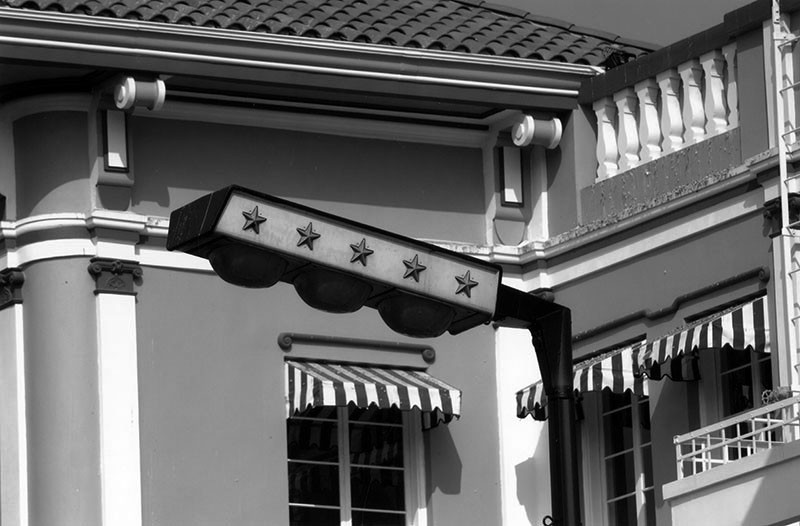 |
|
| (2005)* - Close-up view of a Hollywood Special streetlight embellished with five stars along the side of its lamp housing (Click HERE to see more in Early L.A. Streetlights). The building behind the streetlight is the Hudson Apartments (formerly The Historic Hillview Hollywood), a 54-unit apartment complex located at 6533 Hollywood Blvd. |
Historical Notes Originally constructed in 1917 for silent screen actors, the Hudson Apartments (formerly the Historic Hillview Hollywood) were fully renovated in 2006 and include both residential and retail tenants.* In October 2009 the corporation that owns the Hollywood Hillview Apartments filed for bankruptcy, and the Historic Hollywood Hillview was forced into foreclosure. The basement lounge club, the restaurant, and the gym have been closed since January 2009. The name was also changed to The Hudson Apartments. In July 2010 Hollywood real estate investment group CIM purchased the building out of foreclosure for $13,000,000.*^ |
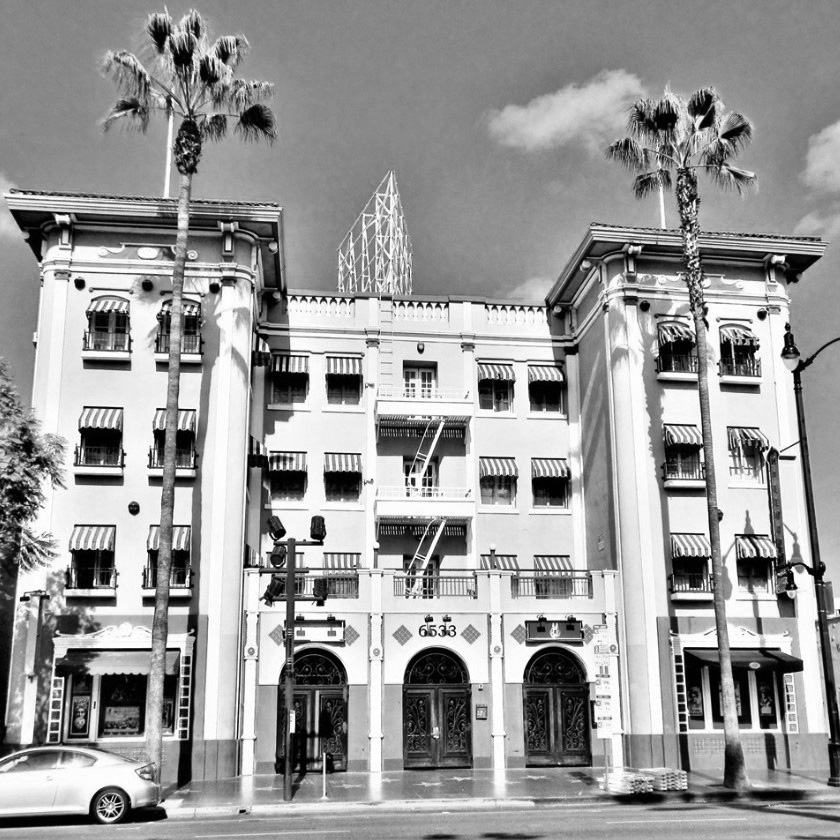 |
|
| (2019)^.^ - Hudson Apartments (formerly Hillview Apartments) located at 6533 Hollywood Boulevard ast it appears today. Photo by Howard Gray. |
* * * * * |
DWP Hollywood Branch Office
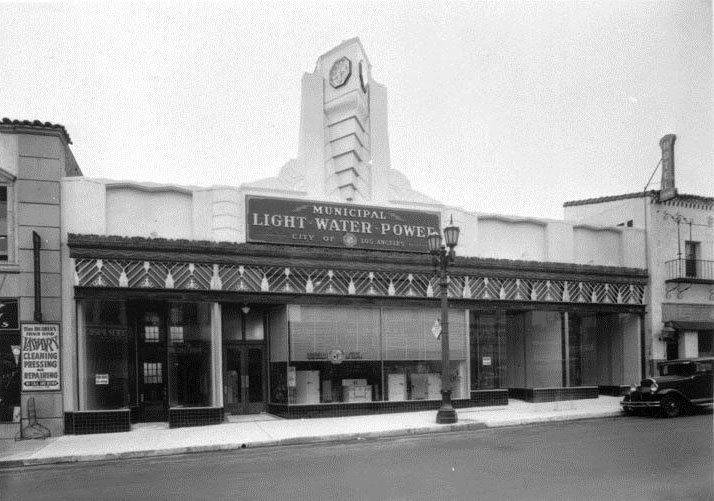 |
|
| (1932)* - Exterior view of the Municipal Light-Water-Power (later DWP) Hollywood branch office located at 1613 North Cahuenga Boulevard. |
Historical Notes In 1902, Los Angeles formed its first municipal water utility and named it the Water Department. Nine years later the Bureau of Power and Light came along. A total of six different names have been used to refer to the two separate water and power organizations since that time. Not until 1937 did both organizations merge and become the Department of Water and Power. Click HERE to see more in DWP - Name Change Chronology. |
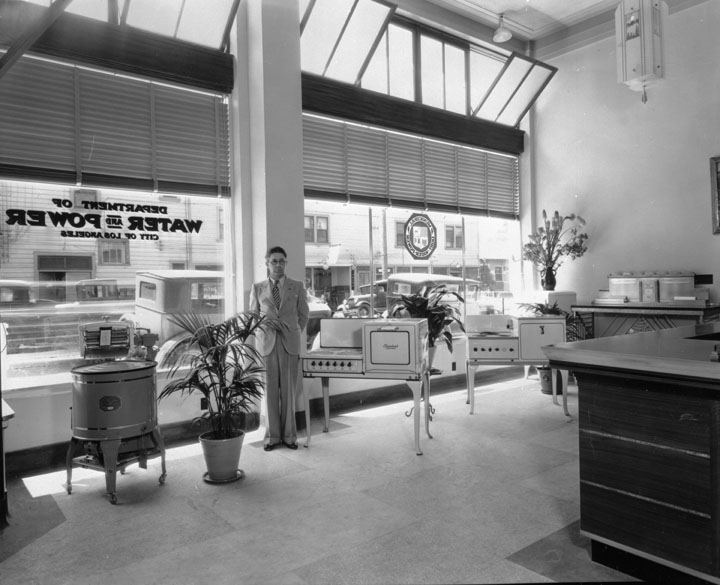 |
|
| (ca. 1937)* - A salesman is standing next to the electric range display at the Hollywood DWP Branch office on Caheunga. |
Historical Notes For decades DWP was in direct competition with the Souhern California Gas Co. They promoted the use of electricity by putting on display electric ranges, electric refrigerators and smaller electric appliances in most of their commercial branch offices. Click HERE to see more in Early DWP Branch Offices. |
J. J. Newberry Co.
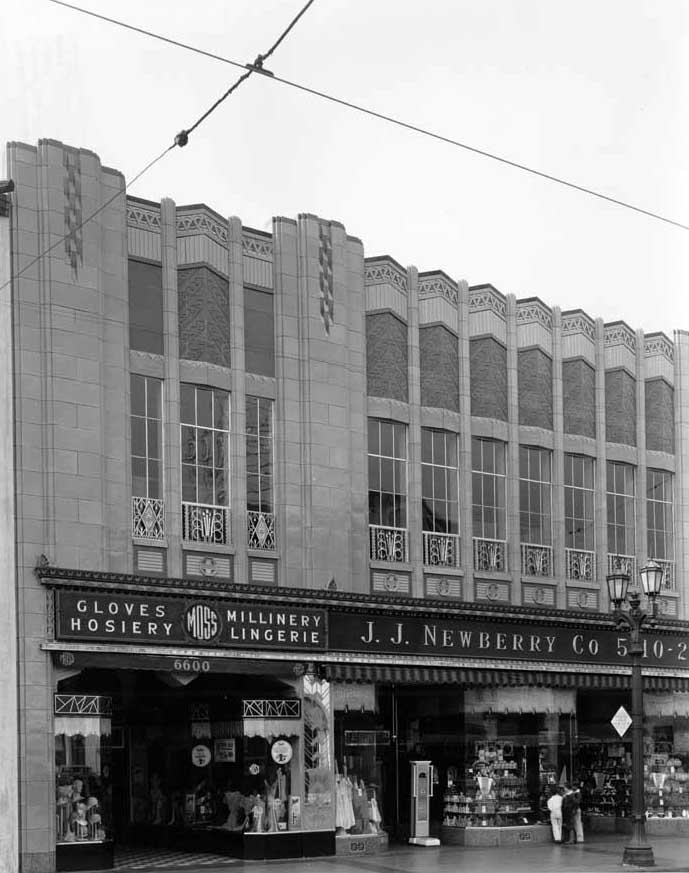 |
|
| (ca. 1932)^^^ - View of the J.J. Newberry Co. Store on Hollywood Boulevard. Three young boys are seen looking at a display through the window. |
Historical Notes J.J. Newberry's was an American Five-and-Dime store chain in the 20th century originally founded in Stroudsburg, Pennsylvania. The company was a family business. J.J. Newberry was joined in management by his brothers C.T. Newberry and Edgar A. Newberry in 1919, at which time there were 17 stores with yearly sales of $500,000.*^ |
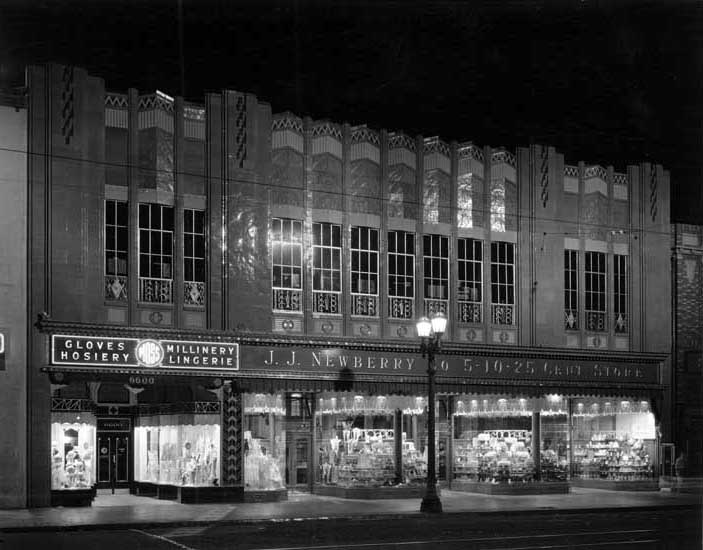 |
|
| (ca. 1932)^^^ - Nighttime view of the J. J. Newberry Co. 5-10-25 Cent Store located at 6600-04 Hollywood Boulevard. |
Historical Notes Over the years, the Newberry chain acquired other stores including Hested in Wyoming, Missouri, North Dakota, Colorado, and Nebraska, and Lee Stores in South Dakota, Minnesota, and Iowa. At the time of founder J.J. Newberry's death (1954), the chain had 475 stores. By 1961, the company operated 565 stores with total yearly sales of $291 million. The chain also operated a larger department store called Britt's Department Store. The Newberry chain was ultimately purchased by McCrory Stores, and then folded slowly as McCrory's downsized and eventually entered bankruptcy. 300 McCrory stores, mostly Newberry's, closed in 1997.*^ |
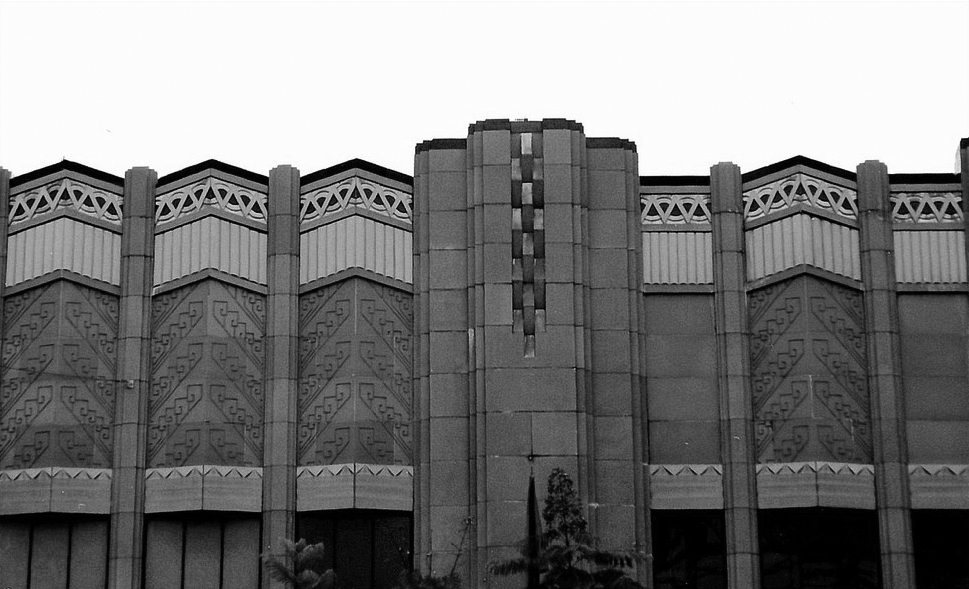 |
|
| (2010)^##* – View showing the Art Deco façade of the Newberry Building on Hollywood Boulevard. Photo by Bill Badzo |
Historical Notes The architects of the Hollywood J.J. Newberry's, now Hollywood Toys and Costumes, created this colorful example of Art Deco at its best. The "Zig Zag" patterns of chevrons and squares in colorful aqua and gold highlight the over-sized industrial windows of the upper stories. #^^ |
 |
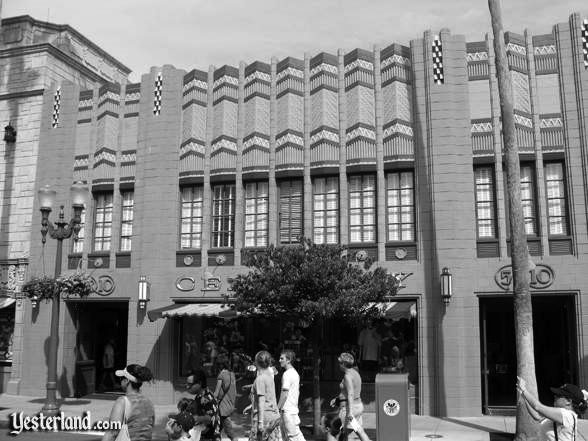 |
|
| (ca. 1932)^*# - Nighttime view showing the J. J. Newberry Co. 5-10-25 Cent Store located at 6600-04 Hollywood Boulevard. | (2008)^v^ – View showing the Celebrity 5 & 10 building on Disney’s Hollywood Boulevard at the Disney’s Hollywood Studios theme park near Orlando, Florida. |
Historical Notes The Walt Disney Imagineers were inspired by the 1928-built J.J. Newberry Building when they designed their Celebrity 5 & 10 building on Disney’s Hollywood Boulevard at the Disney’s Hollywood Studios theme park near Orlando, Florida. |
Sardi's Restaurant
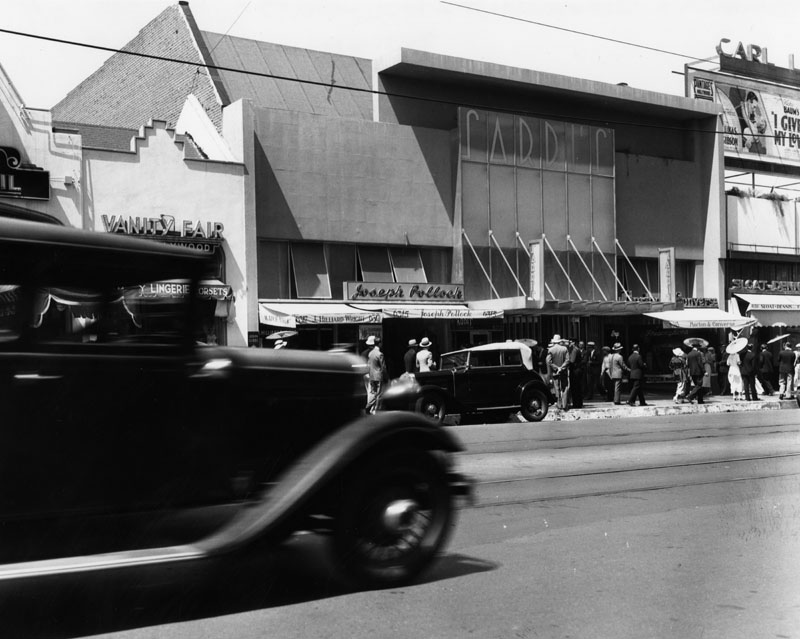 |
|
| (ca. 1934)* - An exterior view of Sardi's Restaurant and Night Club, located at 6313 Hollywood Blvd. Other businesses, including: Vanity Fair, Joseph Pollock and Sloat-Dennis Furniture are also visible. The Pacific Electric street car tracks are visible in the center of the image and in the background there is a billboard advertising the 1934 film, "I Give My Love", starring Paul Lukas and Wynne Gibson. |
Historical Notes Sardi’s restaurant opened in 1932 and was the sister of New York’s Sardi’s. It was designed by the world-renowned architect Rudolph Schindler in International style with metal and glass. This was a favorite restaurant of many stars including Charlie Chaplin, Maurice Chevalier, Wallace Beery, Marlene Dietrich and Joan Crawford.^#^# |
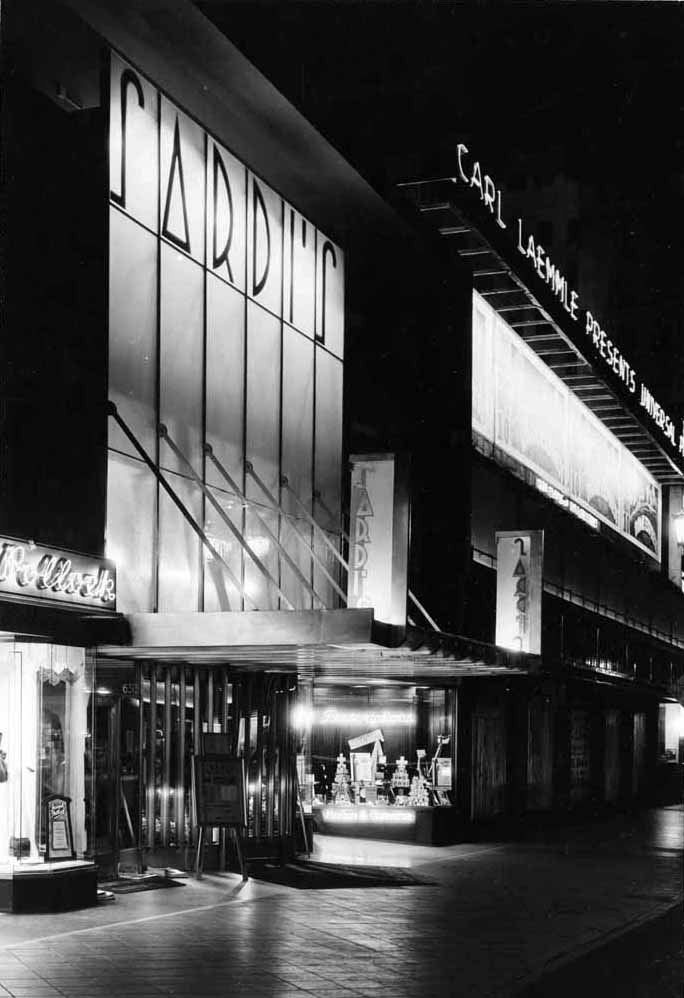 |
|
| (ca. 1935)^^^ - Nighttime view of Sardi's on Hollywood Boulevard. The restaurant appears to be closed. The lit signboard to the right reads: "Carl Laemle Presents: __ " |
Historical Notes Eddie Brandstatter was "Host of Hollywood" and catered to Hollywood stars in the 1920s and 1930s. He was owner and manager of the fashionable Montmartre Café, Embassy Club and Sardi's.* |
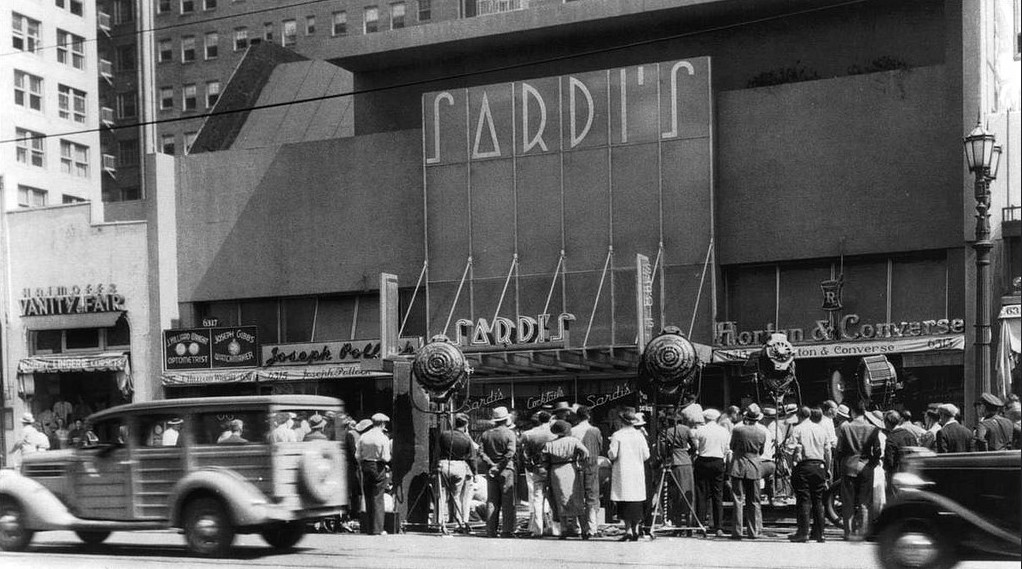 |
|
| (1936)^##* – View showing the filming of a movie in front of Sardi’s Restaurant on Hollywood Boulevard. |
.jpg) |
|
| (1937)* - View showing a woman getting out of a car in front of Sardi's Restaurant on Hollywood Boulevard. Neighboring businesses, include J. Hilliard Wright, Horton & Converse and Sloat-Dennis Furniture. Pacific Electric streetcar tracks run down the boulevard. Photo by Herman J. Schultheis. |
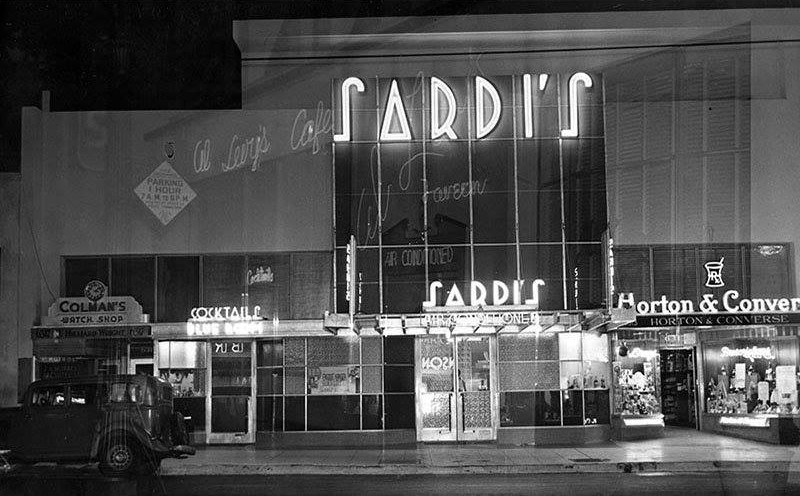 |
|
| (ca. 1938)#**# – Night time view of Sardi’s Restaurant on Hollywood Boulevard. On the left is the Blue Room Cocktail Bar and to the right is the Horton & Converse Pharmacy. |
Historical Notes Radio personality Tom Breneman was in Hollywood having lunch in 1940 with friends at Sardi's Restaurant when he realized the location's potential for a radio program. He quickly found an audience when he began broadcasting his Breakfast on the Boulevard January 13, 1941, on KFWB Los Angeles. Breakfast at Sardi's aired on the Blue Network from August 3, 1942, until February 26, 1943, when the title was changed to Breakfast in Hollywood, to avoid confusion with Sardi's in New York.*^ |
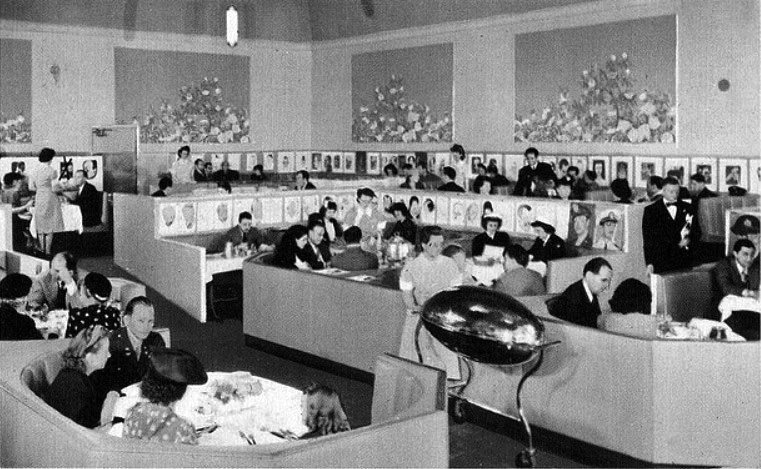 |
|
| (1944)^^#* – Postcard interior view of Sardi’s Restaurant, located at 6313 Hollywood Boulevard. |
Historical Notes Verso reads: "In the heart of glorious Hollywood -- just a whisper away from Hollywood Blvd. and Vine St. -- stands Sardi's, mecca of Hollywood filmites and Southern California socialites. Here world-famous stars, producers, writers and studio executives gather daily for luncheon and dinner. For it's "Breakfast at Sardi's" national broadcast...the renowned restaurant plays host to Southern California visitors from the world over." |
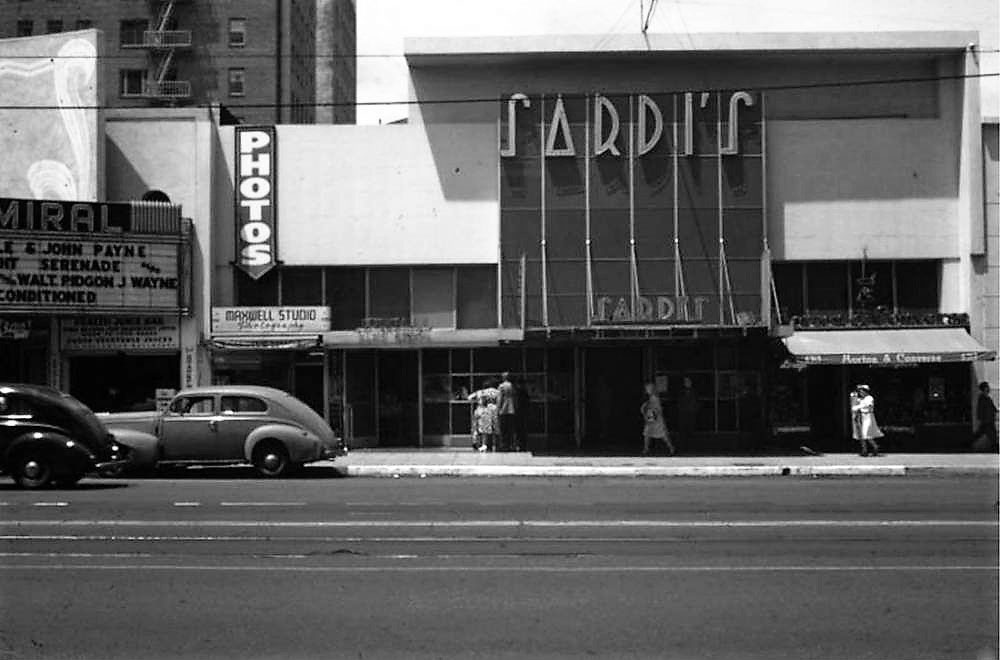 |
|
| (1942)^ – Daytime view of Sardi’s Restaurant as seen from across Hollywood Boulevard. The Admiral Theatre can be seen on the left. |
Historical Notes After Sardi’s closed, it later became a Chi-Chicago restaurant, and then in the 1950s it became Zardi's Jazzland. Today, the building is occupied by Le Sex Shoppe and the Cave Theater. Click HERE for contemporary view.. |
* * * * * |
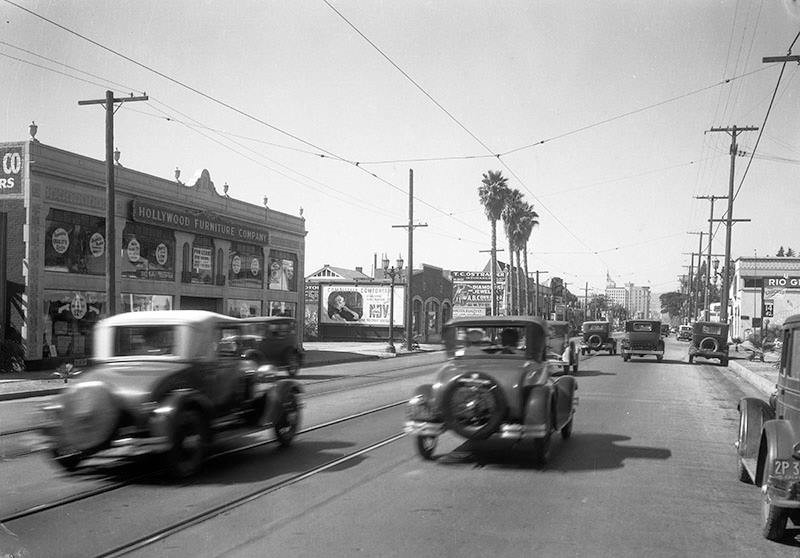 |
|
| (1933)* - View looking west down Hollywood Boulevard from Van Ness Avenue. Various businesses, including Hollywood Furniture Company at 5816 (left), are present on both sides of the boulevard. |
Historical Notes The intersection of Hollywood and Van Ness was drastically changed when the 101 Freeway was built; many of the structures seen here have since been demolished.* |
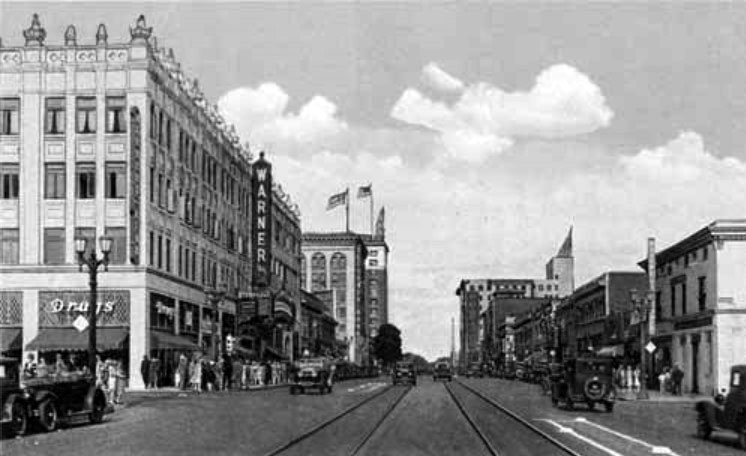 |
|
| (ca. 1930)##^* – Postcard view looking east on Hollywood Boulevard. The Warner Bros.Theatre is seen at left on the northeast corner of Hollywood Boulevard and Wilcox Avenue. |
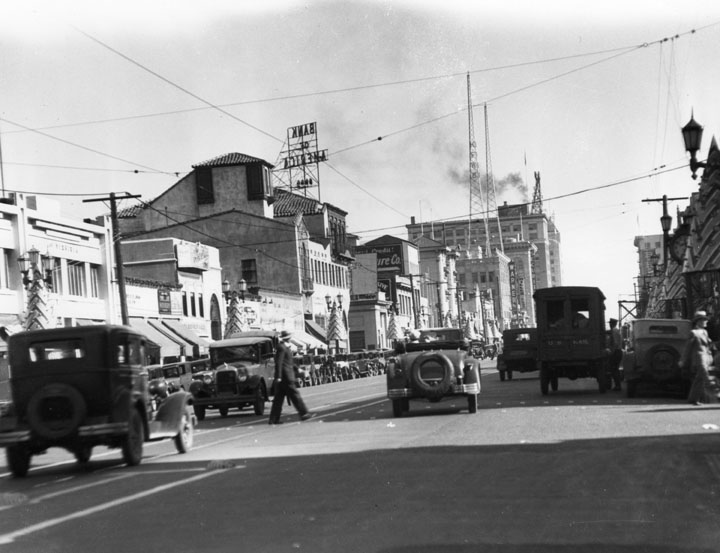 |
|
| (1930)* - A view looking east of Hollywood Boulevard from the pedestrian level with cars both parked and moving down the street, a pedestrian crossing in the middle and various businesses. A radio tower with "KFWB" on it, and Christmas tree decorations along the sidewalk can be seen. |
Historical Notes KFWB's history goes back to 1925, when it was launched by Sam Warner, a co-founder of Warner Brothers. The station launched the careers of such stars as Ronald Reagan and Bing Crosby. The station was the first to broadcast the annual Rose Parade in Pasadena. The original KFWB studios and transmitter location were at the Warner Bros. Studios, which is now KTLA, at 5800 Sunset Boulevard. One of the two original towers still stands prominently out front. Due to RF interference getting into the movie studio's "talkies" sound equipment, the transmitter was moved in 1930 to the roof of the Warner Theater, now the Hollywood Pacific Theatre, at 6423 Hollywood Blvd. Eventually the studios were also moved to the Warner Theater. Those two towers are still there, as well.*^ |
Iris Theatre (today Fox Theatre)
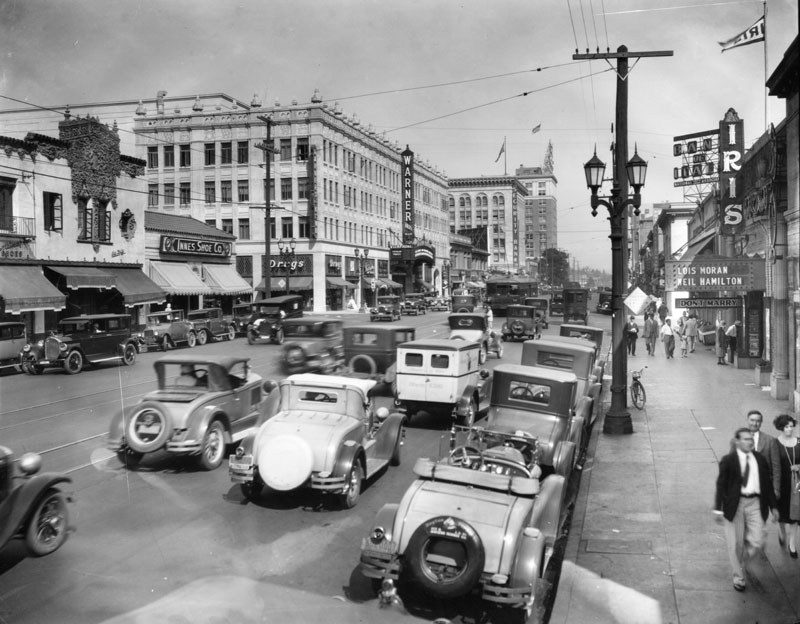 |
|
| (ca. 1930)* - View looking east on a busy Hollywood Boulevard near Wilcox Avenue. On the north side of the boulevard are the Innes Shoe Co., Warner Bros.Theatre and the Security Trust and Savings Bank; on the south side is the Iris Theater. Note: This view is prior to the installation of the KFWB towers on top of the Warner Bros. Theatre. |
Historical Notes The Iris Theatre opened in 1918, as the second theatre on Hollywood Boulevard. It was built by P. Tabor who employed architect Frank Meline, to design a Romanesque style theatre, with a brick façade.^^* The distinction of being the first movie theater in Hollywood goes to the Idyl Hour Theater. Located at 6525 Hollywood Boulevard, it was established in either late 1910 or early 1911. During its first year the theater was little more than a converted store with chairs, a projector and a screen. The Idyl Hour Theater, whose name changed to the Iris Theater in 1913, moved to 6415 Hollywood Blvd. in 1914, and to a new 1000-seat theater at 6508 Hollywood Blvd. in 1918.^##^ |
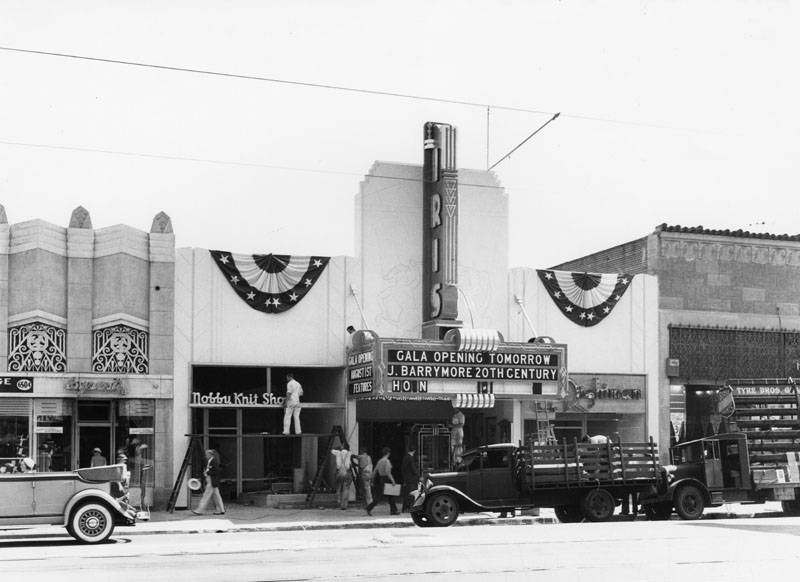 |
|
| (1934)* - Exterior view of the Iris Theater on July 31, 1934, located on Hollywood Blvd. west of Wilcox (6508 Hollywood Blvd). Its marquee announces an opening of J. Barrymore. Click HERE for contemporary view. |
Historical Notes The Iris theatre was redesigned by architect S. Charles Lee in July 1934 and was given an Art Deco style. That survived until 1955, when the current façade was erected and the name was changed to Fox Theatre.^^* Click HERE to see the Iris Theatre as it appeared in 1918 when it first opened. |
* * * * * |
YMCA (Hollywood)
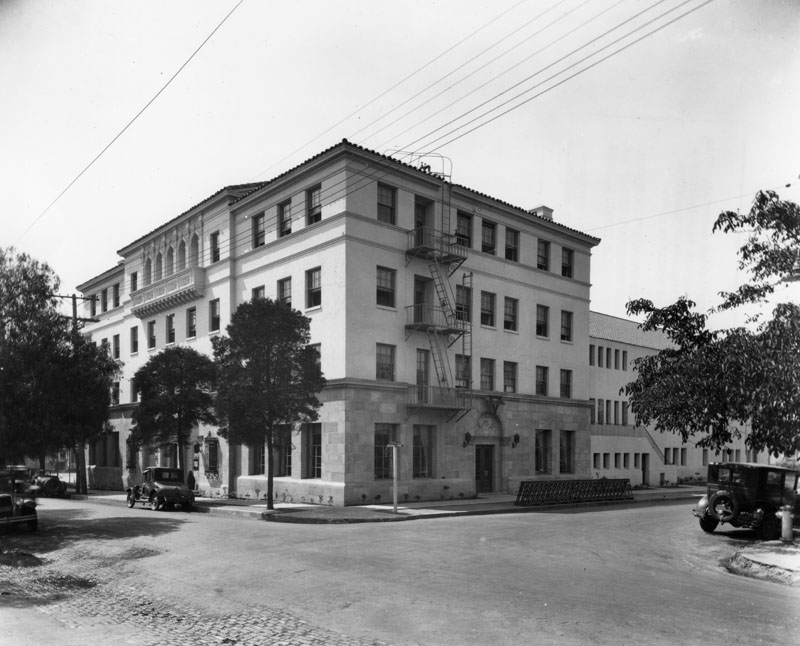 |
|
| (ca. 1934)* - Exterior corner view of the YMCA Spanish Colonial Revival style building located at 1553 N. Schrader Avenue in Hollywood. Bicycle racks are seen, as well as cars parked on the street, which is asphalt over brick paving. |
Historical Notes The Hollywood Y was one of many popular men's clubs built in 1920s Los Angeles that encouraged social, moral and physical development through physical fitness (This group also included the Athletic Club on Sunset Boulevard.) Built in 1921 on the undeveloped Thomas Hudson property, the original much smaller Hollywood YMCA building was designed by the Los Angeles architectural firm Hunt and Burns.*^*^ The building was expanded in 1928, architect Paul Williams. Click HERE for contemporary view. |
* * * * * |
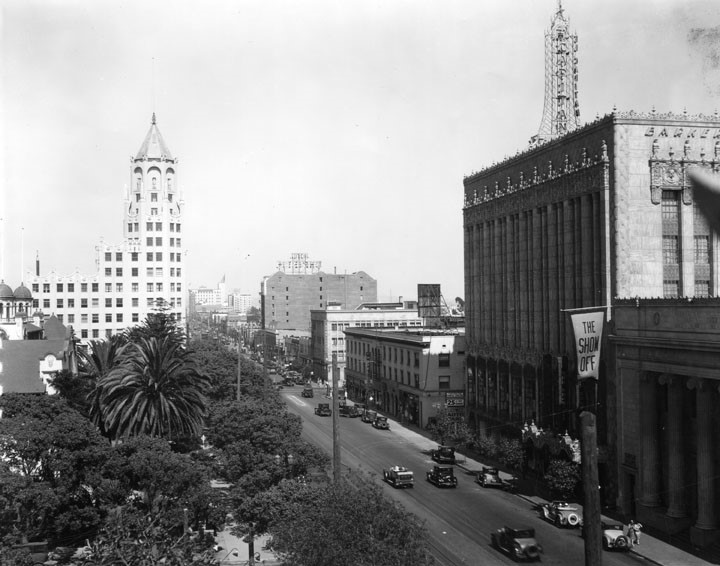 |
|
| (ca. 1935)* - View looking east on Hollywood Boulevard. Trees and plants in the lower left are in front of the Hollywood Hotel. Across Highland Avenue stands the iconic tower of the First National Bank. In the distance at center of photo is the eight-story Christie Hotel which was considered Hollywood's first skyscraper when it opened in 1922. On the right is the El Capitan Theatre with a flag reading "The Show Off". Next to it in the lower right is the Hollywood Masonic Temple. |
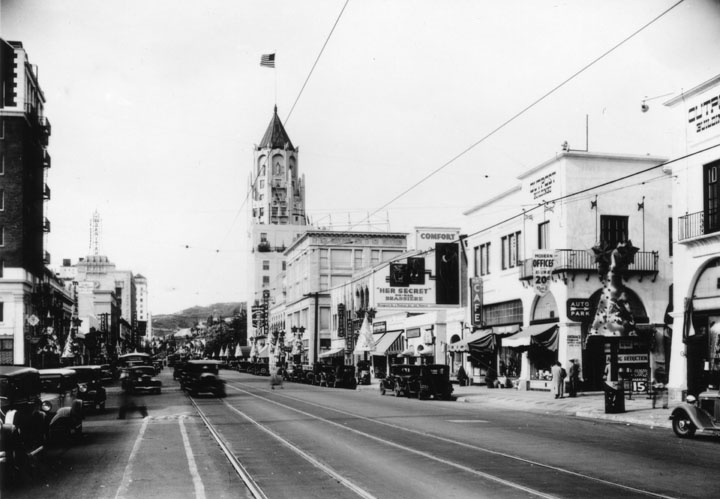 |
|
| (ca. 1935)* - Looking west on Hollywood Blvd. from McCadden Place. This photo was made during Christmas and Christmas tree decorations can be seen on the light standards along the street. In the distance on the right is the First National Bank of Los Angeles, Hollywood Branch, designed by Meyer and Holler, architects at the Milwaukee Building Company. |
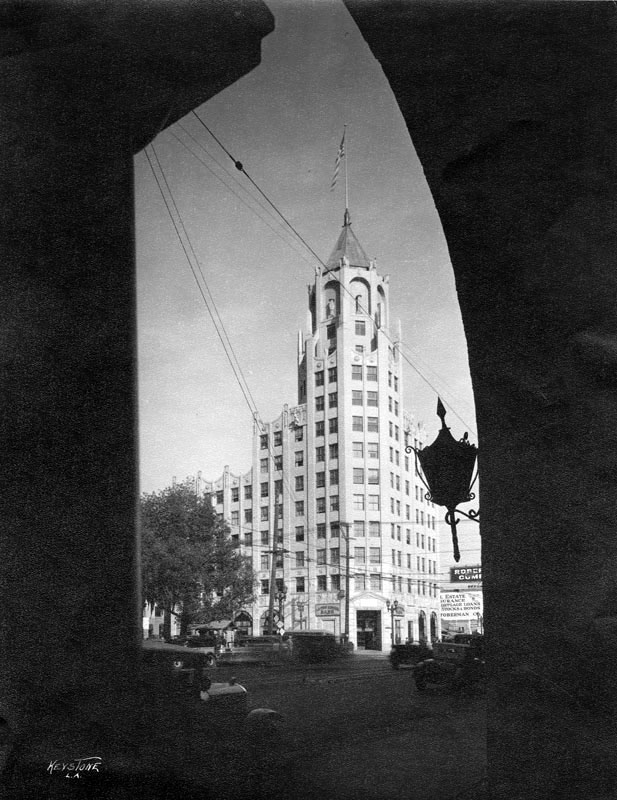 |
|
| (1935)* - Northeast corner of Highland and Hollywood Blvd. showing the facade of the First National Bank of Los Angeles, Hollywood Branch which is topped by a tower decorated with sculptures in arched niches and a flagpole. |
Mar-Cal Theatre (later World Theatre)
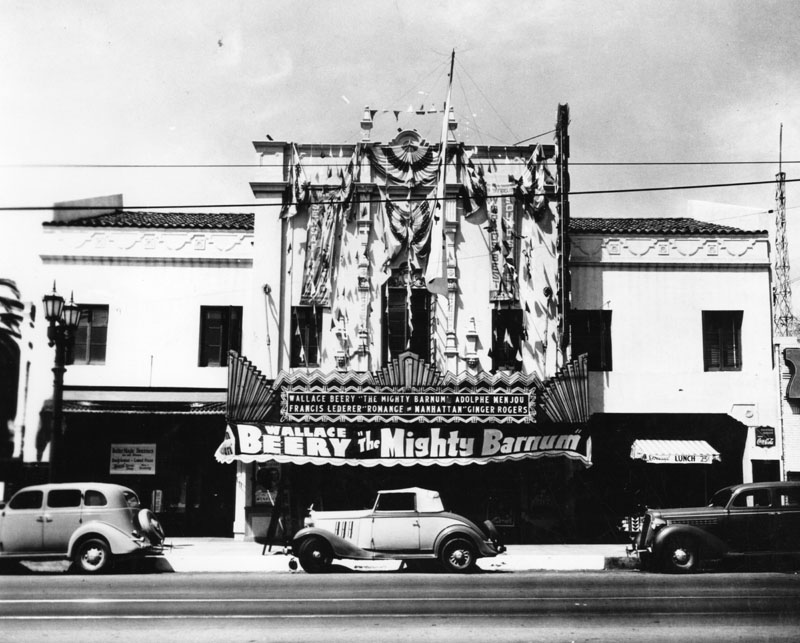 |
|
| (1935)* - View of the exterior of the Mar-Cal Theatre (later renamed the World Theatre), located at 6025 Hollywood Blvd. The film, Mighty Barnum, is presently showing. |
Historical Notes Originally opened in 1925 as the Mar-Cal Theatre, it later was operated by Pacific Theatres as the World Theatre. In its later years the theater showed second-run features in a triple bill for bargain prices. It closed in the Summer of 1986. ^^* |
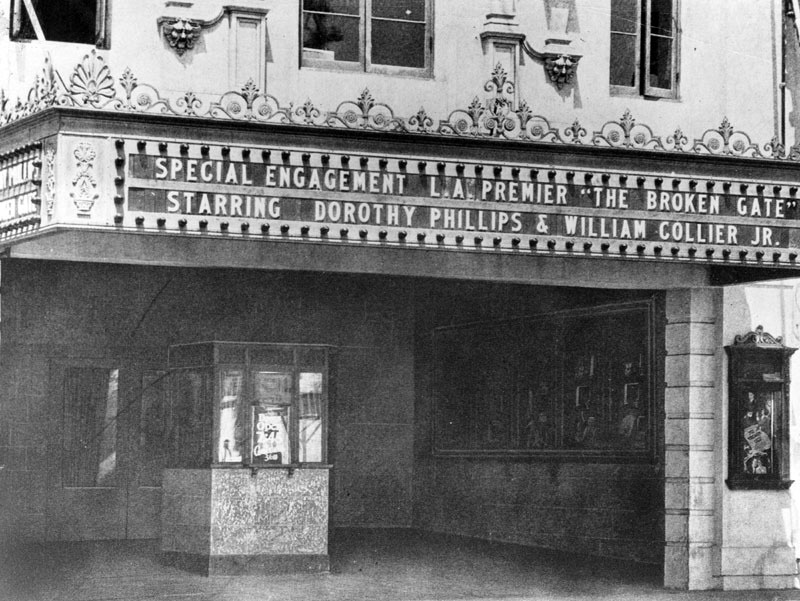 |
|
| (ca. 1926)* - Marquee of the Mar-Cal Theatre (later renamed the World Theatre) featuring "The Broken Gate" with Dorothy Phillips and William Collier Jr. |
Historical Notes Today the much altered building is in use as a nightclub. Click HERE for contemporary view. |
Vogue Theatre
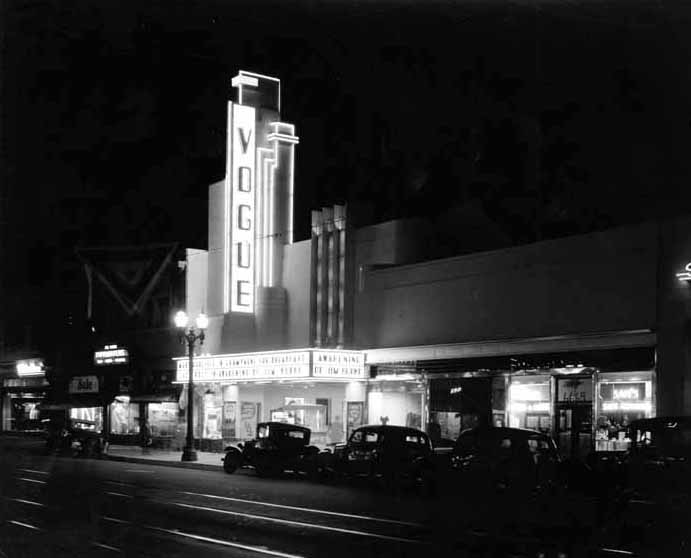 |
|
| (ca. 1935)^ - View of the Vogue Theatre located at 6675 Hollywood Boulevard. |
Historical Notes Designed by noted theatre architect S. Charles Lee, the Vogue Theatre opened on July 16th, 1935 with a seating capacity of 897, all on one floor. The Vogue Theatre was run by Fox West Coast Theatres for many years until Mann Theatres took over in the early-1990’s. One of the better mid-sized theatres on Hollywood Boulevard, the theatre is located on Hollywood Boulevard & North Las Palmas Avenue, across the next block from the Egyptian Theatre.* |
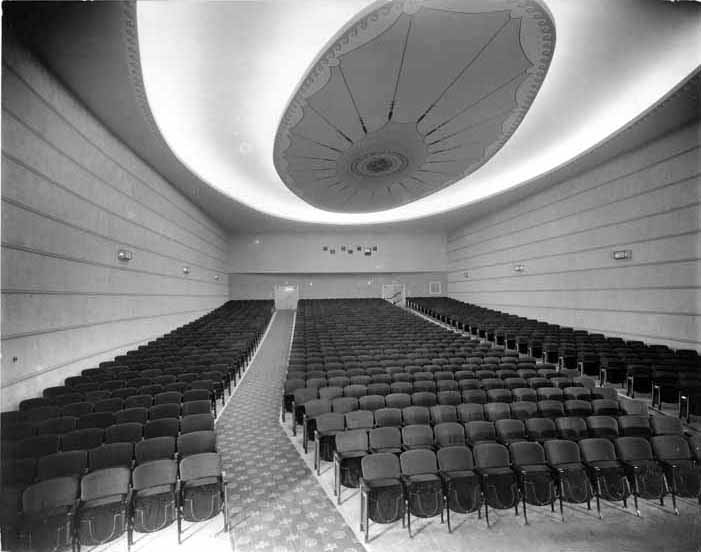 |
|
| (ca. 1935)^ - Interior view of the Vogue Theatre on Hollywood Boulevard with its unique oval ceiling fixture. |
Historical Notes Legend has it this theatre is haunted by a former projectionist, named Fritz, who once worked at the theatre. |
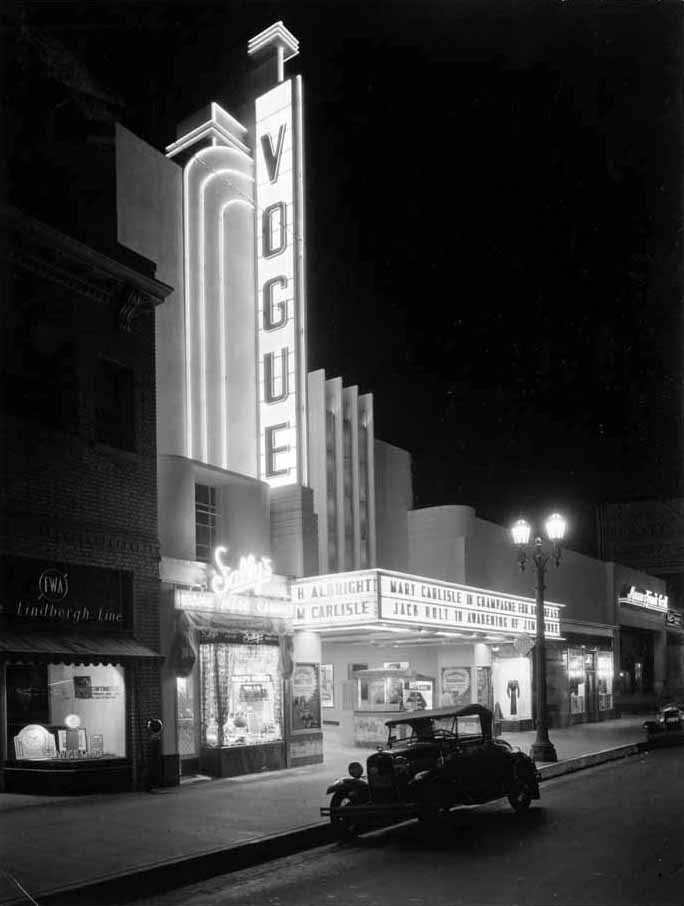 |
|
| (ca. 1935)^- The Vogue Theater marquee is lit for business. Two early model cars are parked in front. |
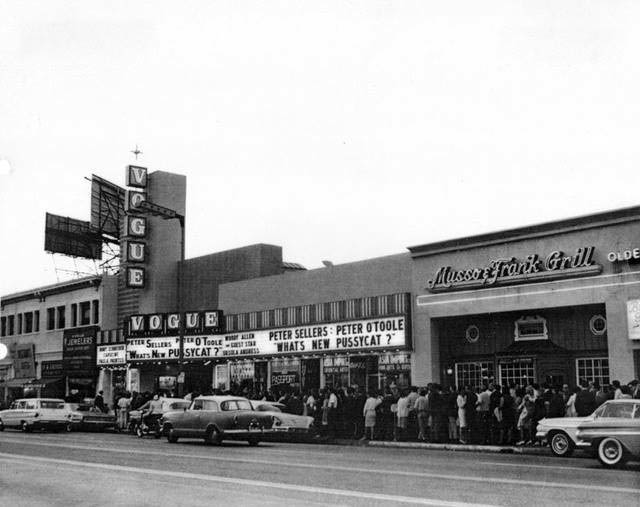 |
|
| (1965)* – A long line forms on Hollywood Blvd to see the release of “What’s New Pussycat?” playing at the Vogue. The line stretches east and crosses in front of Musso & Frank Grill. |
Historical Notes Vogue closed as a regularly operating movie theatre in 2001. The building reopened as a nightclub called Supperclub in 2010. Supperclub was an Amsterdam based company that was operating the venue as a music club, restaurant and performance space. The club closed in October 2015 The theatre reopened in March 2018 as a free museum called Screenbid, an offshoot of the online auction house ScreenBid.com. The project, a venture of the building owner Elie Samaha and his partners, featured artifacts from almost all the major film studios. On display were items about the history of film and other aspects of show business. Most of the items were available for purchase. The building was advertised as being available for lease beginning in early 2020.* |
* * * * * |
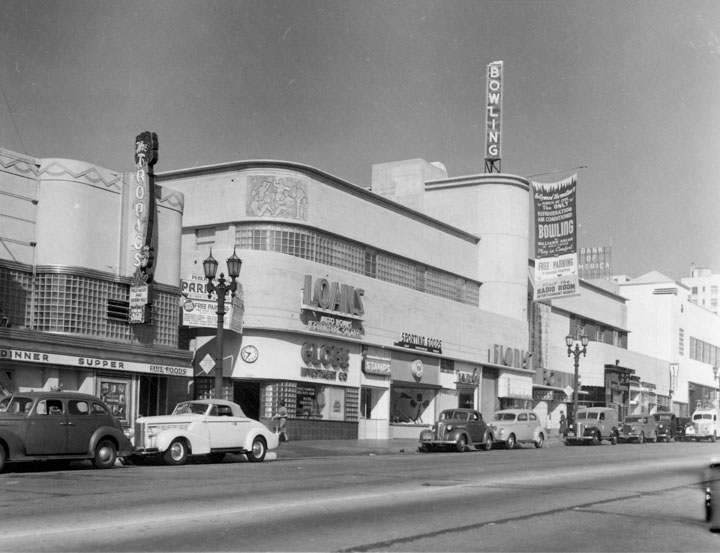 |
|
| (1936)* - View of a business district located on Vine Street in Hollywood. Cars are parked at the curb and establishments along the street include a bowling alley ("the only refrigeration air conditioned bowling"), Globe Investment Co., sporting goods, and florist shop. |
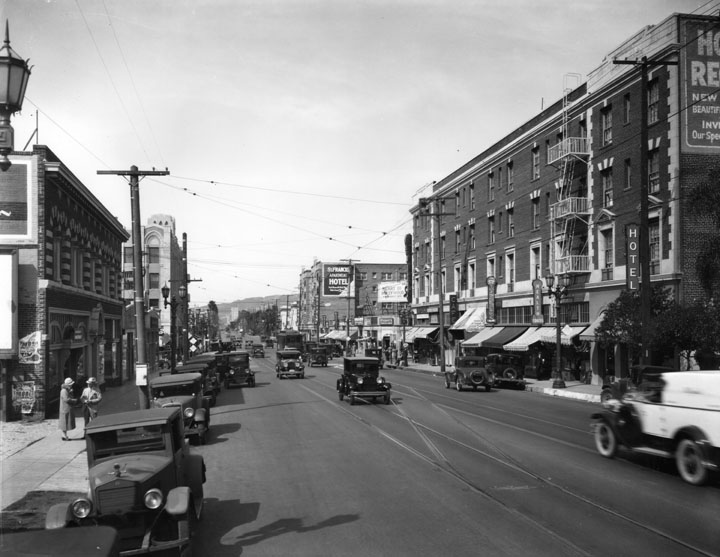 |
|
| (ca. 1930s)* - Hollywood Boulevard looking west toward Western Avenue. On the right is the Hotel Rector which sits on the northeast corner of Hollywood and Western. On the southwest corner of that intersection is the Hollywood-Western Building and further down the Gershwin Hotel (formerly the St. Frances Hotel). |
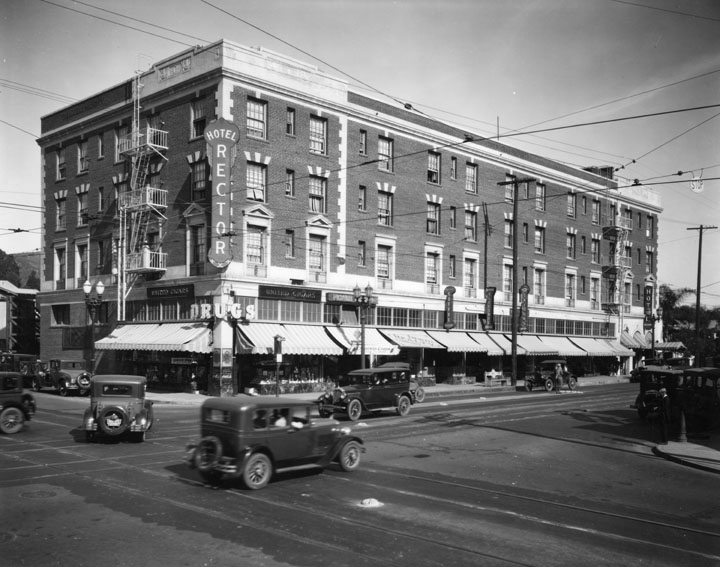 |
|
| (1930s)* - Exterior view of the Hotel Rector on the northeast corner of Hollywood and Western. |
Historical Notes The Hotel Rector was built in the 1920s. It provided rooms for stage and film actors and advertised daily rates at $1.50 to $2.* |
Hollywood Western Building
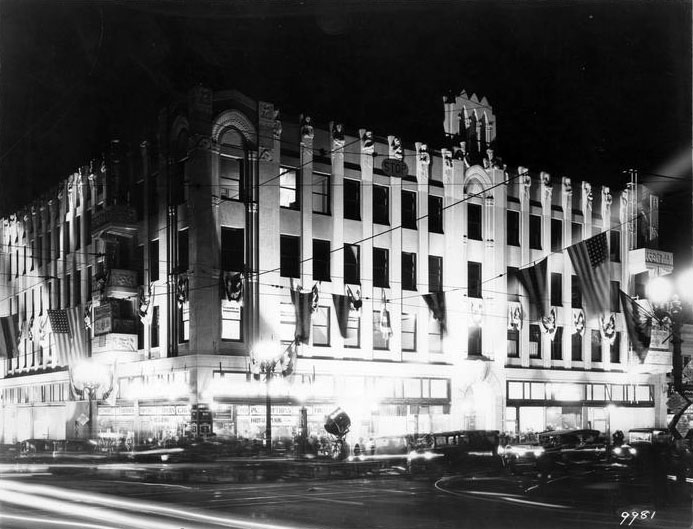 |
|
| (1928)^#^ - The grand opening of the Hollywood Western Building, 5500 Hollywood Blvd, on December 8th, 1928. |
Historical Notes The S. Charles Lee designed Hollywood Western Building, 5500-5510 Hollywood Blvd, was built in 1928. The building was financed by Louis B Mayer and Irving Thalberg for the Motion Picture Association of America (MPAA), including the Hays Office. The building also housed Central Casting.**## |
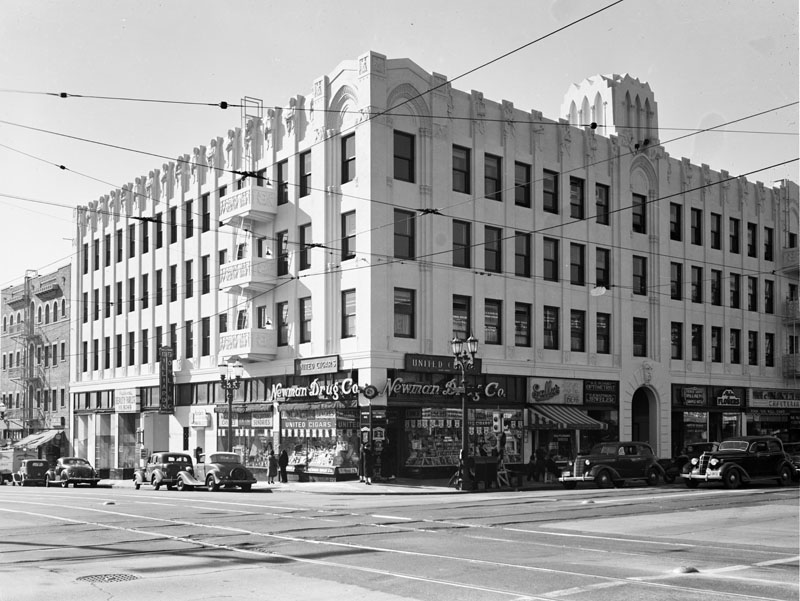 |
|
| (1940s)* - Exterior view of the four-story Hollywood-Western Building housing the Central Casting Corp. and various retail shops located on the southwest corner of Hollywood Blvd. and Western Avenue. Newman Drug Co. is on the corner. |
Historical Notes In 1988, the Hollywood Western Building was designated LA Cultural-Historic Monument No. 336 (Click HERE to see complete listing). |
* * * * * |
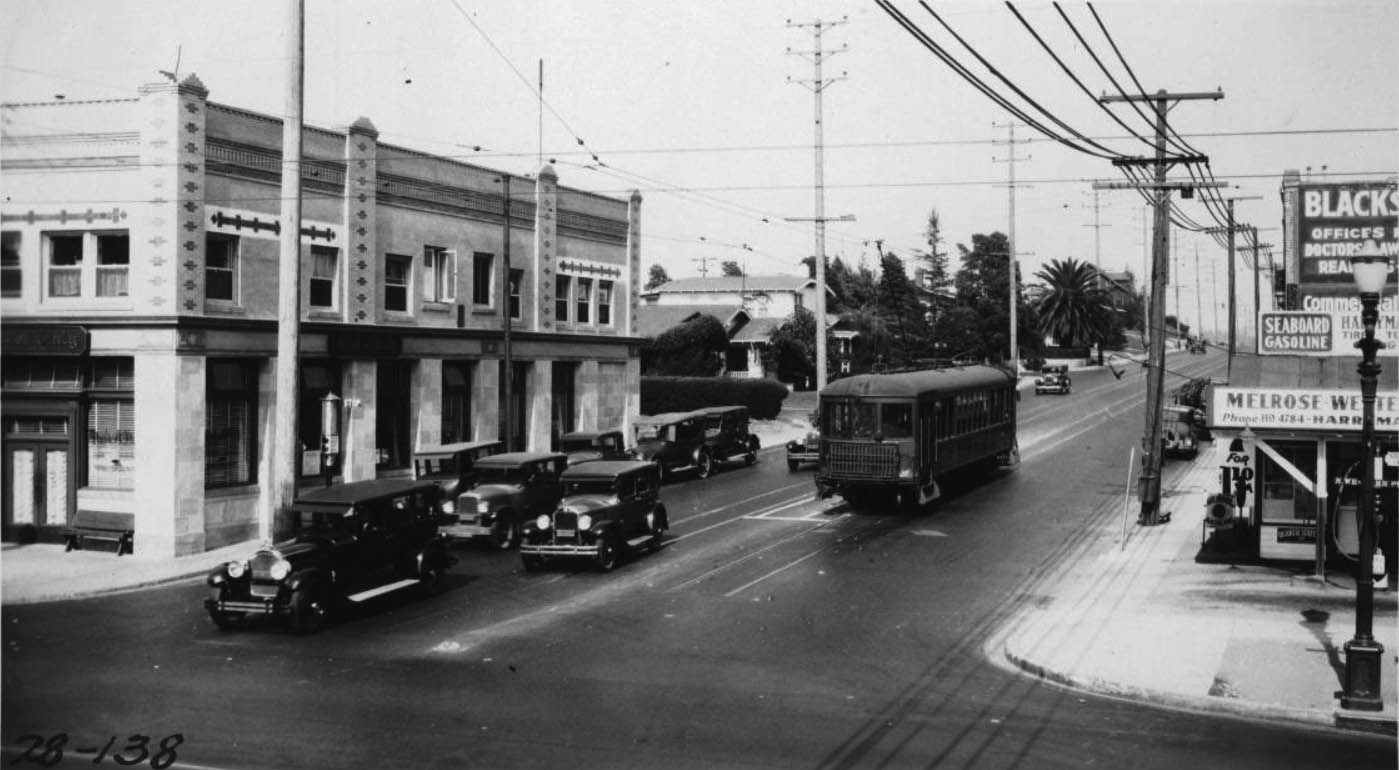 |
|
| (1928)*# - Panoramic view looking east on Melrose Avenue at Western Avenue. Cars share the road with a streetcar. |
West-Way Super Service Station
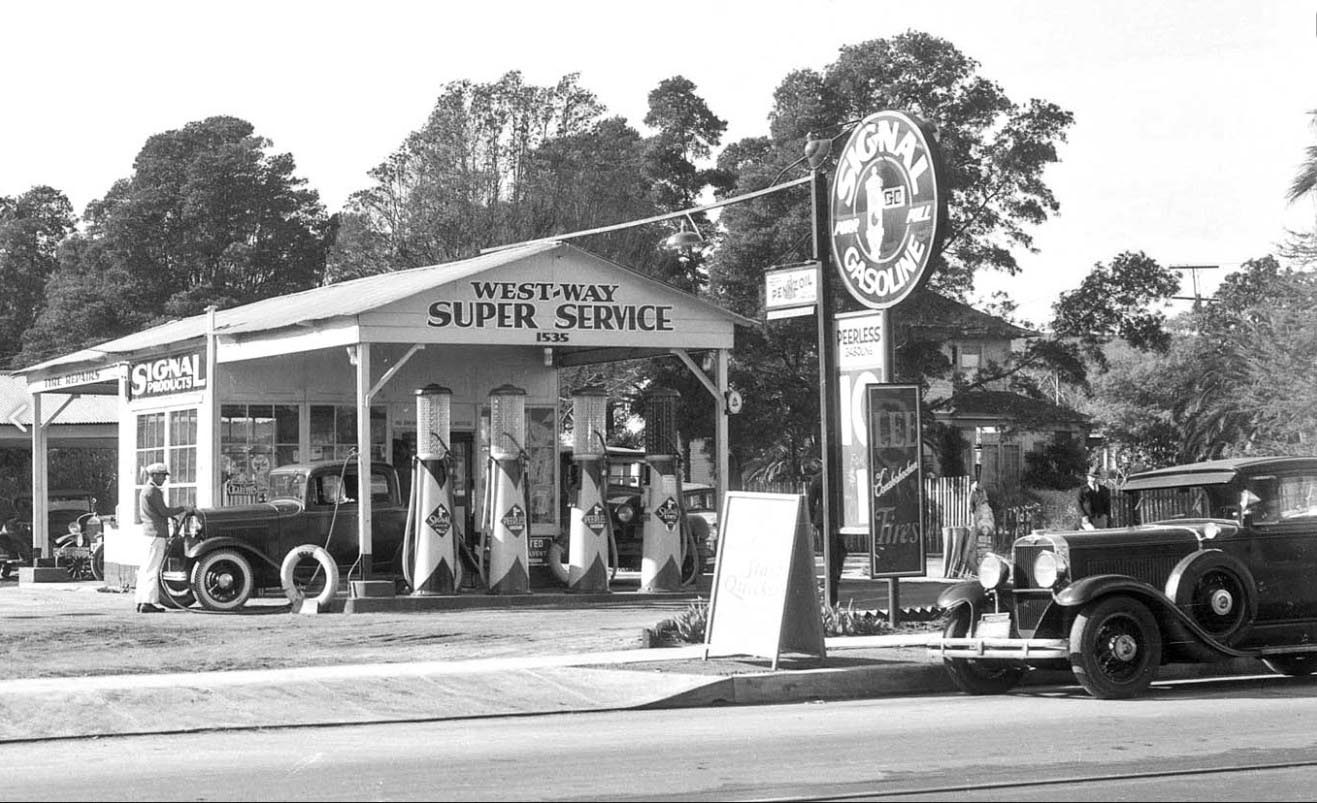 |
|
| (1933)^^ – View showing the West-Way Super Service Station located at on the southwest corner of Western Avenue and Harold Way in Hollywood. |
Historical Notes This gas station, located at 1535 N. Western Avenue, was initially run by the partnership of John A. Jordan and Milton E. Jaeckel. They previously were operating two gas stations at 5873 Hollywood Boulevard and 1353 N. Western Avenue. They opened this facility either in 1931 or 1932. The West-Way Super Service Station went out of business by sometime in 1936. ^++ |
.jpg) |
|
| (1933)^^ - Two attendants provide full service on a 1932 Ford V-8, five window coupe at the pump of the West-Way Super Service Station at 1535 N. Western Avenue. |
Historical Notes Three different types of gasoline where sold at the facility: Signal Ethyl Purr Pull, which was dyed purple, Signal Regular, and low-priced Signal Peerless that sold for ten gallons for a dollar. ^++ |
.jpg) |
|
| (1933)^^ - Close-up view showing the four pumps at the West-Way Super Service Station, dispensing three grades of Signal fuel. |
Click HERE to see more Early Views of LA Gas Stations |
* * * * * |
Please Support Our CauseWater and Power Associates, Inc. is a non-profit, public service organization dedicated to preserving historical records and photos. Your generosity allows us to continue to disseminate knowledge of the rich and diverse multicultural history of the greater Los Angeles area; to serve as a resource of historical information; and to assist in the preservation of the city's historic records.
|
More Historical Early Views
Newest Additions
Early LA Buildings and City Views
History of Water and Electricity in Los Angeles
* * * * * |
References and Credits
* LA Public Library Image Archive
^* California Historic Landmark Listing (Los Angeles)
^ California Historical Society Digital Archive
** Retronaut - Hollywoodland Sign
#^WhitleyHeights.org: Aerial of Cahuenga; Whitley Heights Aerial
#+LA Weekly: Laurel Canyon Country Store
***The Story of Hollywood by Gregory Paul Williams
^^^California State Library Image Archive
^**Huntington Digital Library Archive
**^Table Magazine: LA Observatory
**#Beguiling Hollywood: The Hollywood Hotel
^^#LA Times: Hollywood Citizens News Building; Marlboro Man Signboard; Mark C. Bloome
+^#Facebook.com: Hidden Los Angeles
^x*Facebook.com: So. Calif. Historic Arrchitecture
*#*Elvis Blog
#^^Hollywood Walk of Fame Historic Buildings
#++GoCalifornia.about.com: Sunset Strip
#^*Pinterest.com: Old Hollywood; Los Angeles
#^# DWP - LA Public Library Image Archive
##*The Daily Mirror: Garden Court Apartments
*^*MTA Transportation and Research Library Archives
*^^Nuestra Señora la Reina de los Ángeles - losangelespast.com
^^*Cinema Treasures: Vogue Theater; Pantages Theater; Iris Theatre; Marcal - World Theatre
*^*^YMCA Hollywood - paulwilliamspoject.org
*^^*Vintage Los Angeles: Facebook.com: Lucy/Holden; Villa Nova; Sunset Tower Apartments; Earl Carroll Revolving Stage; Schwabs Sunset; Player's Club
^*^^Pomona Public Library Poscard Collection
^^^^Water and Power Associates
^*^#Facebook.com - Bizzare Los Angeles
^^^#KCET: How the Town of Sherman Became West Hollywood; The Player's on the Sunset Strip; L.A.'s First Freeways
+++#Go-Go Notebook.com: Flipper's Roller Derby Palace
***^Pinterest.com: Bertrand Lacheze; Vintage Los Angeles: Sunset Strip; Trocadero Nightclub
^**^Griffith Observatory: laparks.org
**##MartinTurnbull.com: The Players; Hollywood-Western Building; Earl Carroll Theater; Sherry's Restaurant; Hollywood and Highland
+##+Restaurant-ing Through History: Ice Cream Parlors
^##*Flickr.com: Michael Ryerson; Bill Badzo
^#^^Facebook.com - Vintage LA: 1968 Sunset Strip; Yellow Submarine; 1984 Sunset Strip
^^#*Flickr.com: Elizabeth Fuller
*#*#Facebook.com - Great Photos from Los Angeles's Past: Players Nightclub
*^#*Calisphere: University of California Image Archive
*^^#Mt. Hollywood - Small Mountain, Big Dreams
*^##OAC - Online Archive of California
#**#Facebook.com: Garden of Allah Novels, Martin Turnbull
#*^#Historic Hollywood Theatres: Grauman's Chinese Theatre
#^**The Go Go's: Local Coffee Shops and Diners; PJ's Nightclub
#^^#The Rise and Fall of Dino's Lodge by Kliph Nesteroff
#^##ShareTV.com: 77 Sunset Strip
##^*Facebook.com: Classic Hollywood-Los Angeles-SFV
*###Google Maps
###*GoLosAngeles.abouttcom: History of the Sunset Strip
####Neatorama.com: Dean Martin and Jerry Lewis Restaurant Owners
#^#*Pinterest.com: Rock'n'Roll & Boogie Woogie
**^**Los Angeles City Historical Society
***^^Oldshowbiz.tmblr.com: Crescendo Club
***##Googie Architecture
**^^^Pinterest.com: Sunset Strip
*^^^^SeriousEats.com: Carneys Diner
*^*^*Blogspot.com: It's a wrap - USA/Mexico - Mel's Drive-In
*^#^*Vintage Everyday
*^*^^Crescendo GNP
^*^*^Go Los Angeles About.com: Sunset Strip
^***^Flickr.com: gsjansen
*^^^*RareMaps.com
^^*^*Los Angeles Magazine: Aquarius Theatre
^#*#^Private Los Angeles Tours: Ciro's Nightclub
^#^#^LA Curbed: Sunset's Tower Records
*#*#*wehoville.com: Tower Records
*# Skyscraperage.com. - Griffith Observatory; Elvis at Knickerbocker Hotel; Gruen Sign; Garden Court Apartments; Mt. Hollywood; Ben-Hur Coffee; Sherry's Restaurant; Griffith Observatory; Sunset Strip 1960s; Cahunega and Highland Intersection ca1937; Googie's; Selma and Argyle; Sunset Medical Building; Ravenswood Apartments
*^ Wikipedia: Hollywood; Hollywood Athletic Club; Hollywood Bowl; Grauman's Chinese Theatre; Grauman's Egyptian Theatre; Pantages Theatre (Hollywood); John Hanson Ford Theatre; 20th Century Fox; Samuel Goldwyn.Studio; Barnsdall Art Park; Greek Theatre; Griffith Observatory; Cinerama Dome; Ralphs; Hollywood Palladium; Hollywood and Vine; Hollywood Masonic Temple; Hollywood Pacific Theatre; Max Factor; West Hollywood; Brown Derby; Hollywood Christmas Parade; The Hollywood Hotel; Cord Automobile: Sunset Tower; West Coast Radio City - Los Angeles; Earl Carroll Theater; Cafe Trocadero; Breakfast in Hollywood; Whitley Heights; Hollywood Christmas Parade; Garden Court Apartments; Chili Bowl Restaurant - Art Whizin; The Hillview; Paramount Studios; Hollywood Freeway; Hollywood Roosevelt Hotel; J. J. Newberry; Claudette Colbert; Whisky A Go-Go; Gazzari's; The Whtie Parade; The Troubador; Starwood Club; Hollywood Post Office; Chubby Checker; Decoration Day; 77 Sunset Strip; Chateau Marmont Hotel; The Doors; The Comedy Store; Ciro's Nightclub; The Ravenswood; Googie Architecture; Charlie Chaplin; Doheny Drive; Shirley Temple
< Back
Menu
- Home
- Mission
- Museum
- Major Efforts
- Recent Newsletters
- Historical Op Ed Pieces
- Board Officers and Directors
- Mulholland/McCarthy Service Awards
- Positions on Owens Valley and the City of Los Angeles Issues
- Legislative Positions on
Water Issues
- Legislative Positions on
Energy Issues
- Membership
- Contact Us
- Search Index